WILD LIFE



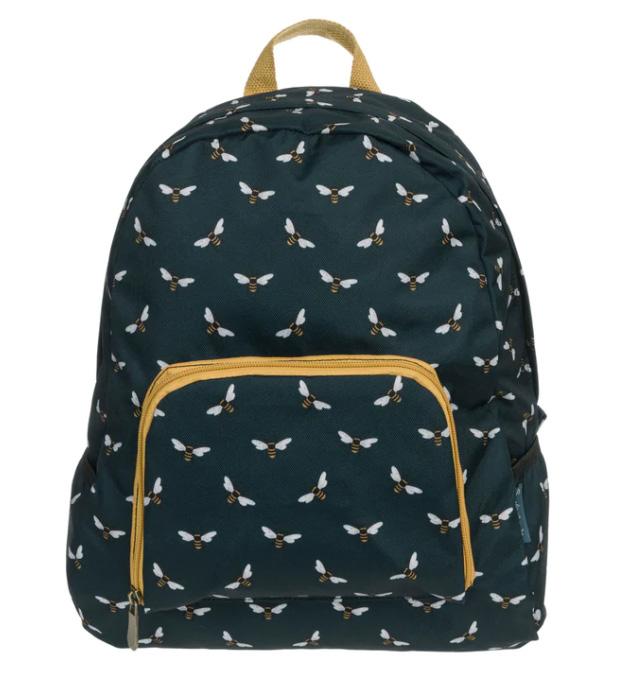
This festive season, give a gift that gives back to nature. From memberships to jewellery – our eco-friendly gifts make perfect stocking fillers for your animal-loving friends and family.
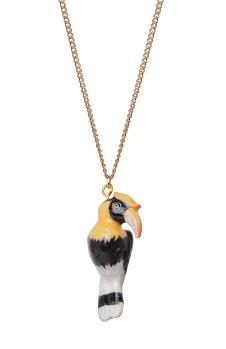
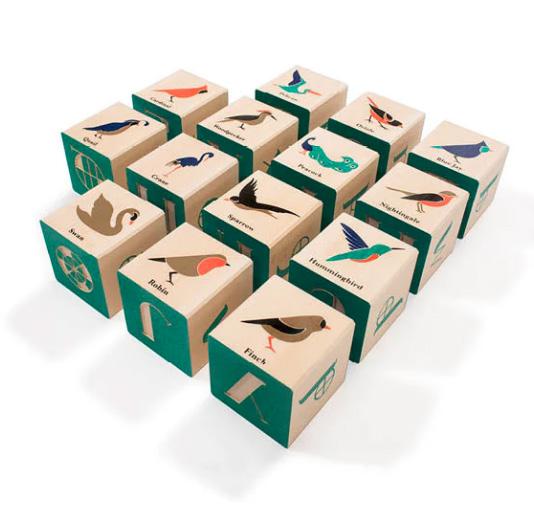
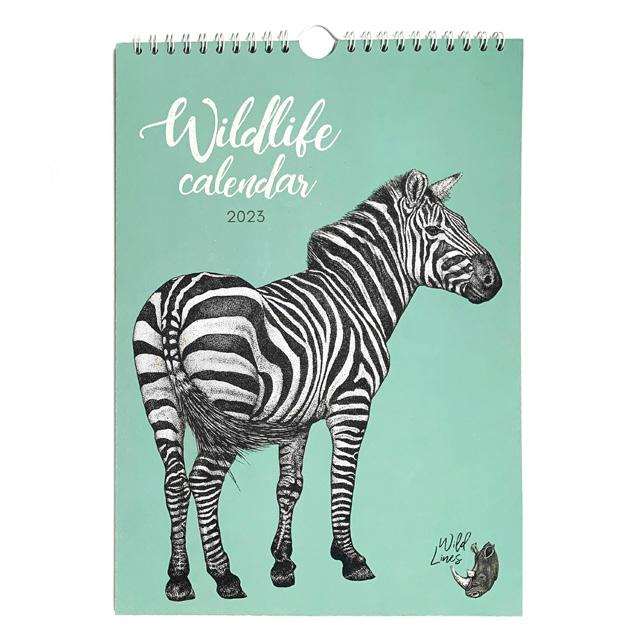

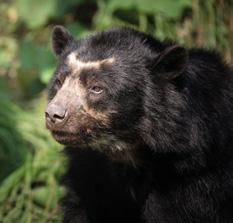
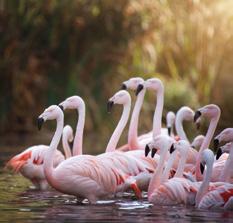

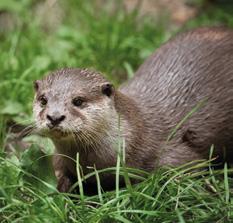
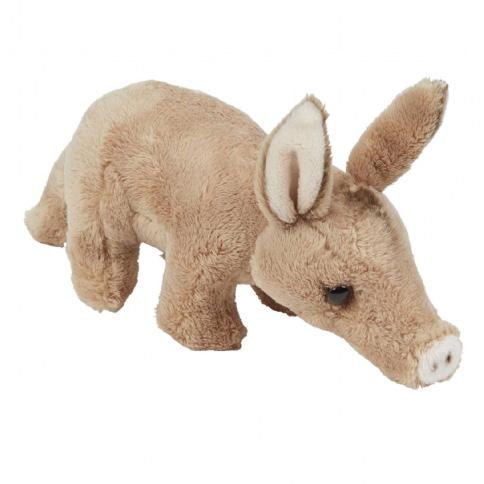

Gerry knew that most zoos prefer to display “box-office” species – big, popular animals such as tigers and elephants – but he felt that more obscure species were not receiving the conservation attention they needed and deserved from zoos. He often said that every animal species had a right to exist and an ecological role to play, whether or not they were cute, cuddly or charismatic. So began our focus on “LBJs” or “Little brown jobs”, which is a favourite expression of birdwatchers, meaning small, drab birds difficult to identify. It became a handy phrase at Jersey Zoo to describe the animals that Gerald Durrell was intent on saving.
In the early days these included the volcano rabbit from Mexico and the hutia from Jamaica – both small and brown – and we continue the emphasis today, helping such species as the Saint Lucia racer snake and the giant jumping rat of Madagascar. Snakes and rats are not most people’s cup of tea, but Gerry and his team loved them, and they are important to their ecosystems.
Other species you’ll read about in this issue of Wild Life are the stars of long-term Durrell
conservation breeding programmes, such as the black lion tamarin of Brazil and the pygmy hog of Assam, both charismatic and appealing, in spite of their diminutive stature.
Durrell has a long history of working with tortoises. They are well-loved and some could even be called “box-office”, like the impressive Aldabra tortoises we have released on Round Island to fill the ecological role of giant herbivore. It’s wonderful news that our next sculpture trail, following on from the success of Go Wild Gorillas , will feature tortoises. Tortoise Takeover will dominate Jersey’s landscape next summer, and funds raised will go towards a much-needed Reptile and Amphibian House to replace the current building, now nearly 50 years old.
Zooming out to our conservation “bigger picture”, this issue also features the successes we’ve had with the Rewild Carbon programme. This is so much more than a simple carbon offset scheme. It allows participants to help Durrell rewild habitats and nurture the biodiversity contained within them, most of which consists of LBJs, of course!
It is important to us that we keep you informed about our work, and the difference we are making to the many species, habitats and local communities with which we work.
If your household has received more than one copy of Wild Life and you would like to discuss your mailing preferences going forward, please don’t hesitate to contact a member of our Supporter Care team on supportercare@durrell.org or (0)1534 860111
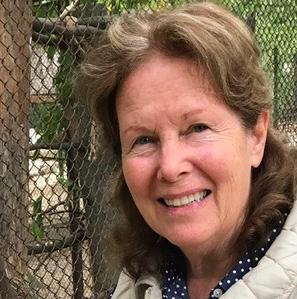
If you’d like to hear from us regularly subscribe to our email newsletter at www.durrell.org
Wild Life is printed on paper that is certified FSC® Mix Grade with fibre coming from responsible sources and can be fully recycled. Your copy of the magazine is sent to you in a fully compostable wrap.
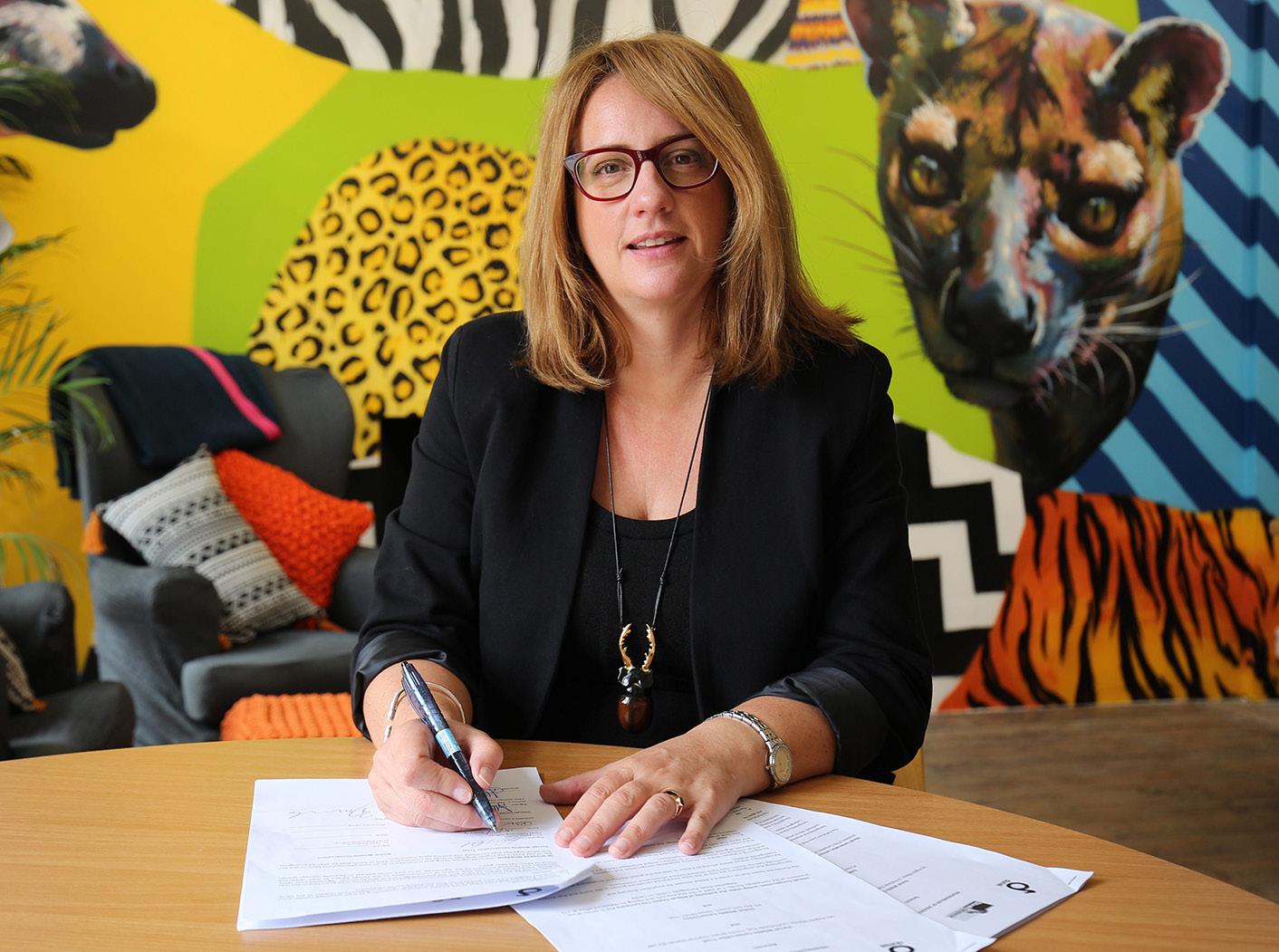
Durrell stands out in the conservation and zoo world for several reasons. Firstly, our complete dedication to our mission of saving species from extinction runs through everything we do. We also spend a higher percentage of our income on conservation than any zoo-linked organisation in the world. More unusual still, is that we preferentially care for and conserve the little species, that Gerald Durrell, our Founder, called the ‘little brown jobs.’ These are the smallbodied animals that are somewhat overlooked in public imagination and media, as wildlife programmes often have a preponderance for spotlighting the larger species on our planet.
That is understandable to some extent. Largebodied animals such as elephants, whales, or giant pandas, are so, well, obvious! Or take big cats, which carry an aura of risk for us humans with our poor defences against their finely honed adaptations to predation, and so we have a morbid fascination for what might devour us.
However, biodiversity does not depend solely on those at the top of the food chains, but rather it is the mix of all life. Each species must play a key
part for nature to be in balance. The disruption of functioning ecosystems is leading to profound imbalances and creating problems not only for the species we share the planet with, but for us too. A world where we remove habitats and introduce pesticides that ravage our pollinator populations is a world that will be unable to sustain people, as most of our crop species are pollinated by animals. Seeds that are dispersed by animals build rainforests that help regulate the temperature and rainfall of our planet, yet these rainforests are being fragmented and destroyed. In turn, the viruses that are locked up in the core of these rainforests are being thrown into perilous proximity to humanity. Earth is a complex system, where there is balance between every living species. Our actions are tampering with that equilibrium.
And so, we, at Durrell, are champions for the little ones, the small animals that might go unnoticed or deemed less important yet play their vital role in the ecosystems they inhabit. Take the tiny Telfair’s skink. Once widely found across Mauritius it had become restricted to Round Island. Without the interventions of Durrell, it might now be extinct. These tiny, tough, charismatic creatures feed on small invertebrates,
reminding us that being a predator is not solely the preserve of large carnivores. These skinks help regulate insect populations, also feeding on fruits and spreading seeds, helping to continually support the habitat that supports them, bringing to the fore the cycle of life. We have now translocated the tiny Telfair’s to two other islands to the north of Mauritius, building a safety net population.
At the zoo we recently received a small number of Fregate beetles, and you can see them in the visitor centre. With their rounded, and bumpy carapace, these are unusual looking beetles that were thought to be endemic to Fregate Island in the Seychelles. Work by our Chief Scientist, Professor Carl Jones, and collaborators has identified that the Fregate beetle was also found on Round Island. The almost complete destruction of the palm rich habitat from the 1800s led to their demise. If we can successfully breed the beetles in Jersey, we have a chance to consider their return to Round Island, filling in another piece of the puzzle of how to rebuild a damaged ecosystem. It is also a reminder that some habitats, particularly islands, are regulated by assemblages of species made up of insects, reptiles, and birds, with mammals simply not part of the equation.
When it comes to mammals, again at Durrell, we often focus on the small species, such as giant jumping rats in Madagascar or pygmy hogs in Assam. These species are often overlooked as they perhaps suffer from some
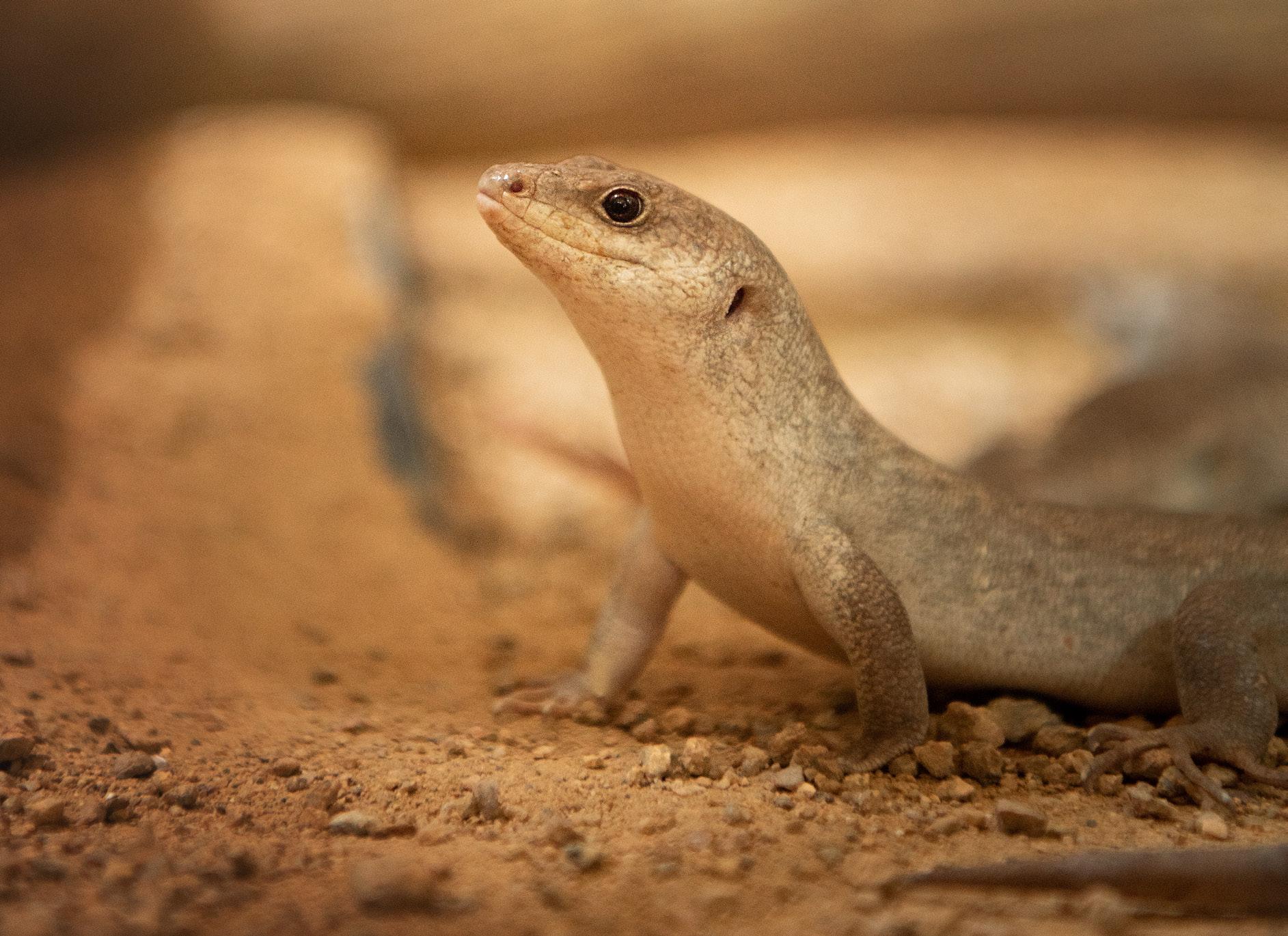
‘bad press.’ Jumping rats generally sound unappealing, as a rat is often a pejorative term. However, rats are in fact a highly successful group of small, bodied animals, that are often the ultimate survivors, by continuing to adapt in our urban world. Rats have long been blamed for the black death that decimated the human population of Europe, leaving a lasting stain on their reputation. Yet recent studies have shown that rats were not to blame for this plague, but the reality is that rats have a bad reputation! The jumping rats are beautiful little animals, with large eyes and resplendent ears, used for navigating their way in the dark. However, they are facing huge threats in the wild. Unlike their city cousins, jumping rats are sensitive to disturbance in their western dry forest home, which is fast receding due to fires and tree felling. It is sometimes more challenging to raise the funds needed to protect a ‘rat,’ but these beautiful little animals are so important. They are seed dispersers and they aerate the soil with their extensive burrowing. They are also a prey item for species like the fossa, the largest carnivore of Madagascar, which is also under threat.
The truth is, we need all parts of our jigsaw to see the full picture. Sometimes it is hard to know what the vital missing piece is until it is too late and so at Durrell, we target the species where others might not focus. Every animal needs a champion, big or small and at Durrell we champion the small. I will leave the final word to our Honorary Fellow, Sir David Attenborough, someone who via his TV programmes has also tried to champion the little creatures.
“It is that range of biodiversity that we must care forthe whole thingrather than just one or two stars.”
SIR DAVID ATTENBOROUGH
Behind closed doors at Jersey Zoo, we’ve been busy, and agile too! The agile frog population has been declining since the early 1900s, and today, Jersey is the only remaining place in the British Isles where the species can be found. At Durrell, we first started working with the agile frog in 2000 and breed them in captivity onsite at the zoo. In partnership with the Government of Jersey, we head-start the spawn to give them a better chance of survival, and then we release them as mature tadpoles into a secure, wild habitat. We’ve been head-starting the agile frog tadpoles since 2006 and have released nearly 63,000 tadpoles into the wilds of Jersey. A continued “leap” in the right direction, in 2022 we released 4,554 tadpoles!
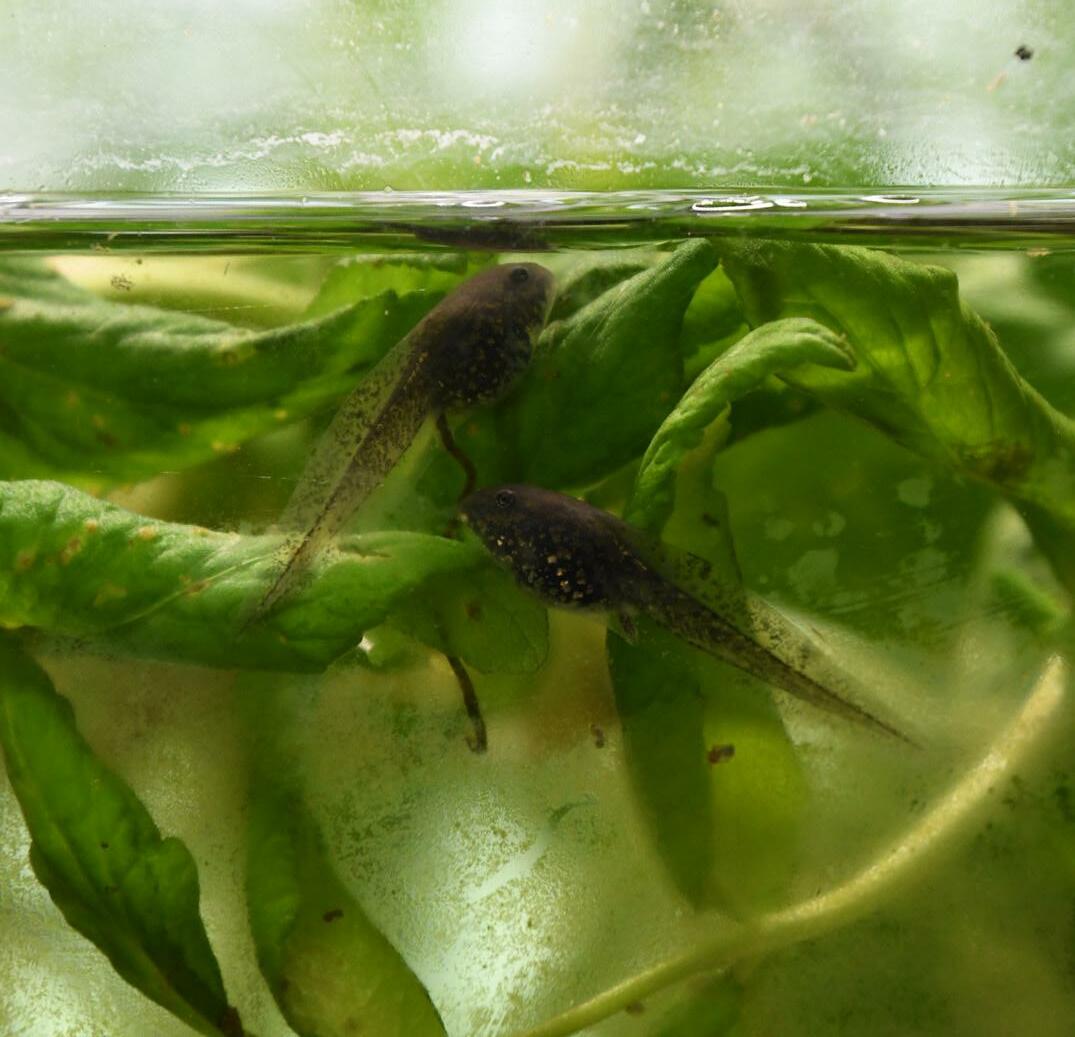
In June, we were delighted to welcome Countryfile for an exclusive visit to Jersey Zoo. When Matt Baker and Charlotte Smith visited Jersey for this special episode of the BBC One series, which aired on Sunday 3 July, Matt explored a range of Durrell projects.
In May, we opened our brand-new gift shop in the departures lounge of Jersey Airport. Ports of Jersey continue to make travel greener through their partnership with Durrell, including this new expansion that promotes eco-friendly products. Make sure you pop in to see our range of toys, games, hoodies, homeware and more! Our airport staff would love to help you kickstart your holiday mood.
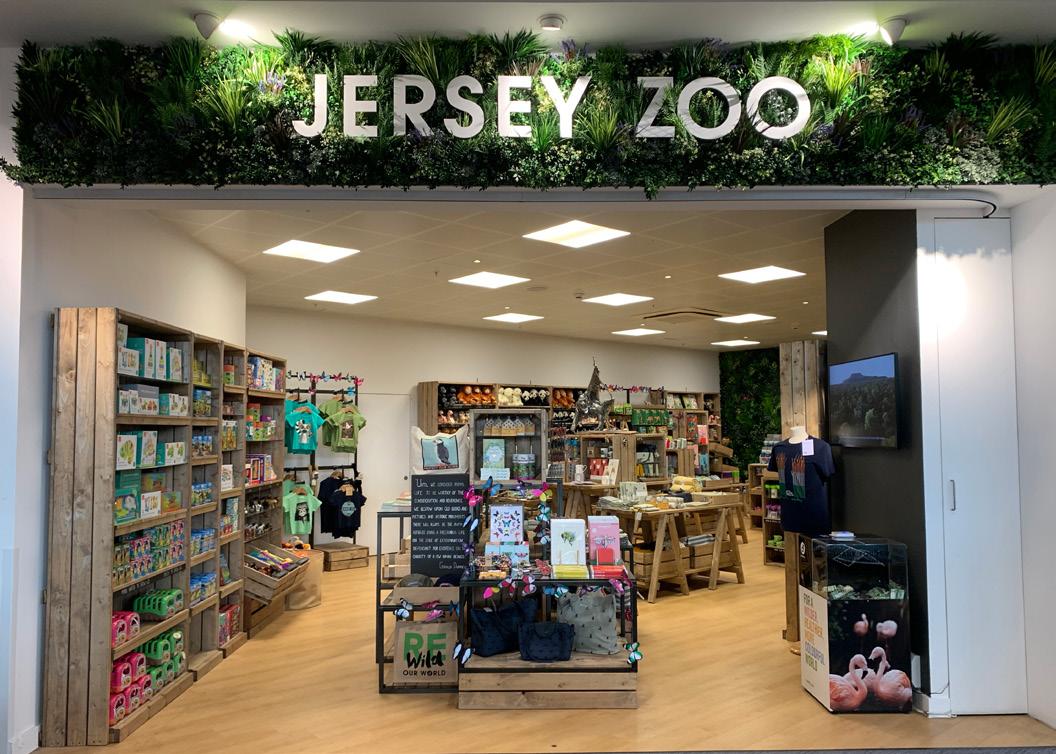
Professor Carl Jones, Chief Scientist at Durrell and renowned conservationist, sat down to talk about endangered species recovery missions such as the pink pigeon, and his own 42 years working in Mauritius. They also visited the agile frog programme, and Matt helped the team lay our unique fertiliser on the organic farm. The episode commences with the celebrity hosts venturing out with our own local celebrities, the golden Guernsey goats! The episode was a fantastic opportunity to raise awareness of our diverse programmes that go far beyond caring for our animals within the zoo, and Matt certainly starstruck a few of our visitors in the meantime.
The Countryfile episode “Jersey 1” is still available to watch on BBC iPlayer.
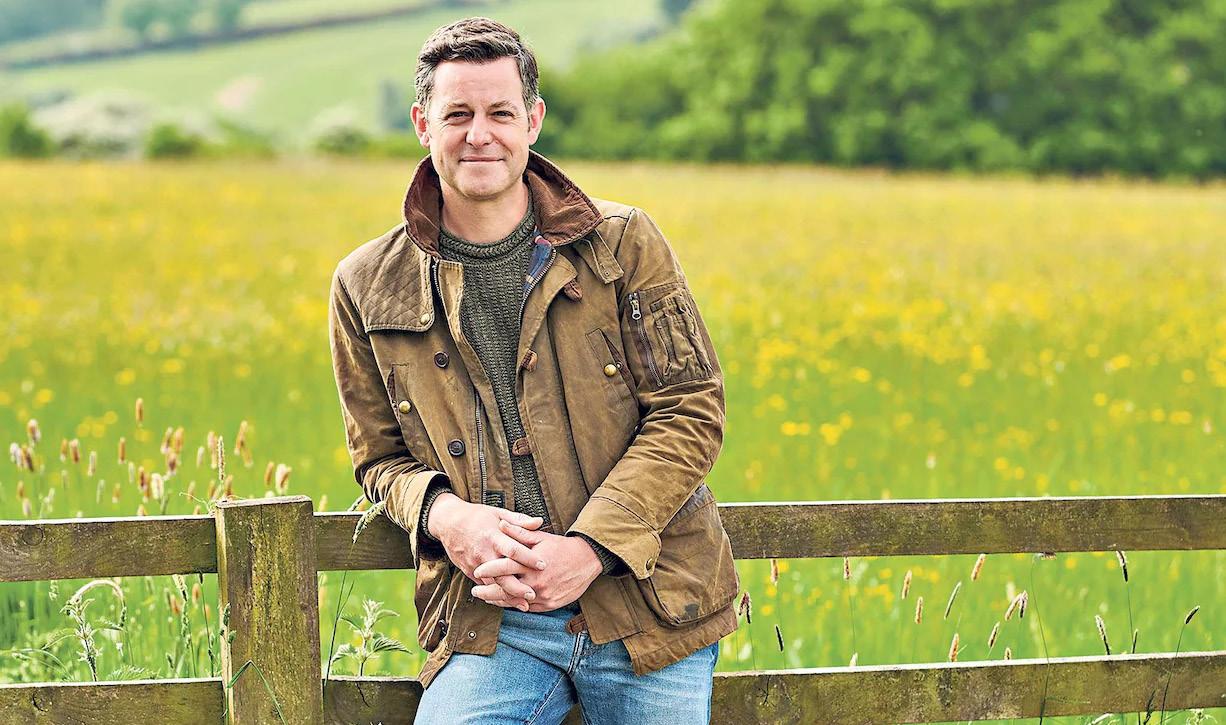
Our breeding programme for the critically endangered Livingstone’s fruit bat has been phenomenally successful this year. For this friendly fruit bat, every birth counts, as there’s only an estimated 1,000 left in the wild. We care for a safety-net population of the species, housing 98% of the world’s captive individuals. Overall, Jersey Zoo holds approximately 10% of the species’ global population. When you’re working with delicate statistics like these, a single pup is worth celebrating. But at the zoo this year, we’re thrilled to have had a record-breaking 16 healthy pups born and now living in the bat roost! Soon they’ll be microchipped and named, and will become permanent members of the ever-expanding colony here at the zoo.
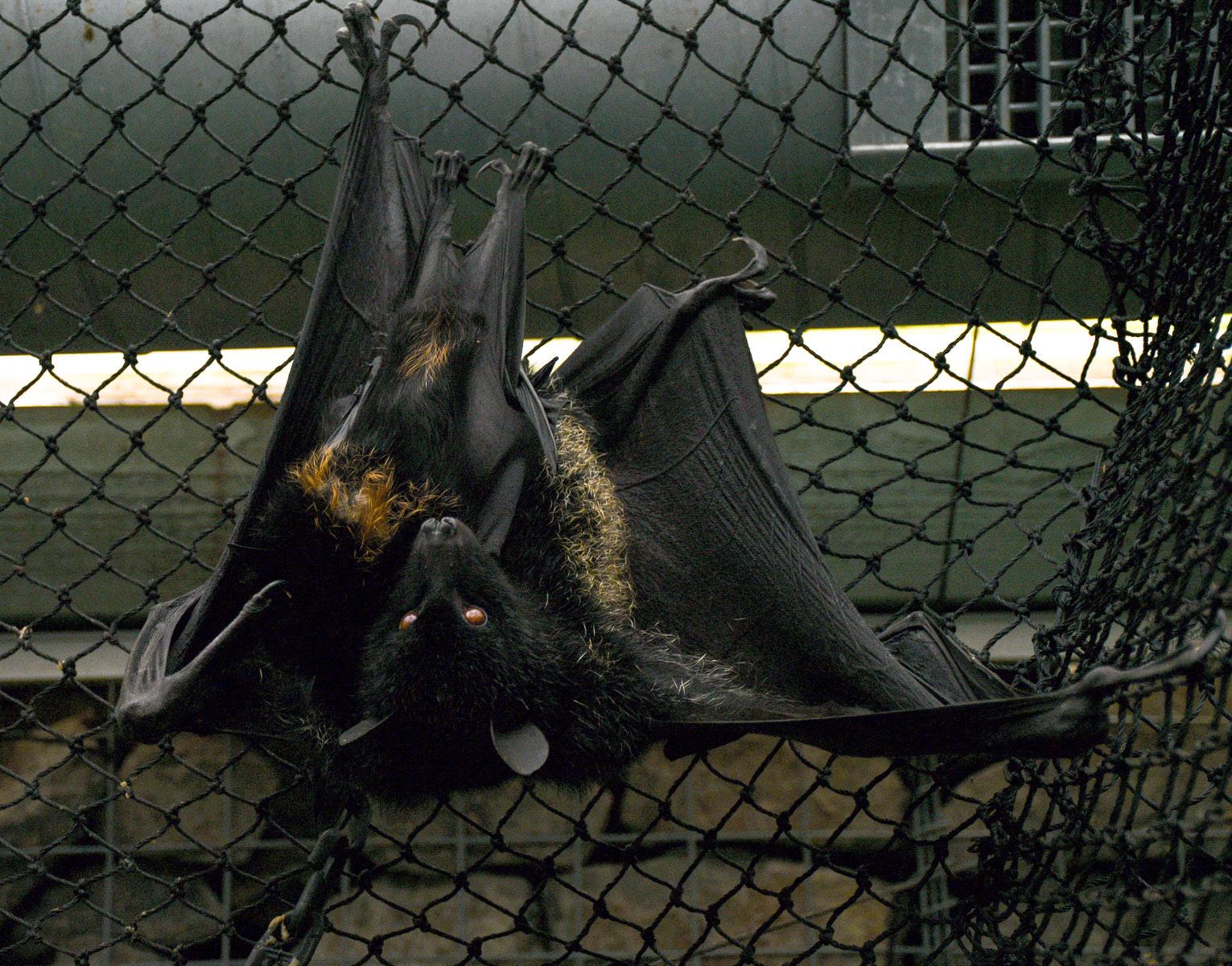
In June, it was with a heavy heart that we said goodbye to our muchloved Sumatran orangutan, Kea, as she left for her new home in Germany. At nine years old, Kea had reached the age where wild orangutans would usually leave their mothers, so she moved to Dortmund Zoo to start the next chapter of her life. Since Kea’s “miracle birth” in 2013, she had been an adored member of our orangutan family, and her cheeky and inquisitive personality was enjoyed by both staff and visitors alike. Five months on and we’re pleased to hear that Kea has settled in well at Dortmund Zoo, befriending another young orangutan called Yenko, who has the exact same birthday as her! The pair are said to be near inseparable and she remains very open-minded and interested in her new home.
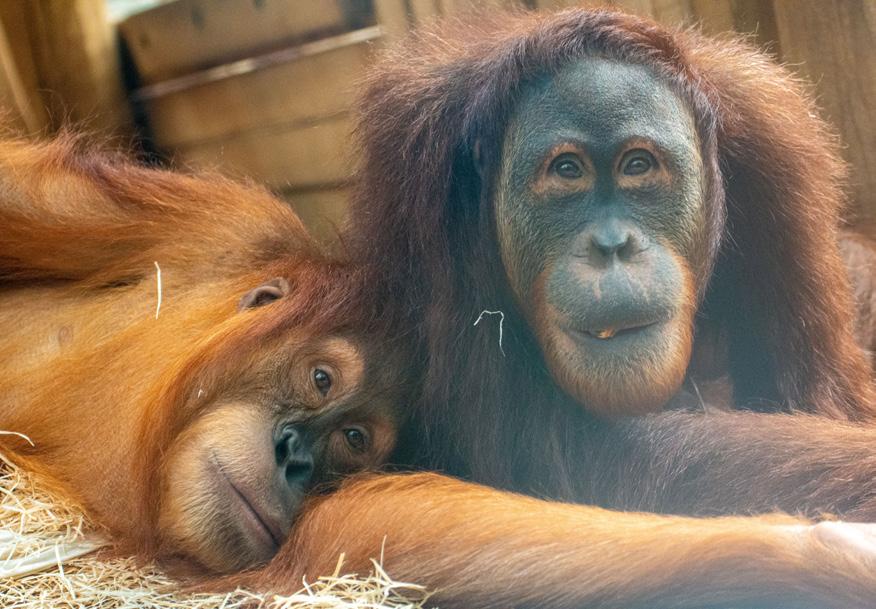
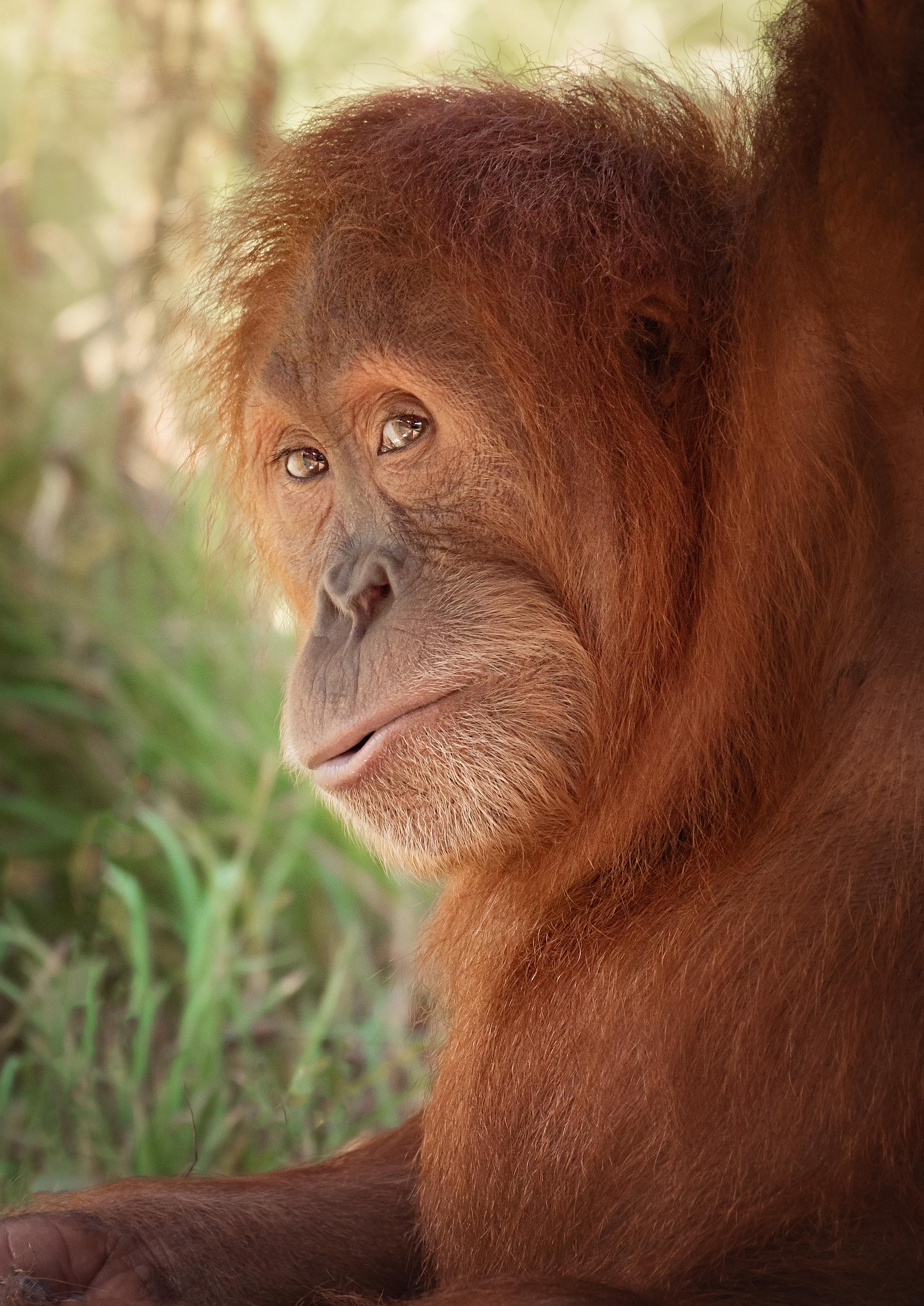
Third time’s a charm for the world’s rarest duck! The Madagascar pochard was thought to be extinct for 15 years, up until 2006 when it was remarkably rediscovered. To give this species a fighting chance, a breeding programme was set up and Lake Sofia was chosen as a suitable release site. After two successful releases in 2018 and 2021, a total of 56 pochards were reintroduced to the wild. This year, between August and October Durrell and partners in Madagascar welcomed the third crowd. Another remarkable 55 captive-bred birds have been released onto Lake Sofia. The ducks were transported via a 10-hour drive on dirt roads and then cared for in a lakeside aviary before being released. This gradual technique gently prepares the pochards for their wild release onto the lake. A grand total of 111 ducks have now been reintroduced to the wild, giving hope for the future of the critically endangered Madagascar pochard.
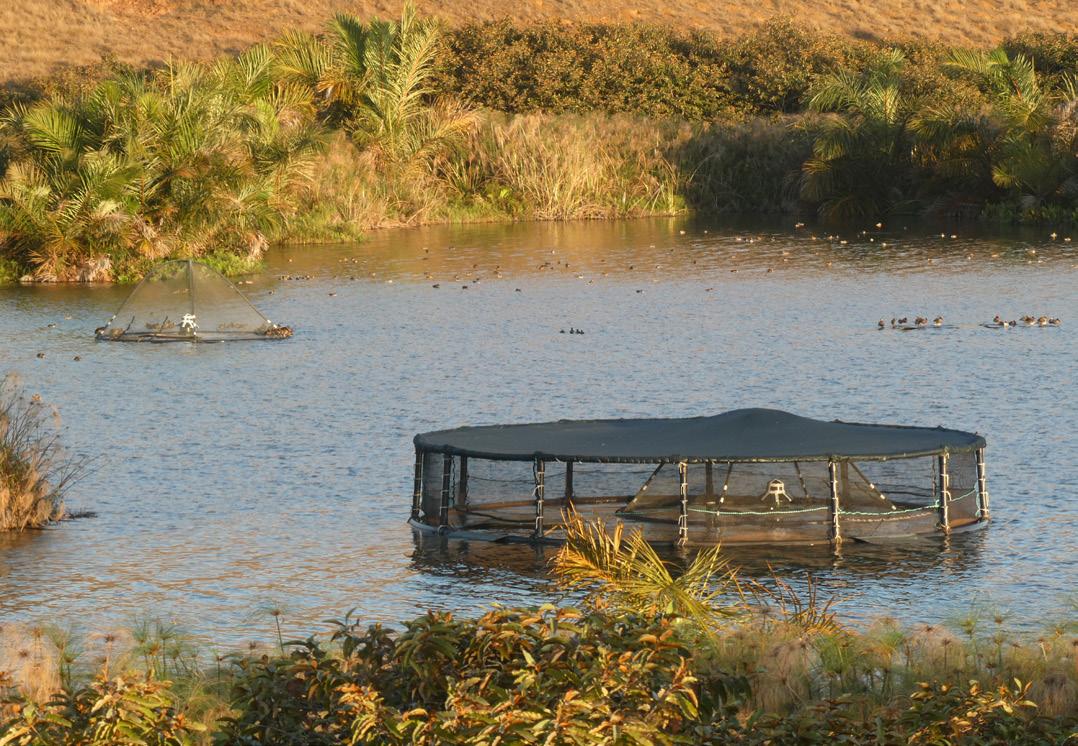
In June 2022, the Pygmy Hog Conservation Programme (PHCP) opened the gates for 10 captive-bred pygmy hogs, marking their third release into Manas National Park of Assam in India.
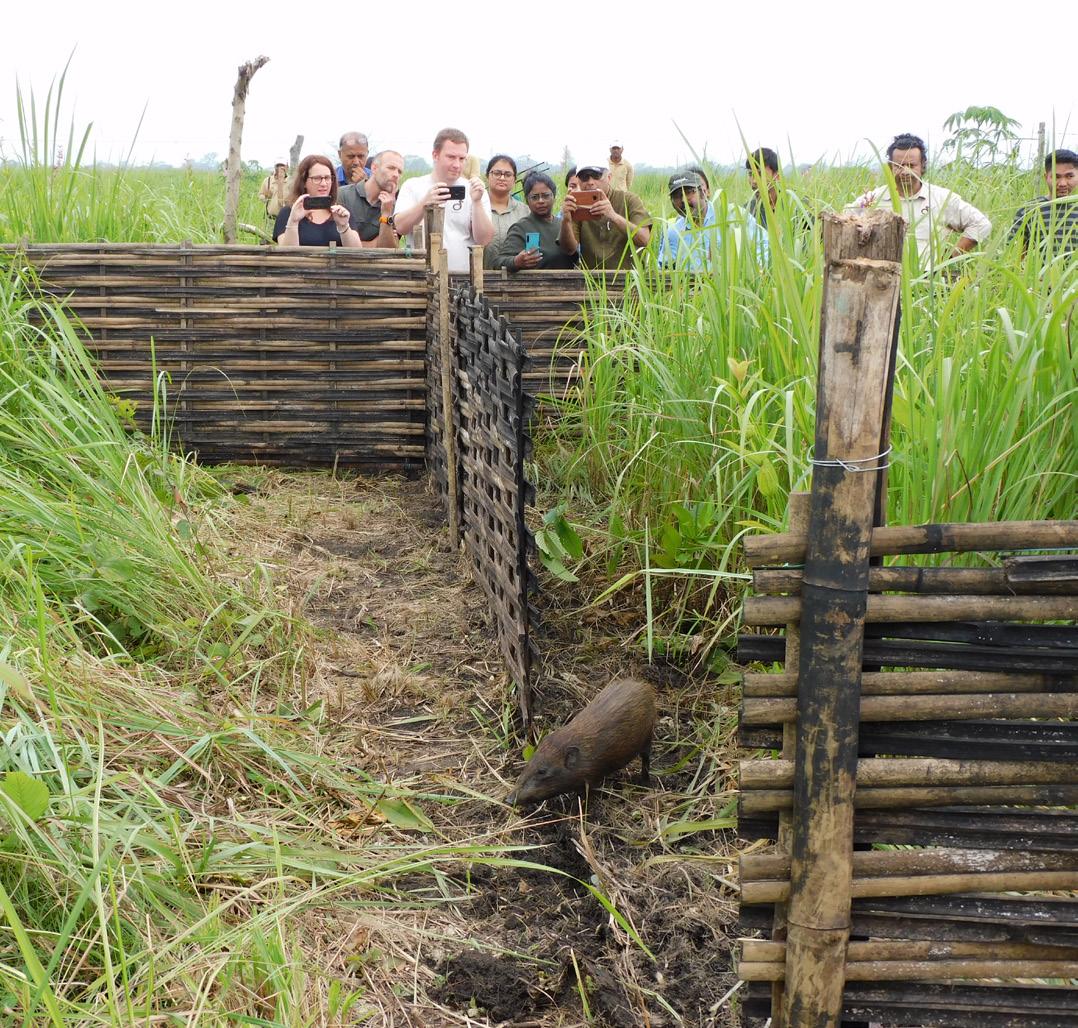
The world’s smallest pig, native to the tall grasslands of the southern Himalayan foothills, was feared extinct until a group that was sheltering from a grassland fire was discovered in 1971. There are only an estimated 250 wild pygmy hogs, meaning every precious piglet counts. The team have now successfully reintroduced a total 152 hogs back to the wild since the first release in 1996. Durrell has been working as part of the PHCP to protect the Himalayan grasslands and recover the pygmy hog population in Assam. With each promising release, we grow more optimistic for the future of this vulnerable species.
In August, a record-breaking 37 white storks were released at the Knepp Estate in West Sussex, the heart of the White Stork Project. The juveniles were introduced to the countryside in late summer with the hope that these migratory birds would travel south for the winter to either West Africa or South Africa. The project aims to have 50 breeding pairs by 2030, to help restore the species to the UK. We are part of this pioneering partnership of private landowners and conservation charities, whose success can be measured by the 20 chicks born in Sussex as a result of the programme. There have been more than 2,000 sightings of white storks since releases began in 2019. These encounters were across a range of countries including the UK, France, Spain, Germany and the Netherlands, showing exciting flight patterns and distances during the storks’ migration.
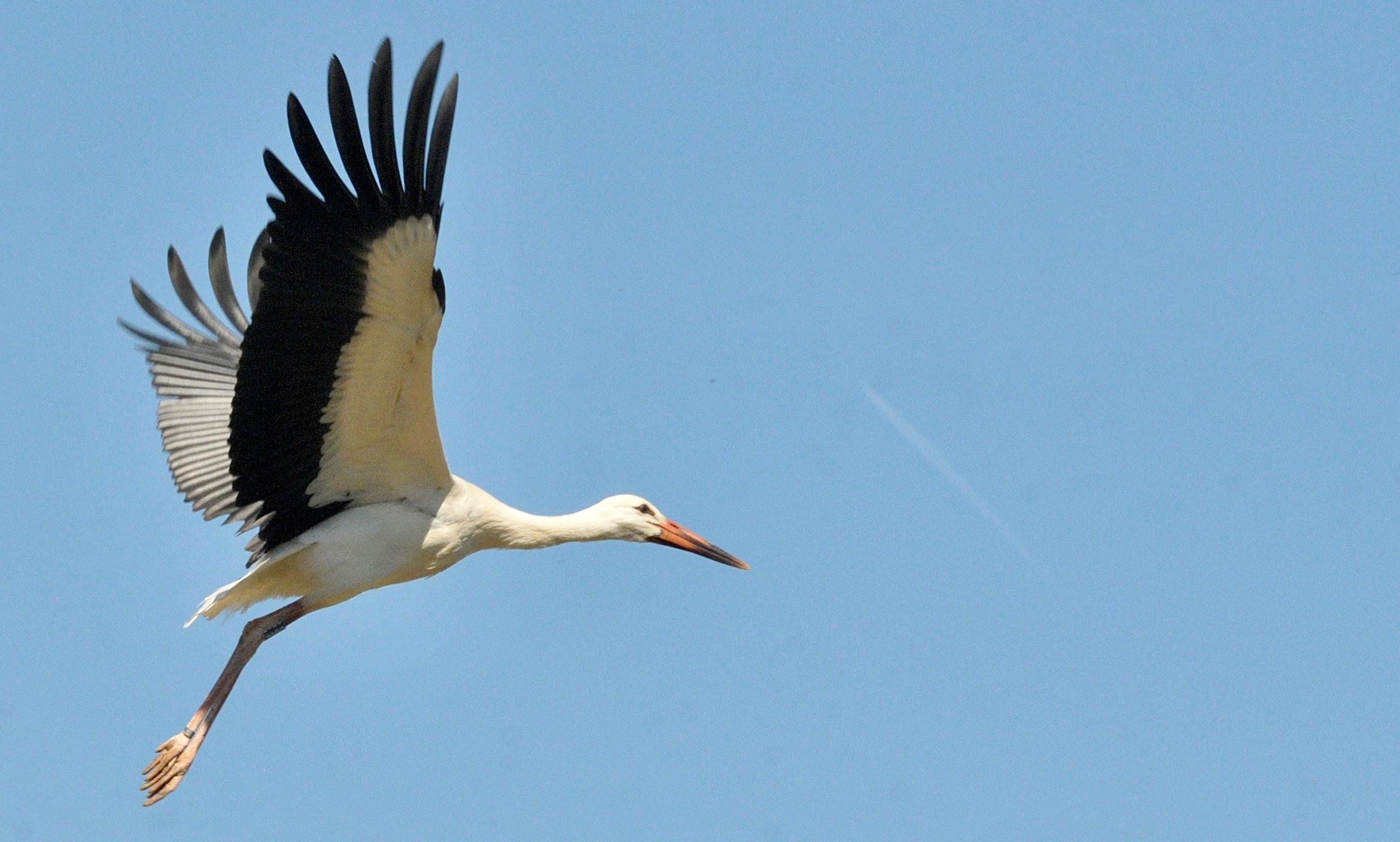
In the latest IUCN Red List report, the Malagasy giant jumping rat has been declared “Critically Endangered”. Locally known as vositse, this Madagascar-native has been under pressure from habitat loss, degradation and fragmentation, as well as lesser threats like feral pets and viruses. Unfortunately, after years of decline, the only remaining species of the jumping rat genus has now been moved to a higher threat level from “Endangered” to “Critically Endangered”. Durrell first became involved with the conservation of the Malagasy giant jumping rat in the 1990s, and now houses a population at Jersey Zoo. Fossil evidence suggests that the jumping rat once extended far south, but they have been severely reduced to only two isolated areas on Madagascar’s west coast. In 2017, 12,000 hectares of forest was lost in a single year, which is more than 12% of the remaining forest in the park. If this trend of deforestation continues, we’re predicted to lose the species in a matter of years. Durrell is a proud partner of the IUCN SSC Small Mammal Specialist Group, which is working hard to prevent losing these dynamic forestdwellers forever.
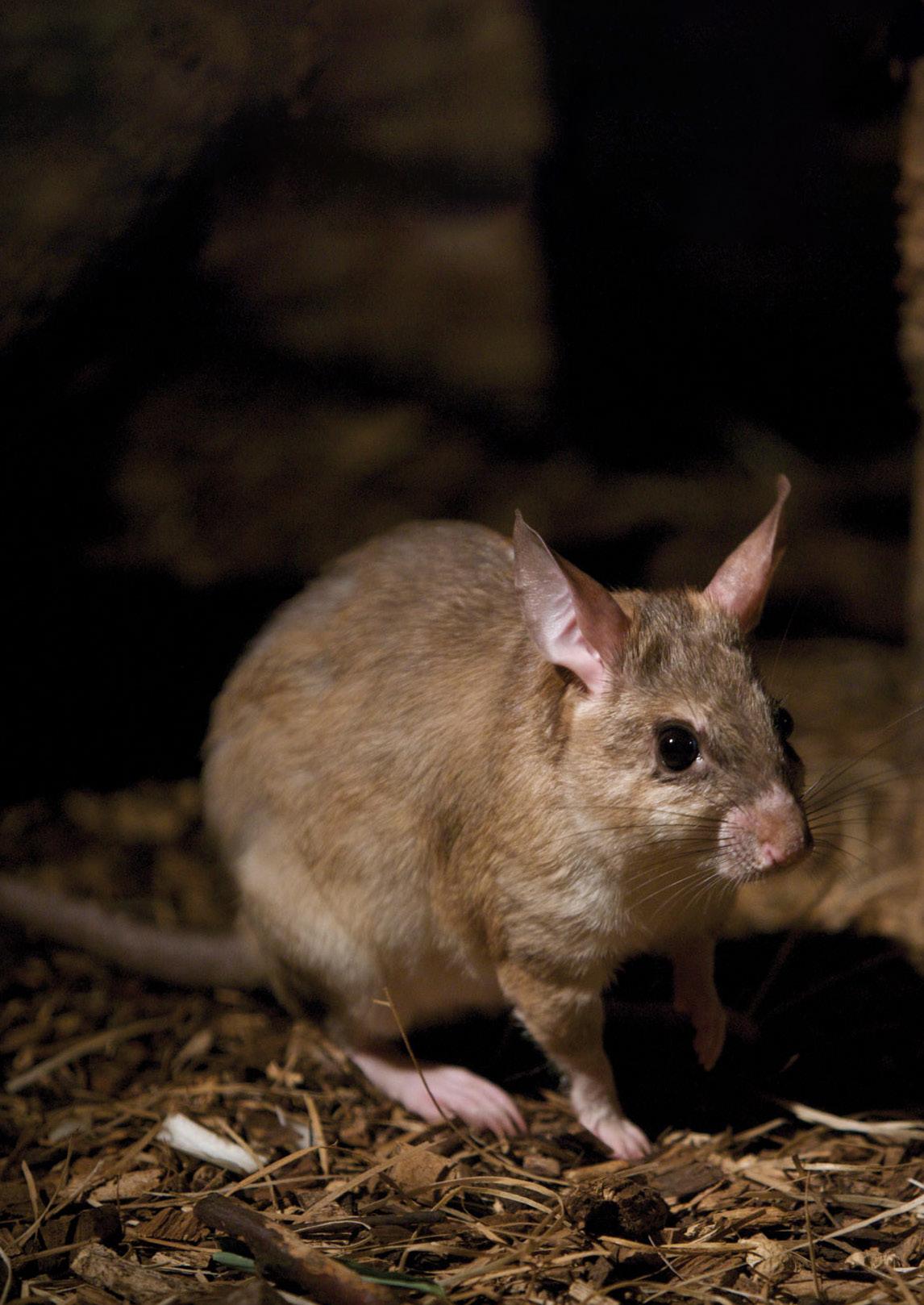
Saphira Hunt is the Caribbean Programme Officer for Durrell in Saint Lucia. Saphira supports the development and delivery of our projects on the island, focusing on the conservation of several highly threatened species, including the world’s rarest snake, the Saint Lucia racer. In this interview, Saphira tells us about her journey towards a career in conservation and her work with some of the Caribbean’s most endangered wildlife.
What led you to a career in wildlife conservation? When I became a mother, I took some time off from my job as a bartender and then started volunteering with the Forestry Department conducting wetland bird surveys. An opening came up at the Saint Lucia National Trust (SLNT) for a Field Monitor to work on the offshore islands conducting biosecurity monitoring, migratory bird surveys, whiptail lizard surveys and visitor tours to Maria Islands Nature Reserve. As luck would have it, the supervisor for the wetland bird survey team was on the interview panel, and I was offered the job. Since then, I’ve delved deeper and deeper into wildlife conservation and there’s no turning back!.
Tell us about your role at Durrell and what you did before working here. Before starting my role at Durrell, I worked for the SLNT as a Programme Assistant in the Conservation Department. There, I assisted with the development and implementation of the Southern Work Programme, which involved managing tour bookings, species surveys, invasive plant eradications and activities related to managing a Marine Protected Area. Fast forward a few years and I was seconded to Durrell for two days a week as the Saint Lucia Project Officer to manage ongoing field projects. This involved organising teams for field surveys and carrying out the field component of the projects. Now, I work full-time for Durrell as the Caribbean Programme Officer in Saint Lucia, where I focus on the delivery of projects for key species such as the Saint Lucia racer, white-breasted thrasher, Saint Lucia iguana and Saint Lucia whiptail lizard, which are under threat due to predation by invasive species and habitat loss. I also work on outreach and education initiatives within the local community to raise awareness of the island’s threatened wildlife.
What has been your most memorable moment since working at Durrell? It’s been said that hard work is never forgotten, and I can say that working on predator control and nest monitoring for the white-breasted thrasher, a highly threatened songbird found only on Saint Lucia and Martinique, is by far my most memorable moment. Being out in the field come rain or shine for eight months was definitely a huge undertaking. We picked mangoes to eat along the way, watched out for the venomous Fer-deLance snake, and were given fresh produce by local farmers, all while praying and hoping the chiggers (mites) didn’t bite you!
What do you enjoy most about your work and what is the most challenging part? I love that I spend most of my time outdoors and I’m not bound to a desk. I love the flexibility of earlymorning workdays or mid-afternoon wildlife surveys. The most challenging part is the people component. As one can imagine, interacting with different communities where our projects are based and working alongside partner agencies on the ground can have its ups and downs, but all in all, we get the job done while keeping everyone involved and updated.
What are your hopes for the future of Saint Lucia’s wildlife? My hope is that, together alongside our partners, we can work towards protecting and reviving native and endangered wildlife, not only on Saint Lucia but on the rest of the Caribbean islands too. I also hope to see a change in behaviour among the general public towards saving the islands’ threatened species, so that we won’t have to see these incredibly rare species disappear forever.

Up to 50 giant tortoise sculptures will take over Jersey during the summer of 2023, acting as ambassadors for the conservation work Durrell carries out with tortoises and other reptiles around the world.

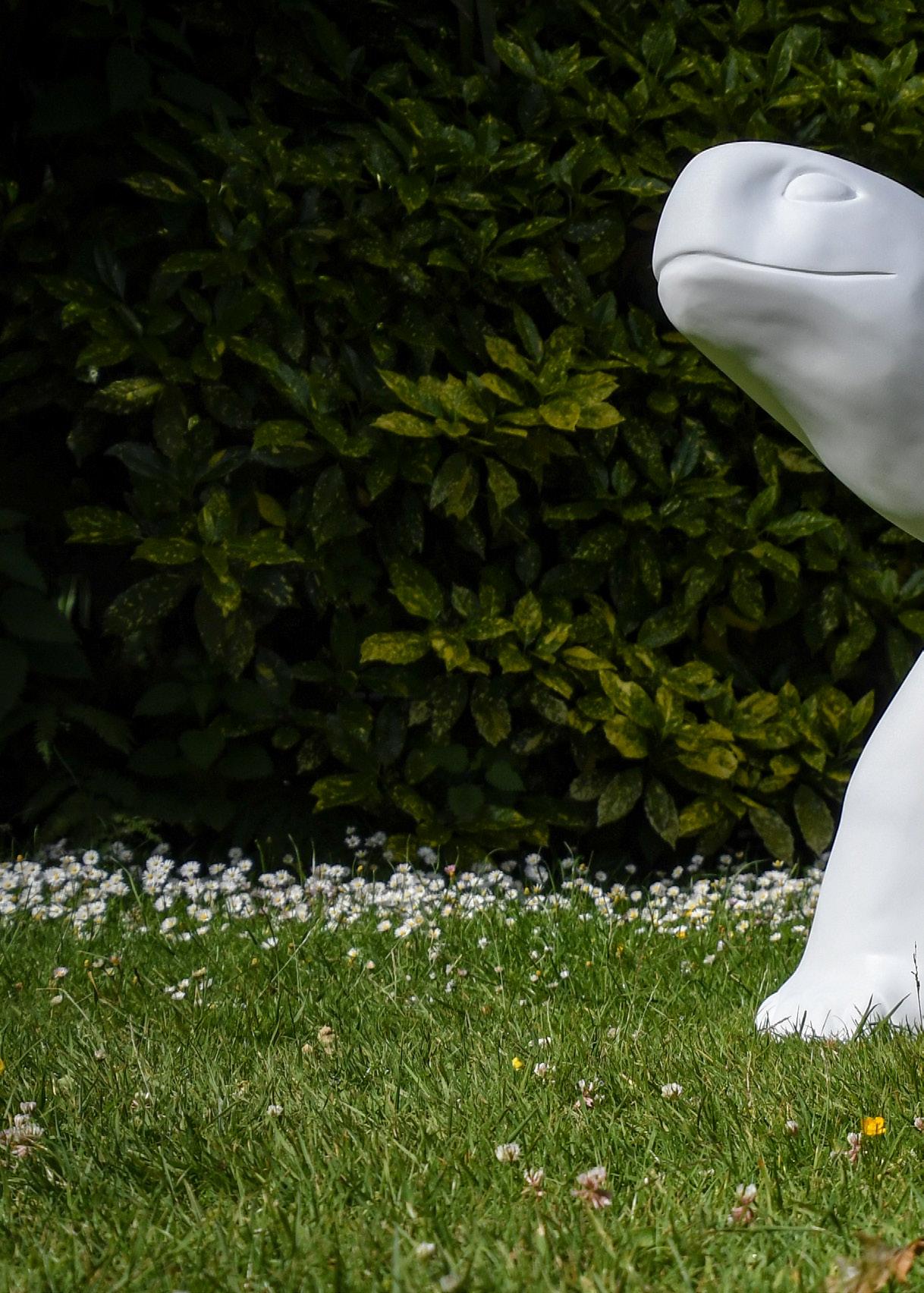
From Greek mythology to Roald Dahl’s Esio Trot, tortoises have, throughout history, plodded their way into storytelling across the globe. The tortoise is perhaps best known as the eventual victor in Aesop’s well-known fable The Hare and the Tortoise. In China, the sacred tortoise symbolises longevity, power, and tenacity, and in Ancient Greek mythology, the tortoise is the emblem for the “messenger” god, Hermes. In today’s busy world, they also serve as an important reminder to slow down, live in the moment and connect with the world around us.
Chelonians, which includes tortoises, turtles and terrapins, are now the most threatened vertebrate group and need help more than ever. The amphibian and reptile house at Jersey Zoo is home to some of the most endangered species that Durrell works with, but it is in urgent need of improved and more sustainable facilities. The team has an exciting vision for a Tropical House that will allow them to continue the exemplary care they provide for these precious animals, as well as providing visitors with a more immersive experience of the reptile and amphibian species that Durrell helps
Learn more about some of the tortoises at Jersey Zoo and the work Durrell does to protect them in the wild tortoisetakeover.org
Originally from the Seychelles these ecological engineers were introduced onto Round Island off the coast of Mauritius to graze on the invasive plants and remove them from the habitat. As the native plants co-evolved with tortoises, they are able to cope with continuous grazing, improving their survival rates. The Aldabra tortoises also feed on the fruit of Round Island’s hardwood trees, helping to disperse the tree’s seeds around the island. You’ll soon be able to see Aldabra tortoises at Jersey Zoo when they arrive in 2023!
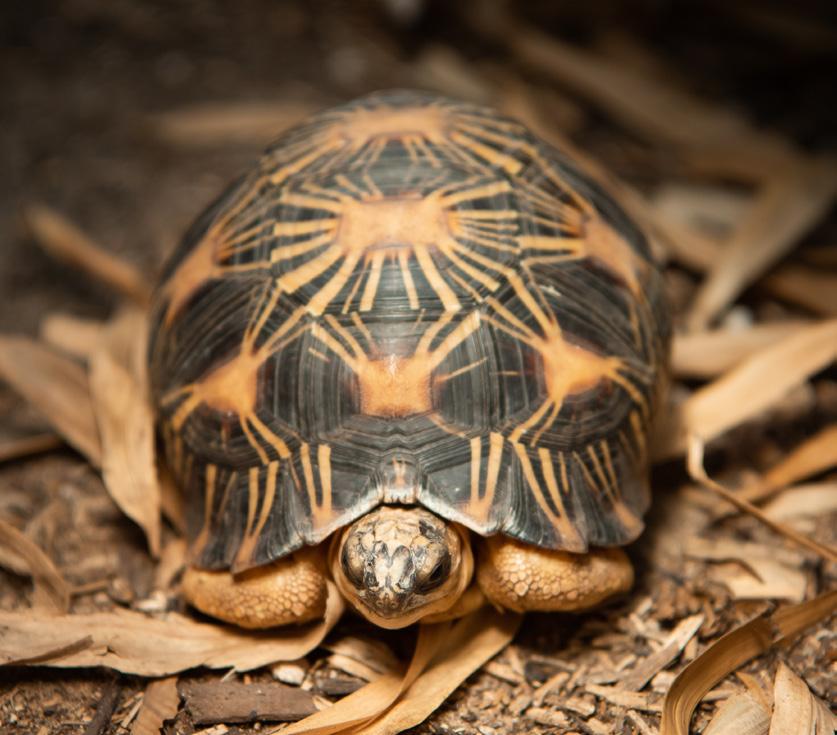
The radiated tortoise gets its name from the markings on its shell, where star shaped yellow lines “radiate” out from the centre of each shell section. They face habitat loss and illegal poaching for the pet trade, and their population has declined by 80% in the last two decades. The radiated tortoise is now protected by Malagasy law and by CITES, and lives in protected areas of Madagascar. They are also closely related to the critically endangered ploughshare tortoise. They act as a model species at Jersey Zoo, so zookeepers can learn important husbandry techniques and share these with our colleagues in Madagascar to help save another tortoise on the brink of extinction.
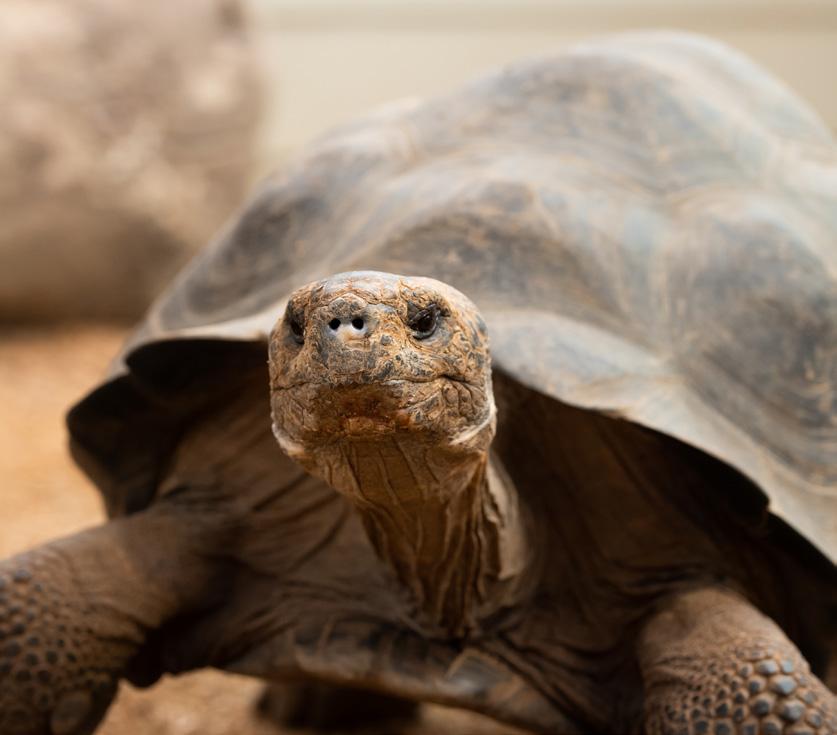
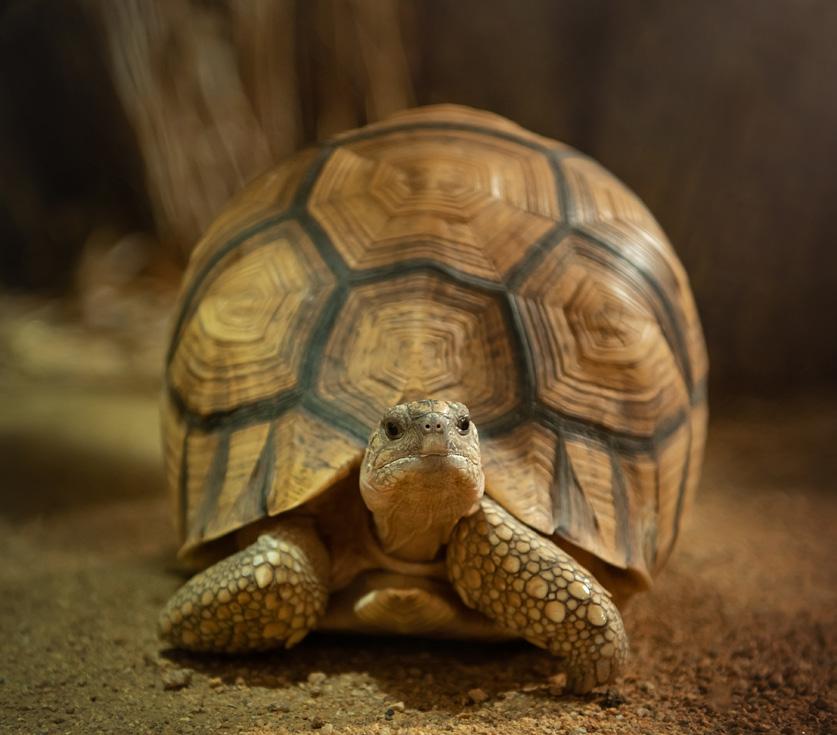
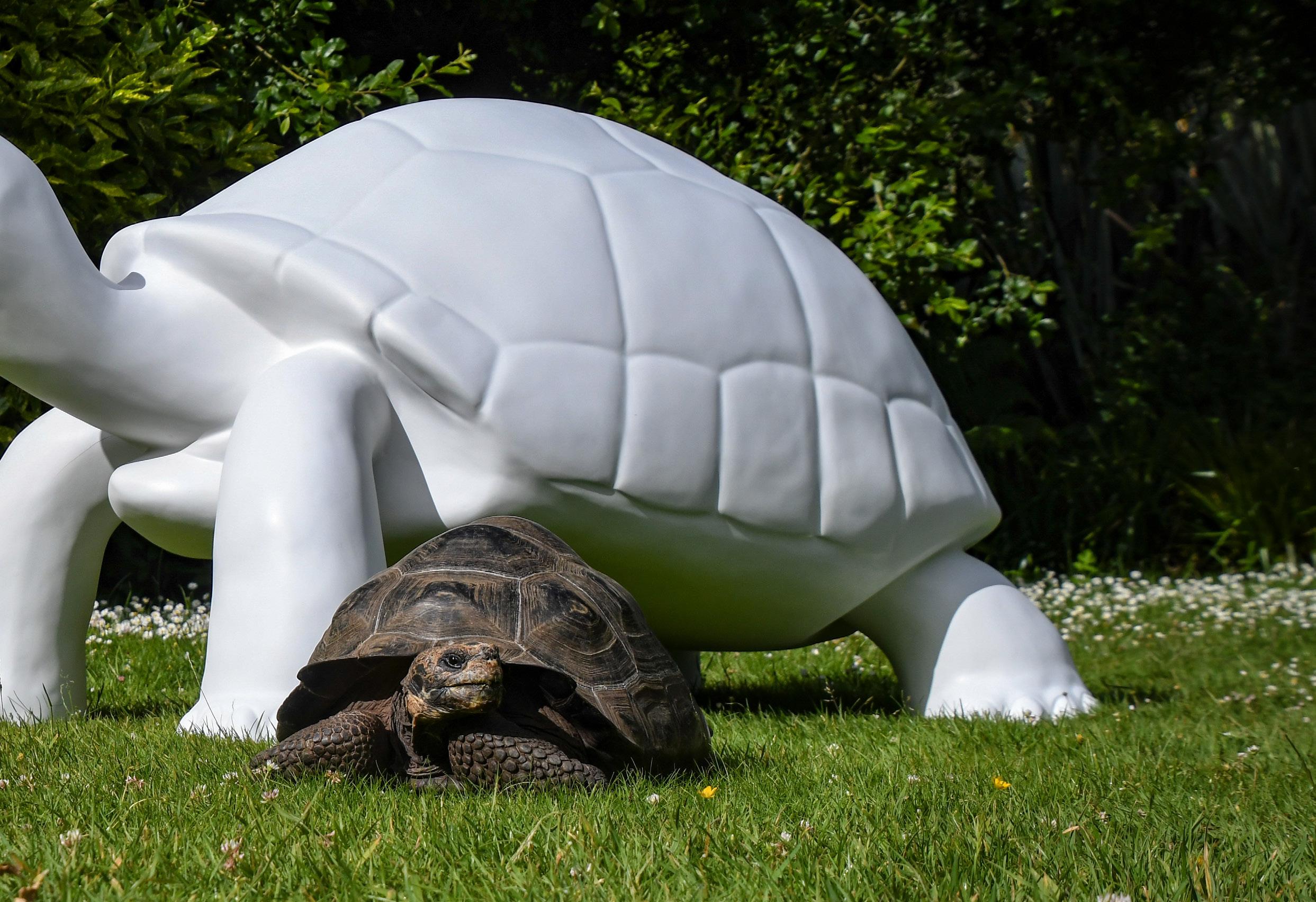
The ploughshare tortoise is the world’s most threatened tortoise. Their unique shell makes them highly desirable to wildlife traffickers, who smuggle the tortoises out of Madagascar for the illegal pet trade. Ploughshare tortoises live under the protection of armed guards at the breeding centre in Madagascar, where teams care for over 800 tortoises until it is safe for them to return to the wild. The shells of ploughshare tortoises have also been engraved with identifying marks to discourage poachers.
Galápagos giant tortoises are the largest tortoises in the world, with some fully-grown adults weighing up to 300kg! These tortoises are a great example of natural selection, as there are slight differences between the tortoises living on different islands in the Galápagos. On the cooler islands with more vegetation, you’ll find domed shells on the giant tortoises, but in the dryer, more scarcely vegetated islands, tortoises have a flatter shell that allows them to extend their necks further to reach the taller plants. Invasive species introduced to the islands, such as goats and rats, have destroyed the tortoises’ habitat and Durrell’s work in the Galápagos includes the removal of invasive species to protect the future of all the islands’ native wildlife.
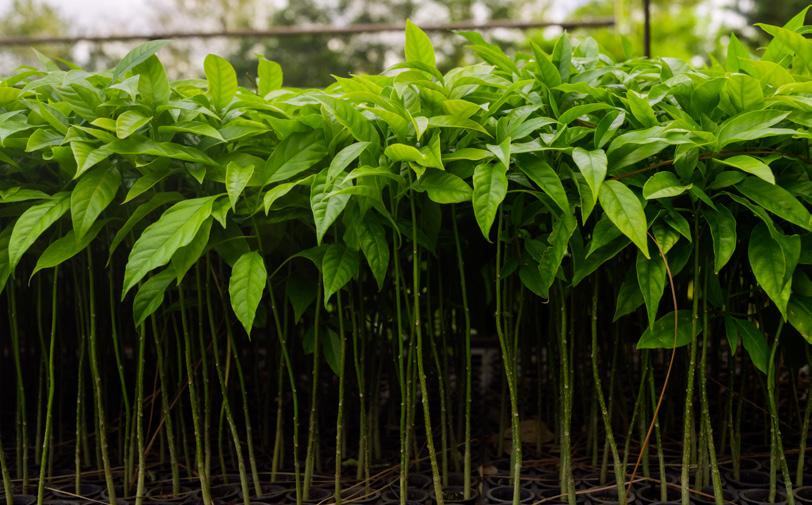
Rewild Carbon is Durrell’s nature-based climate solution, which was launched to businesses in June 2021.
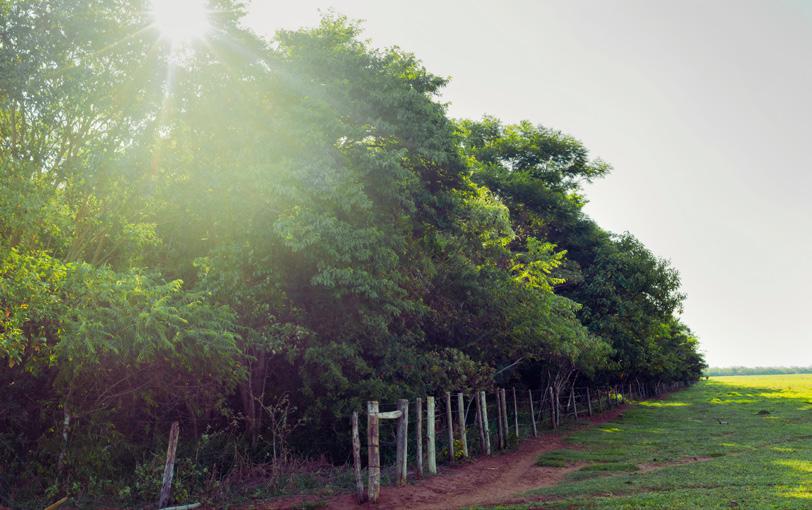
Rewild Carbon is about more than just offsetting carbon emissions and planting trees. It is about reviving ecosystems, recovering species and rebuilding livelihoods.
The first project is in the Atlantic Forest in Brazil, one of the most biodiverse and threatened habitats on the planet.
The rapid deforestation of the Atlantic Forest has resulted in segments of rainforest becoming isolated, which alienates the wildlife living there.
our impact June 2021 – October 2022
Durrell, along with local partners in Brazil, is creating forest corridors to link the scattered fragments, providing lifelines for the many species that depend on this precious habitat for survival, such as the black lion tamarin.
Forest restoration is also key to generating income in the project region, where poverty is widespread. Collecting seeds, growing seedlings, planting trees, and maintaining the newly planted sites all create jobs and training opportunities for the local community.
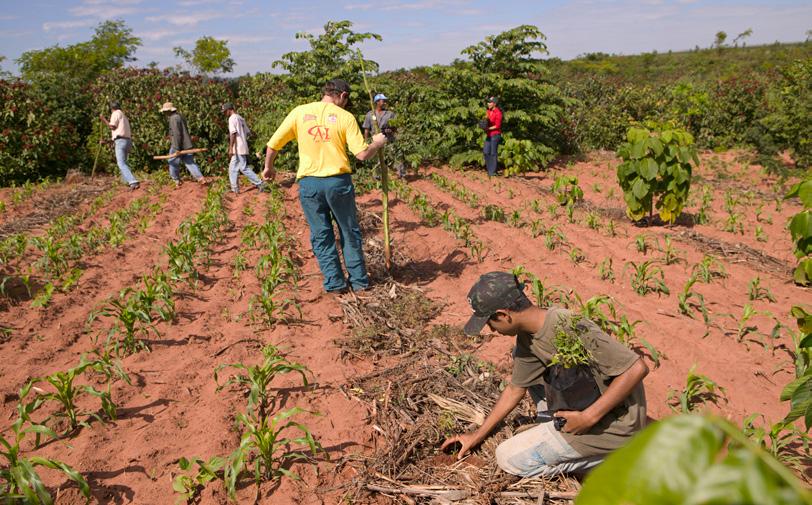
Together, we are making a difference.
Find out more at durrell.org/rewildcarbon
planted
Tonnes of CO2 will be
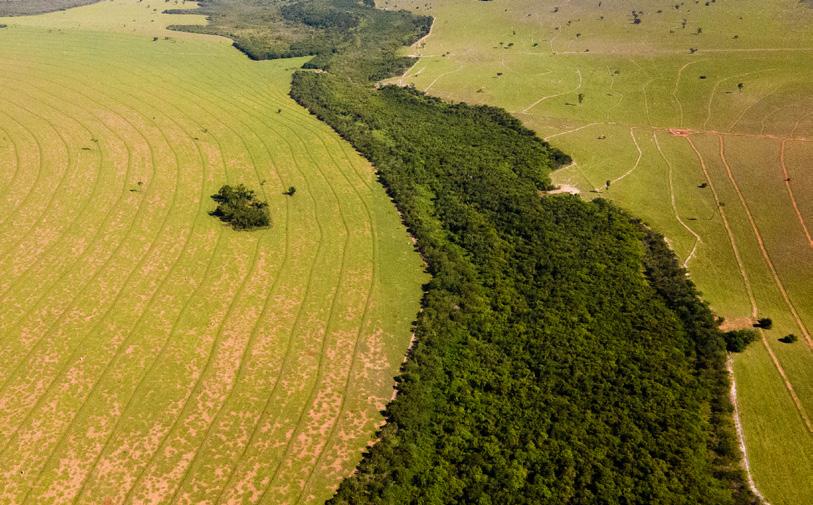

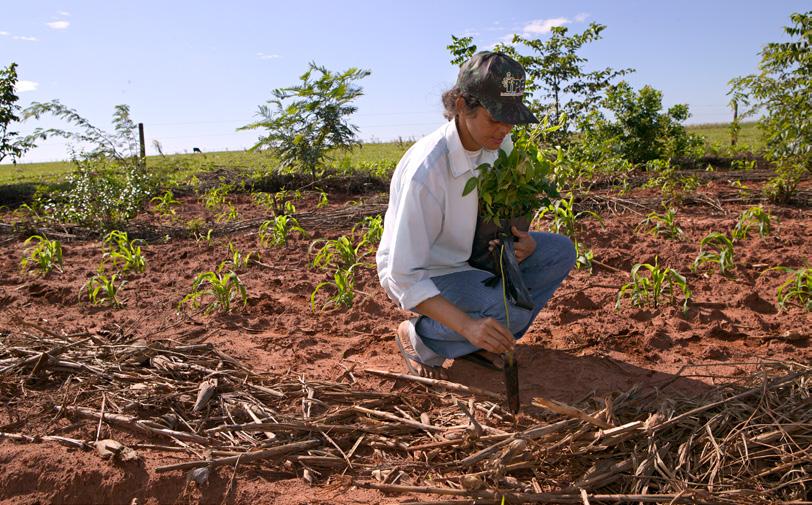
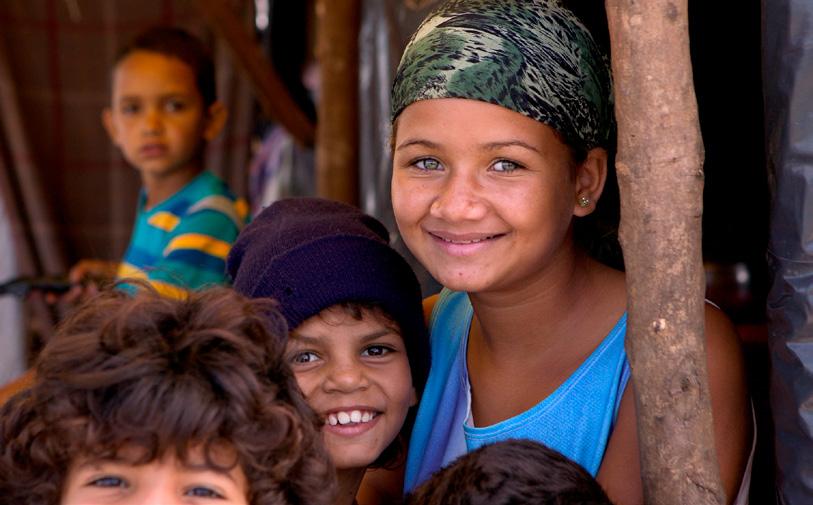
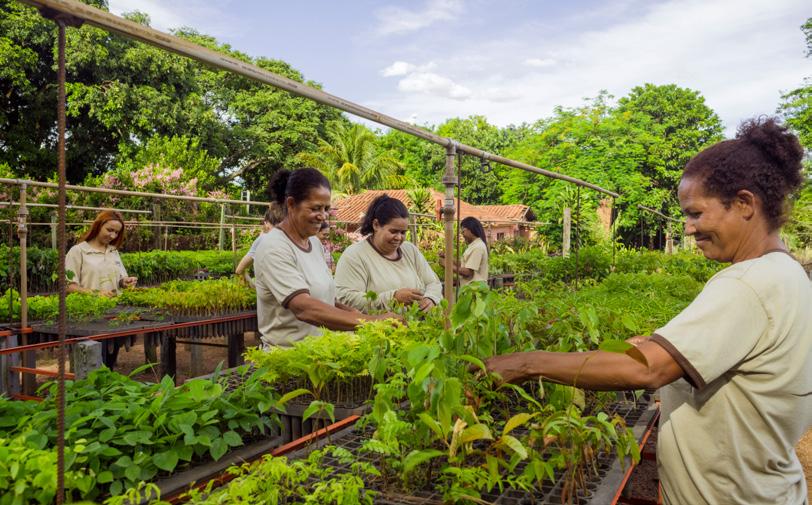
HRH The Princess Royal hosted a reception at St James’s Palace on 12 October to celebrate her 50th anniversary of patronage for Durrell Wildlife Conservation Trust. To mark the occasion, we are gifting HRH a tortoise sculpture from our Tortoise Takeover art trail, which will take over Jersey next summer.
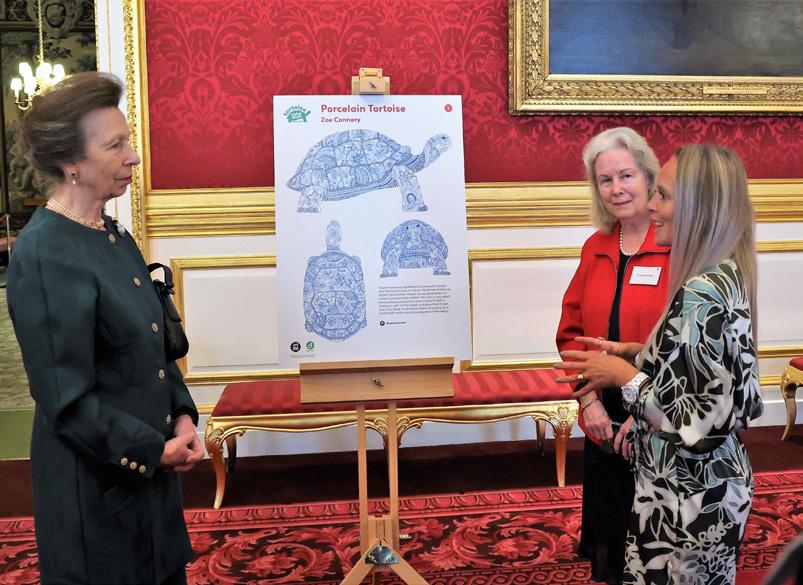
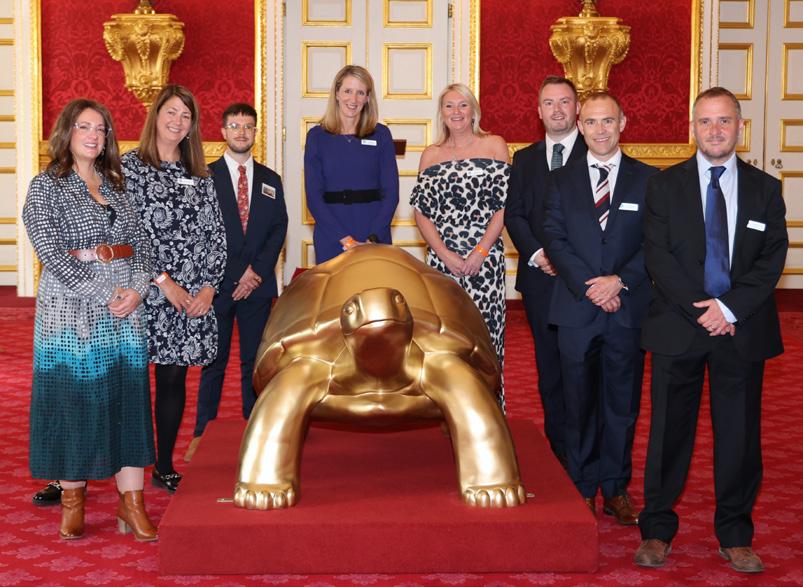
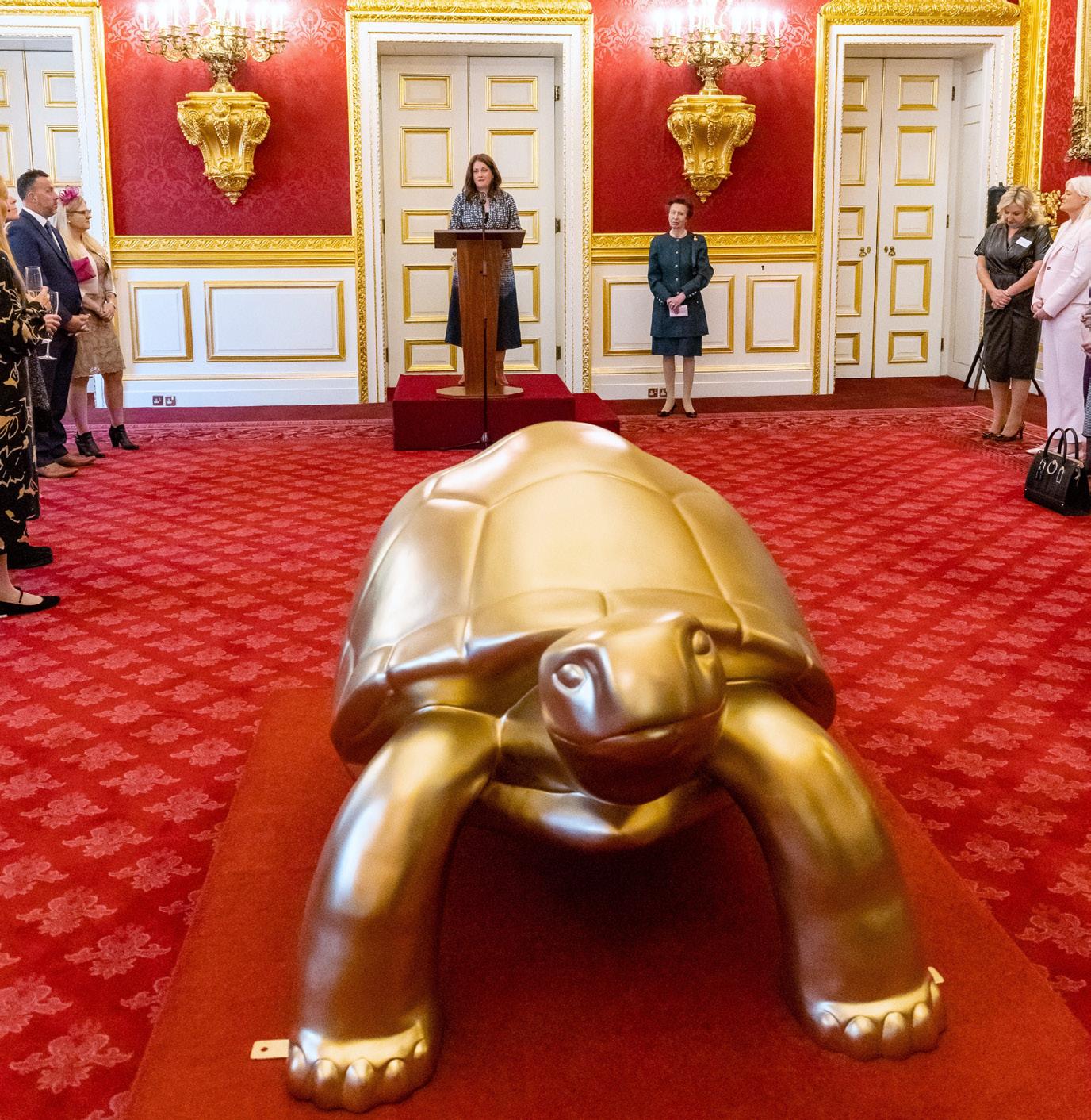
A selection of artists were invited to submit their tortoise designs to reflect The Princess’s commitment to the Trust over the past 50 years. The design chosen by HRH titled “Sanctuary”, was submitted by Jersey artist Gabriella Street. It featured colours that were exact swatches pulled from photographs of The Princess Royal’s past and present fashion, alongside flora and fauna specific to her many trips to Durrell projects and Jersey Zoo.
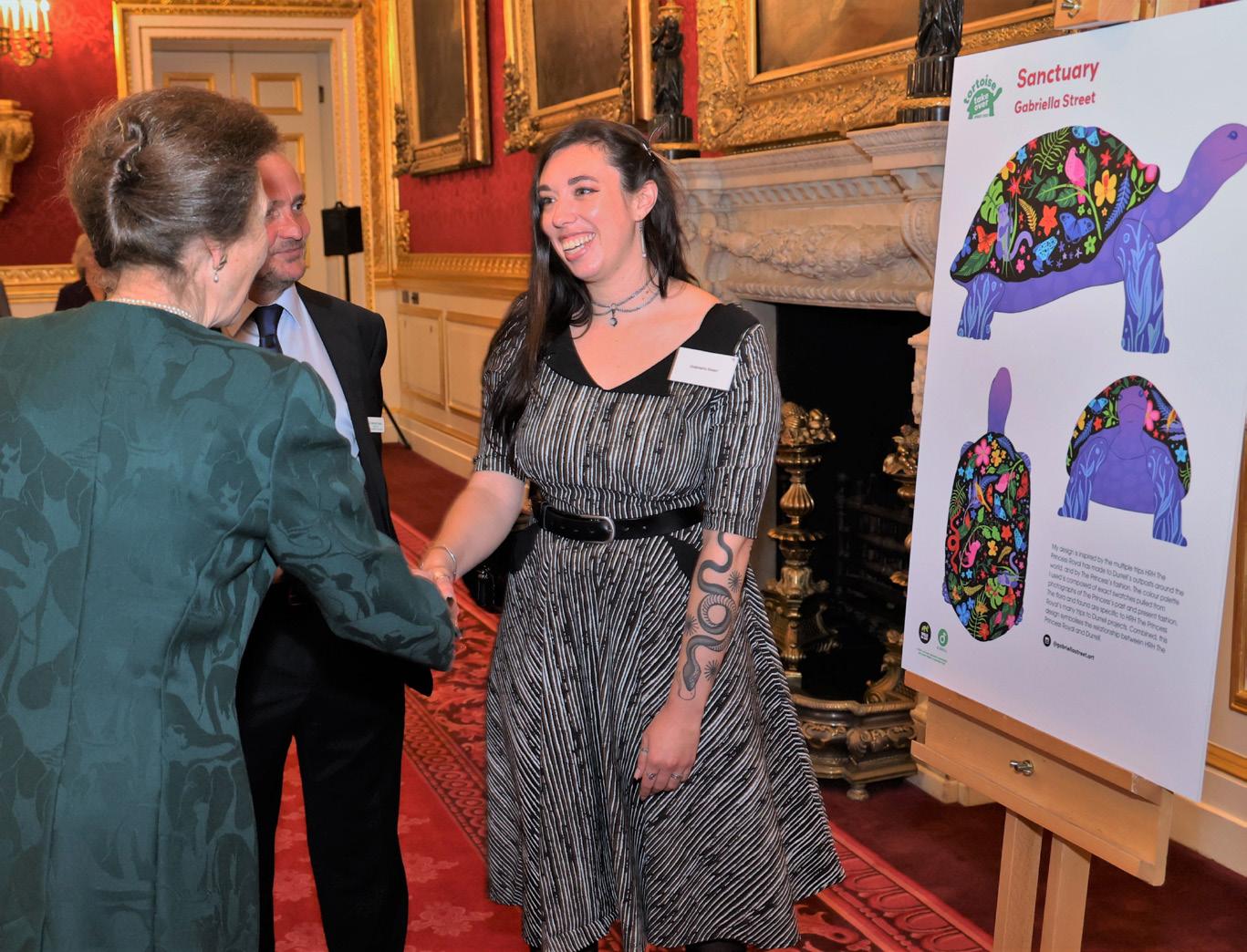
The design will be commissioned to join 50 giant tortoises on the trail in Jersey during July and August 2023. Once the trail is over, the sculpture will be gifted to The Princess Royal as a token of Durrell’s appreciation for her commitment over the past 50 years.
CLOCKWISE FROM LEFT HRH The Princess Royal with Dr Lee Durrell and artist Zoe Connery. The Durrell team.
HRH The Princess Royal meeting Gabriella Street with her winning design “Sanctuary”. Dr Lesley Dickie introducing HRH The Princess Royal. Dr Lee Durrell, HRH The Princess, and Dr Lesley Dickie.
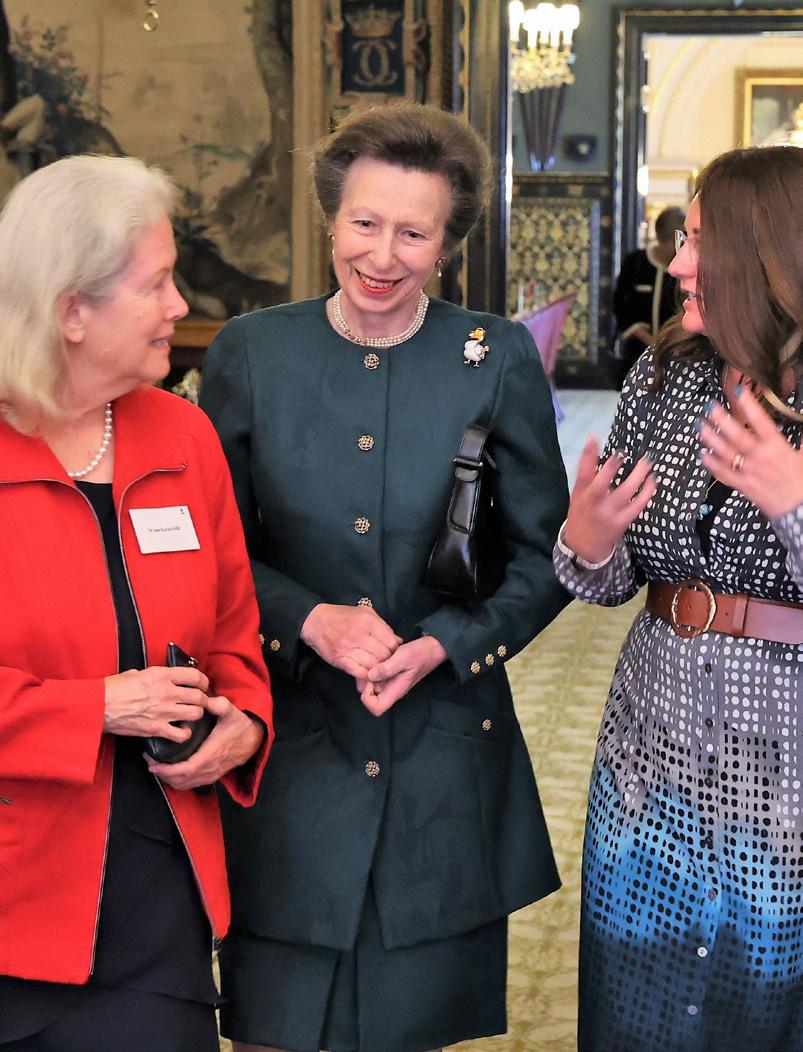
bones are amazing, the way they fit together allow animals to do fabulous things:

To make flying easier, most birds have super light skeletons. Their bones have a honeycomb structure which is strong, but light.
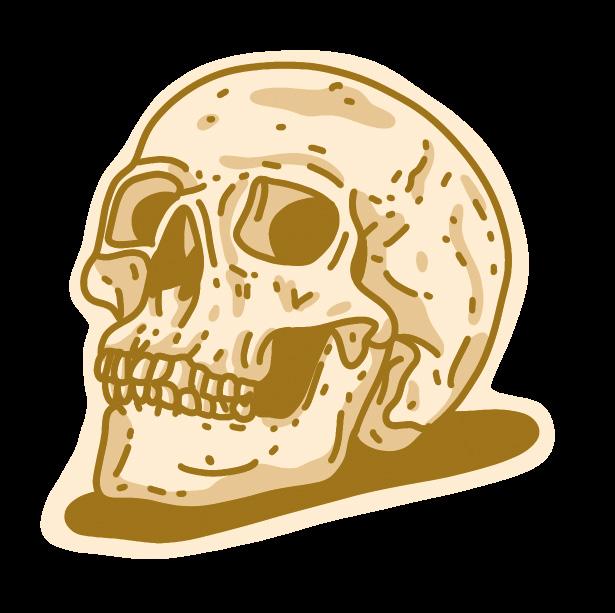
Insects don’t have bones inside their bodies, but do have external skeletons called exoskeletons. They form a protective suit of armour.
Unlike most apes, many humans can walk on two legs. We developed this skill as our hips evolved to help us travel on foot.
Take a walk outside to discover more miracles of movement, and notice the spectacle of different species’ skeletons.
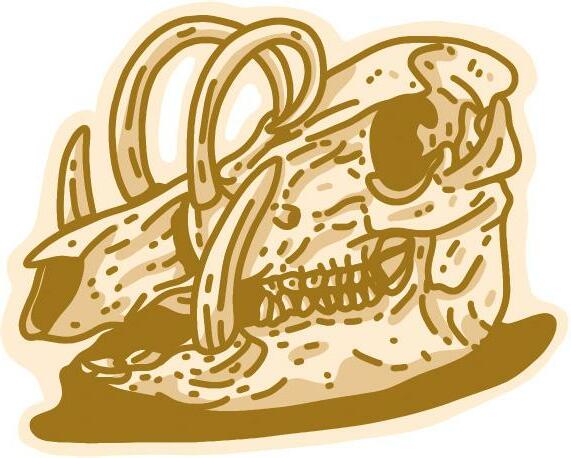
We can understand a lot about these dinosaurs by looking at their bones. They have sharp teeth and strong jaws, which tells us they were likely to have been meat eaters. Skull scans suggest that their brains had large smell-processing centres which may have given them a massive advantage in finding food.
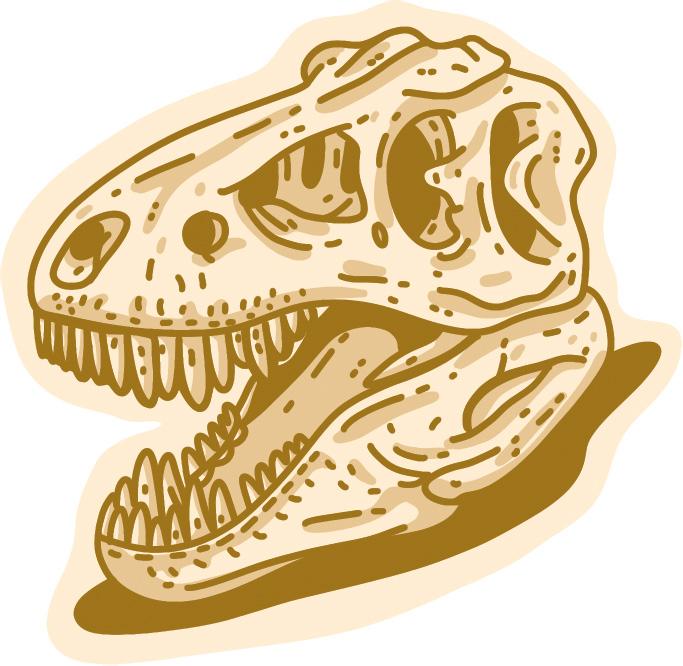
Different types of predators can often face similar challenges. They need to hunt accurately, kill effectively, and tear meat efficiently. This often leads to many similarities in skulls and teeth even in seemingly unrelated predators. How many similarities can you find?
The astonishing tusks of these wild pigs may be important in dominance fights. The upper tusks seem to be protective, shielding the head. The lower tusks could function more like daggers. To keep the lower tusks in good condition, male Babirusa sharpen them against tree trunks.
Human skulls are amazing, but can be strange things to think about. These complex structures are formed from several bony plates which are fused together in early childhood. Human skulls vary, for example, some people have smooth chins, others have dimpled chins. This is due to differences in the way our jaw bones fuse together.

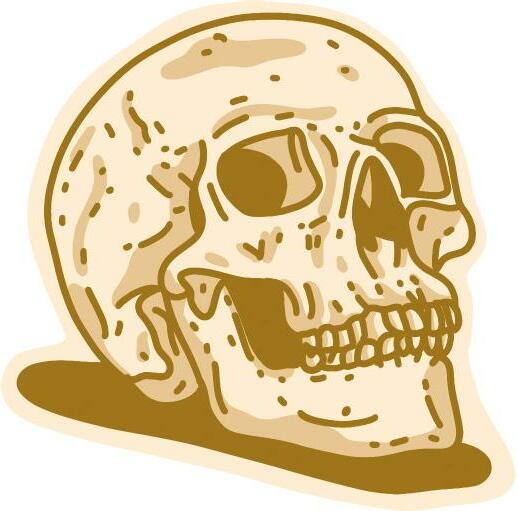
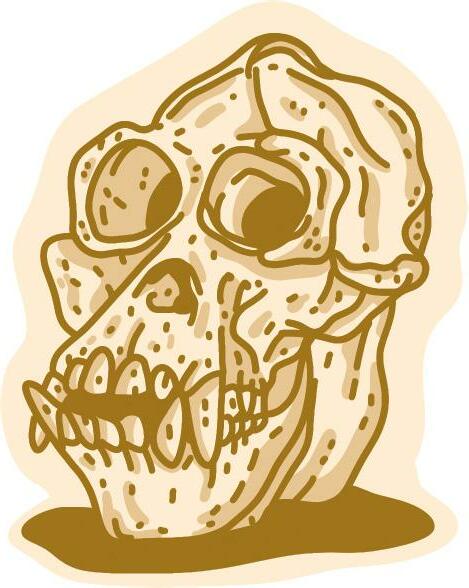
Gorillas are closely related to humans. There are obvious similarities in the skulls, but there are also a number of differences. The shape of the gorilla skull gives it extra strength when eating tough food. For example, our male gorilla Badongo, is able to crack open whole coconuts between his jaws!
X-ray photography allows us to see bones and examine them for any damage.
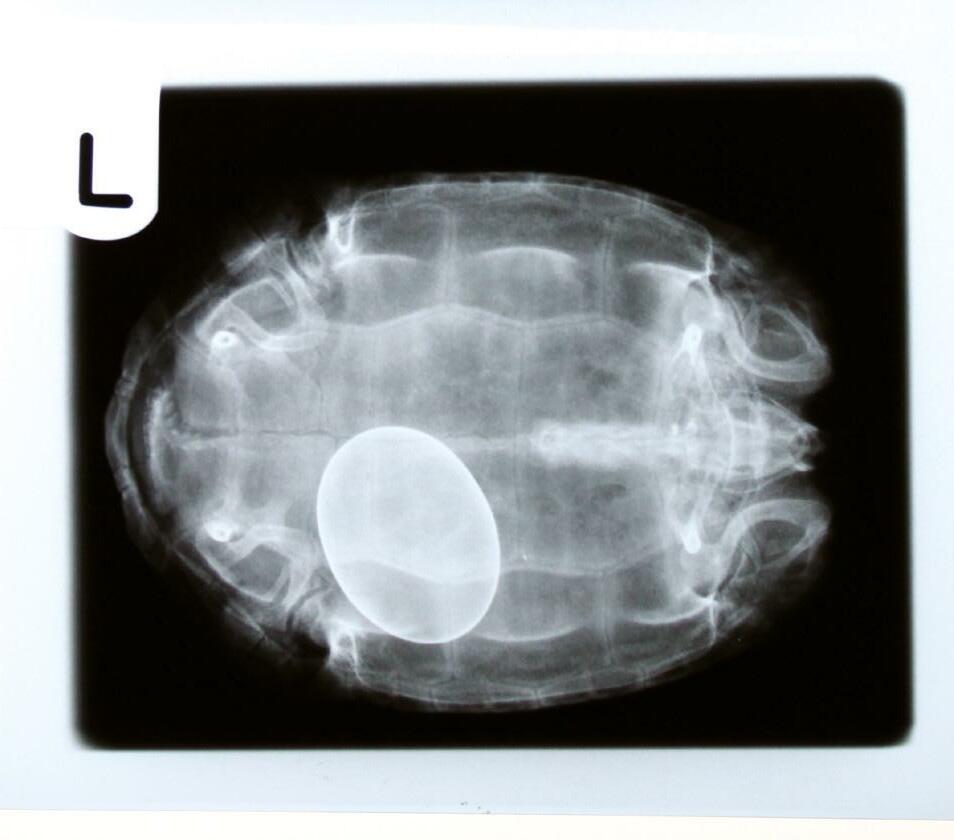
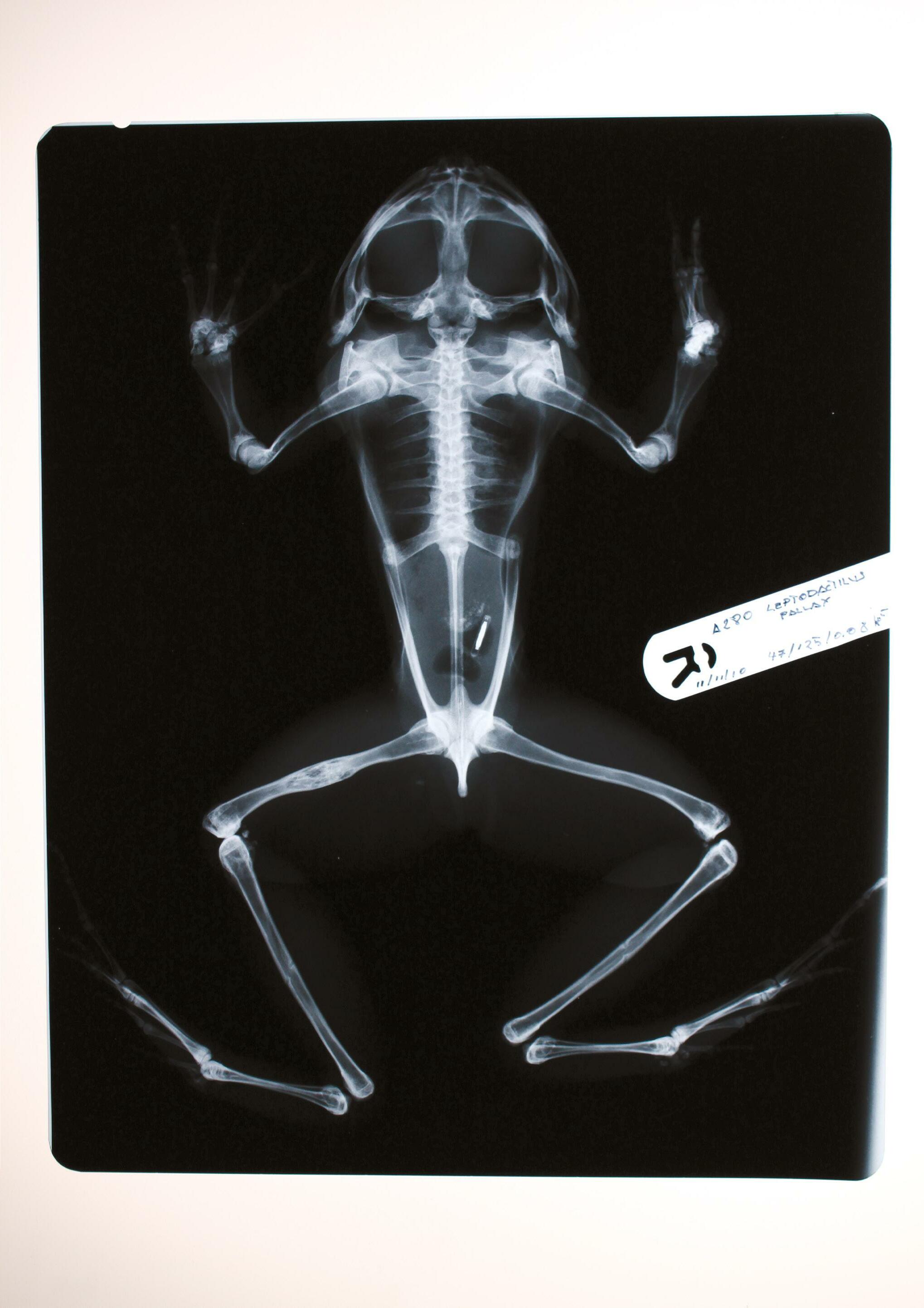
X-rays are a type of radiation that easily passes through our bodies. They don’t travel so easily through bones.
During a scan, x-ray beams are directed at the patient’s body. If the rays hit bone it means they are blocked, but if the rays hit soft body parts (or bone breakages), they pass straight through. The contrast between the detected rays and the shadows caused by bones creates an image. This image reveals where the bones are located, and any damage or breaks.
X-rays are not just used on humans. Our vets use them to better help any injured animals.
What animal do you think this is?
What’s that odd shape?
Can you find this frog’s microchip tag?
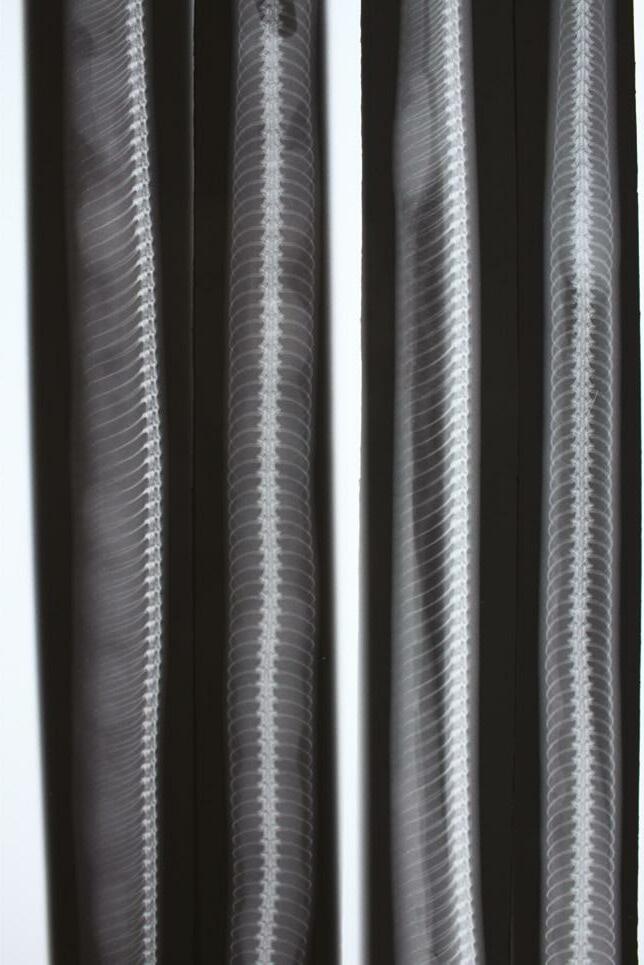 That’s a lot of ribs! What could they
That’s a lot of ribs! What could they






















































Help our dodo skelton friend find his head. Which path will you choose?

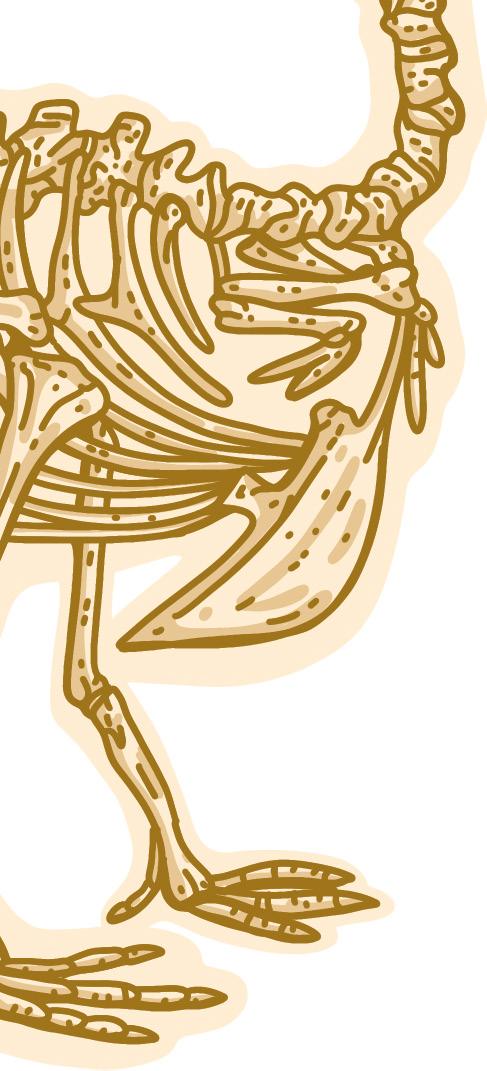
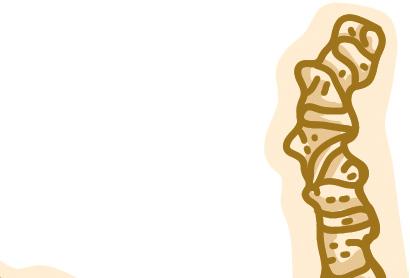
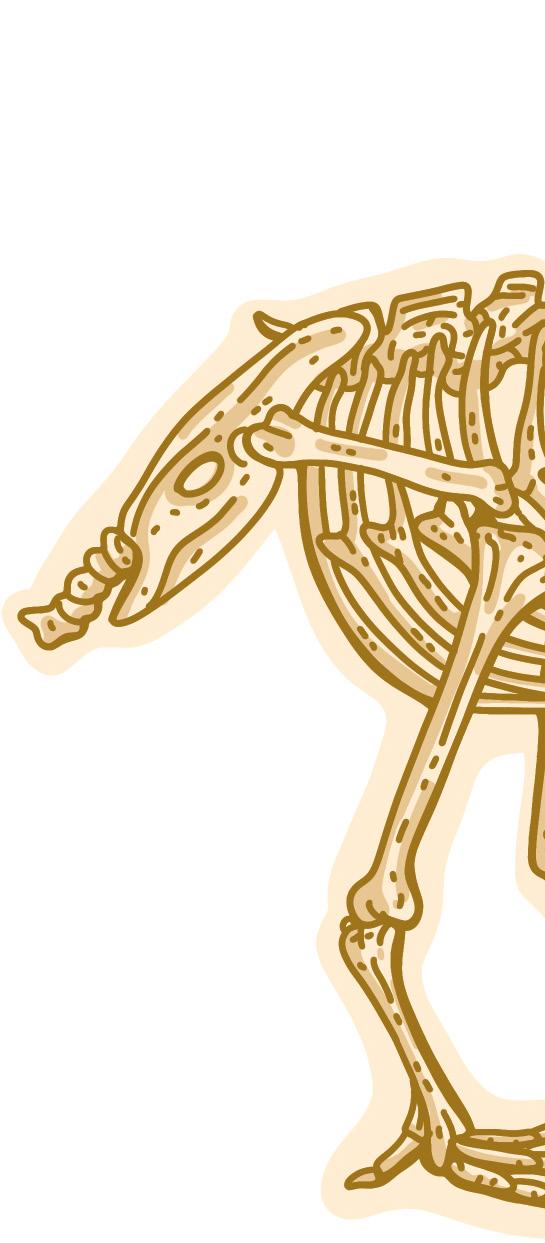
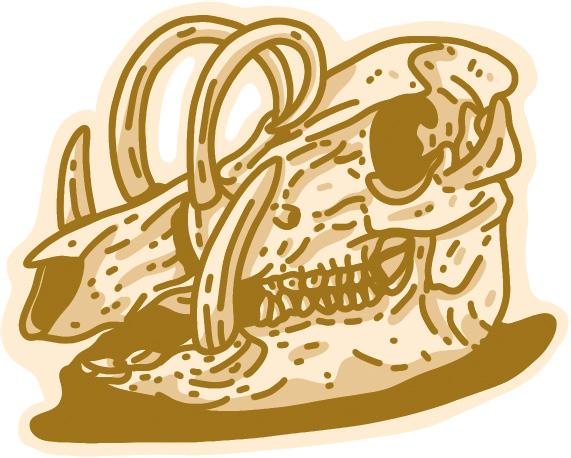
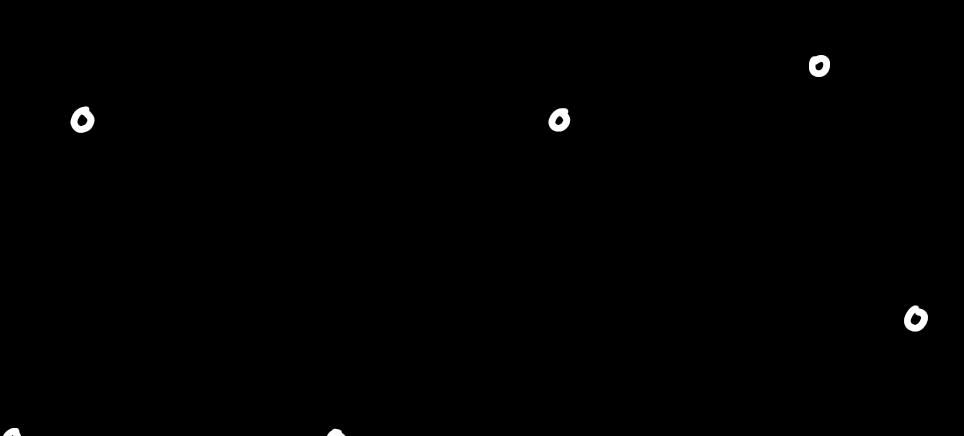
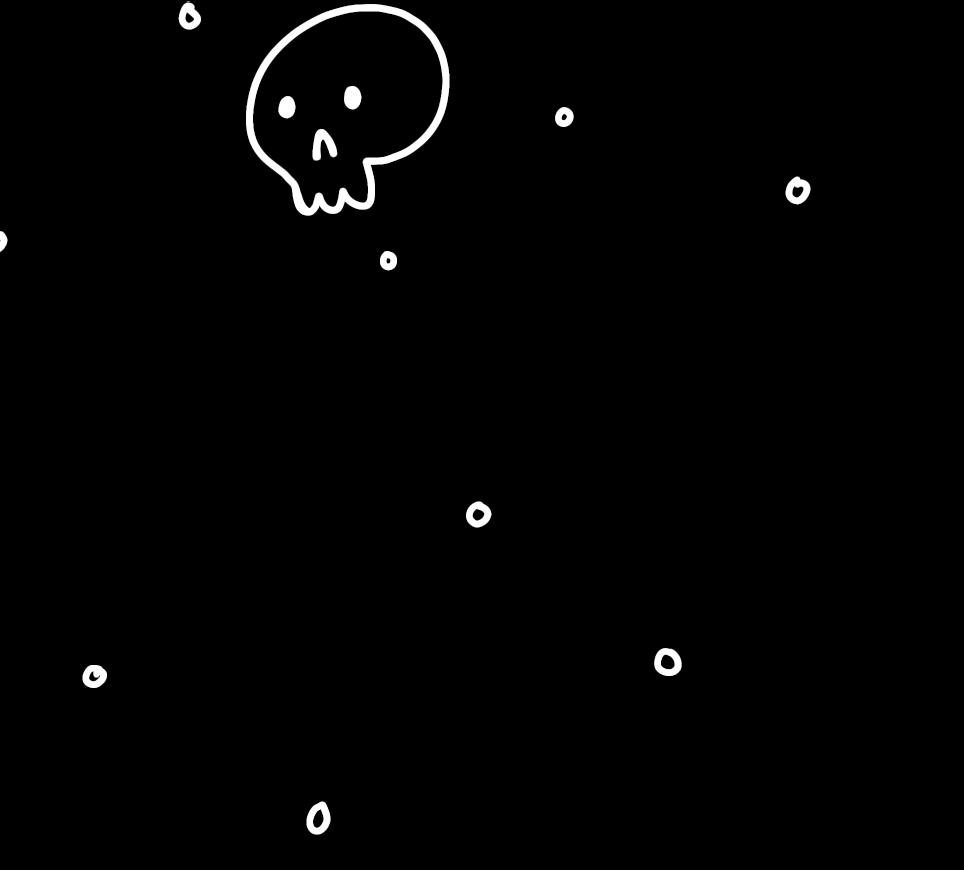
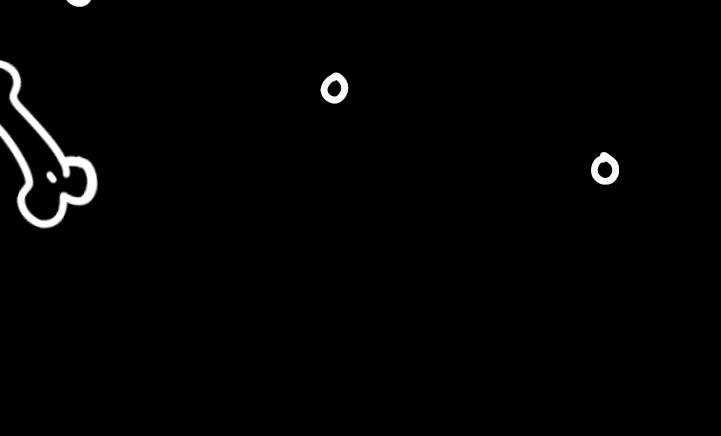

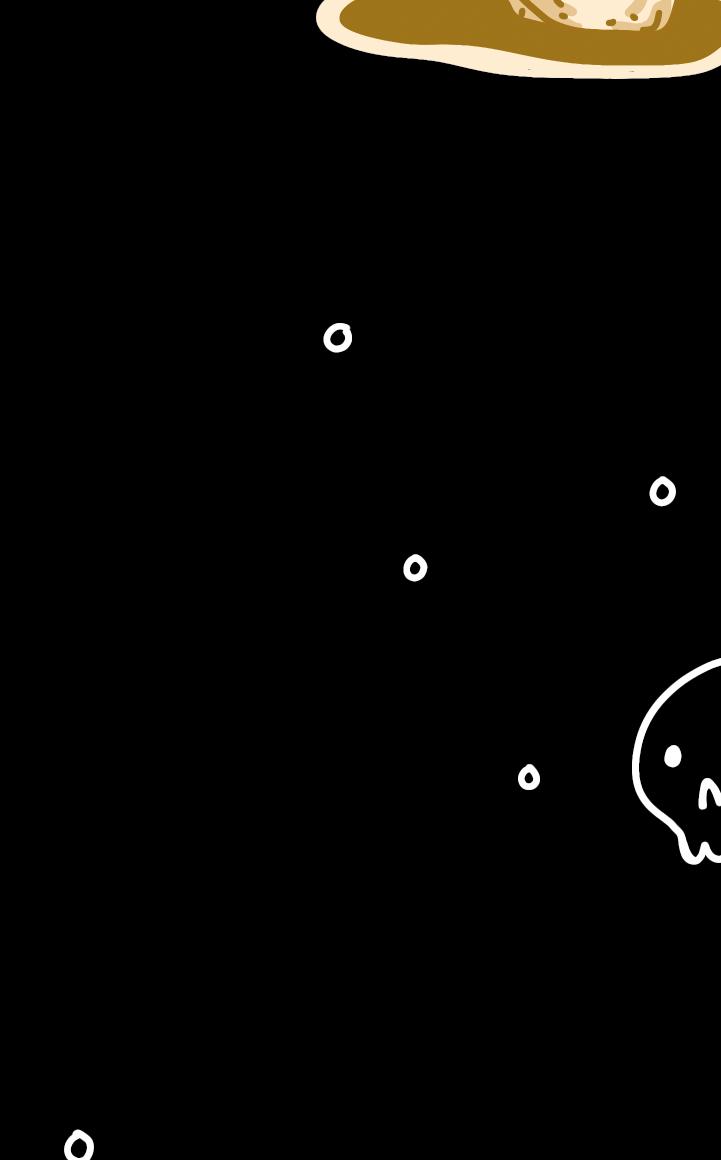
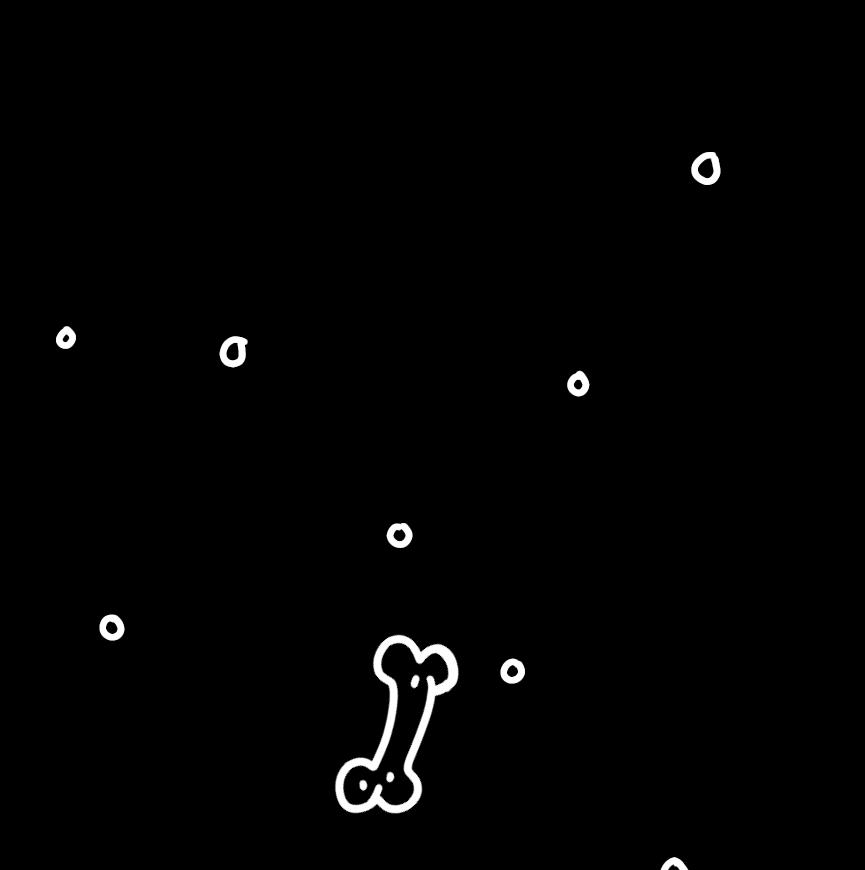

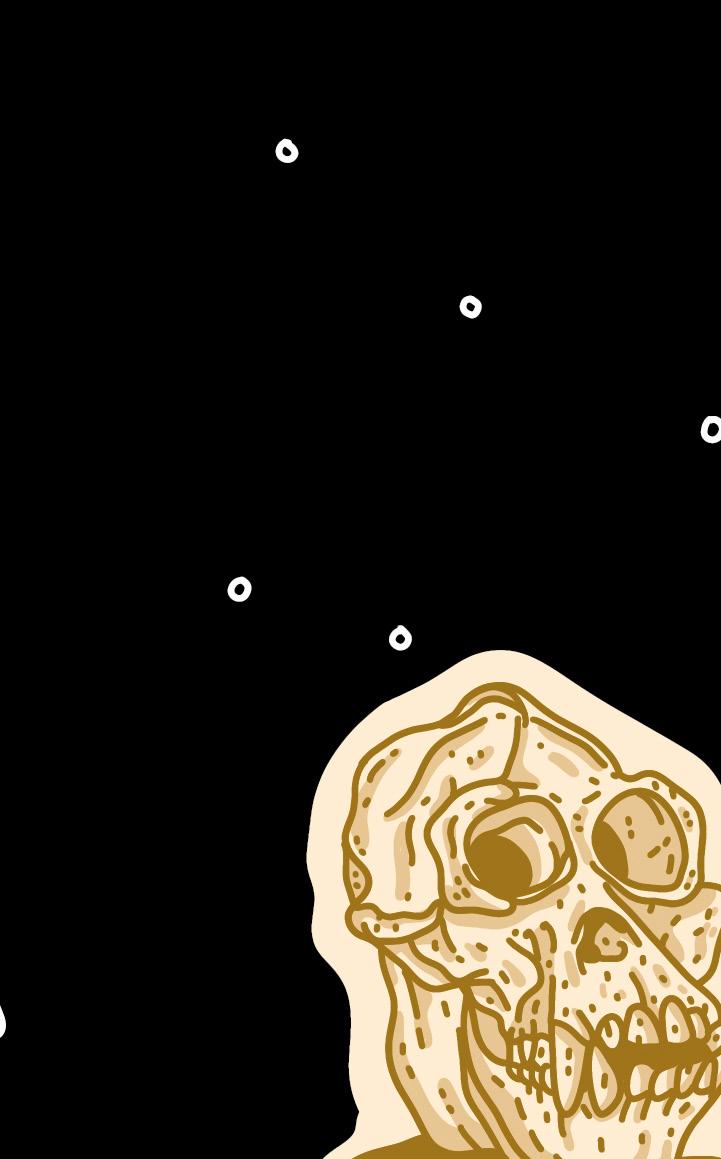

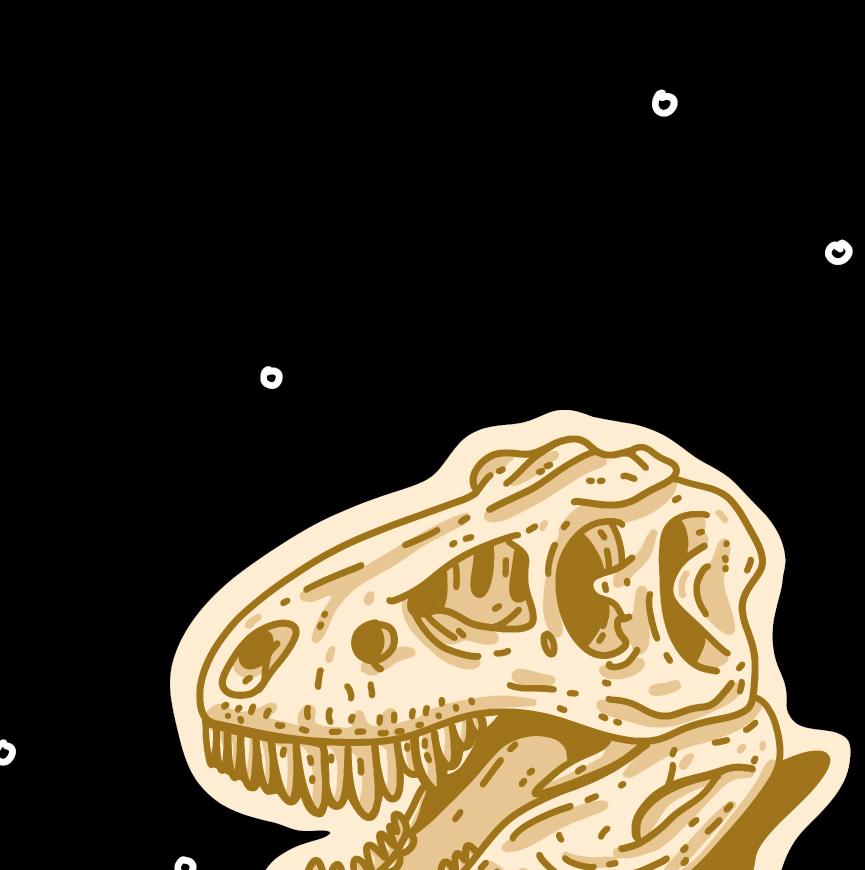



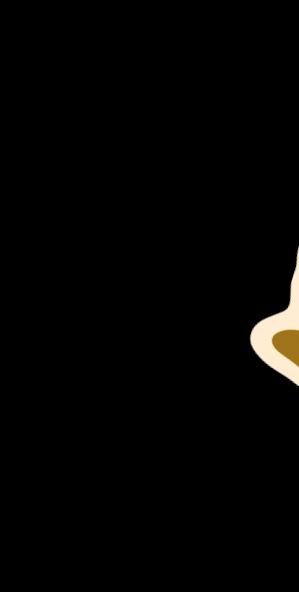


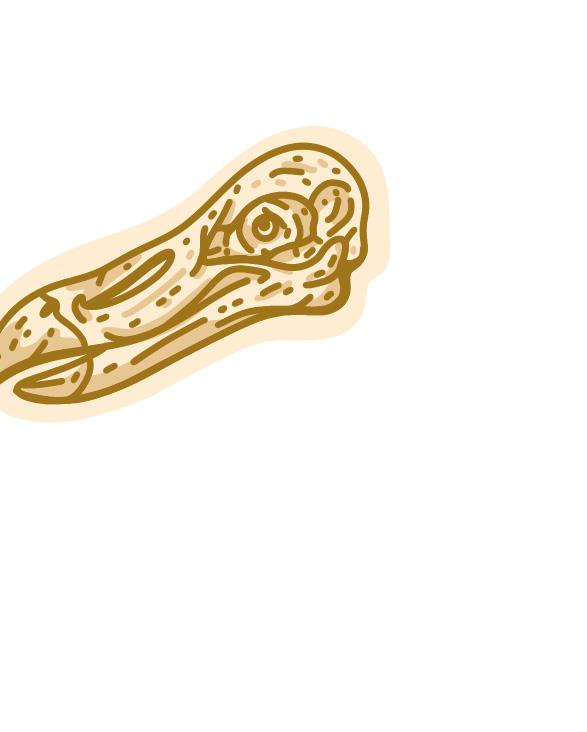
Each year we move animals to other zoos around the world as part of our work. We’ve had some exciting new arrivals this year…
Golden Guernsey goats were specifically cross bred with other species to be able to survive island conditions. Once found across both Guernsey and Jersey, the goats are now classed as a rare breed. You can see our four Golden Guernsey goats in their paddock opposite the Butterfly Kaleidoscope.
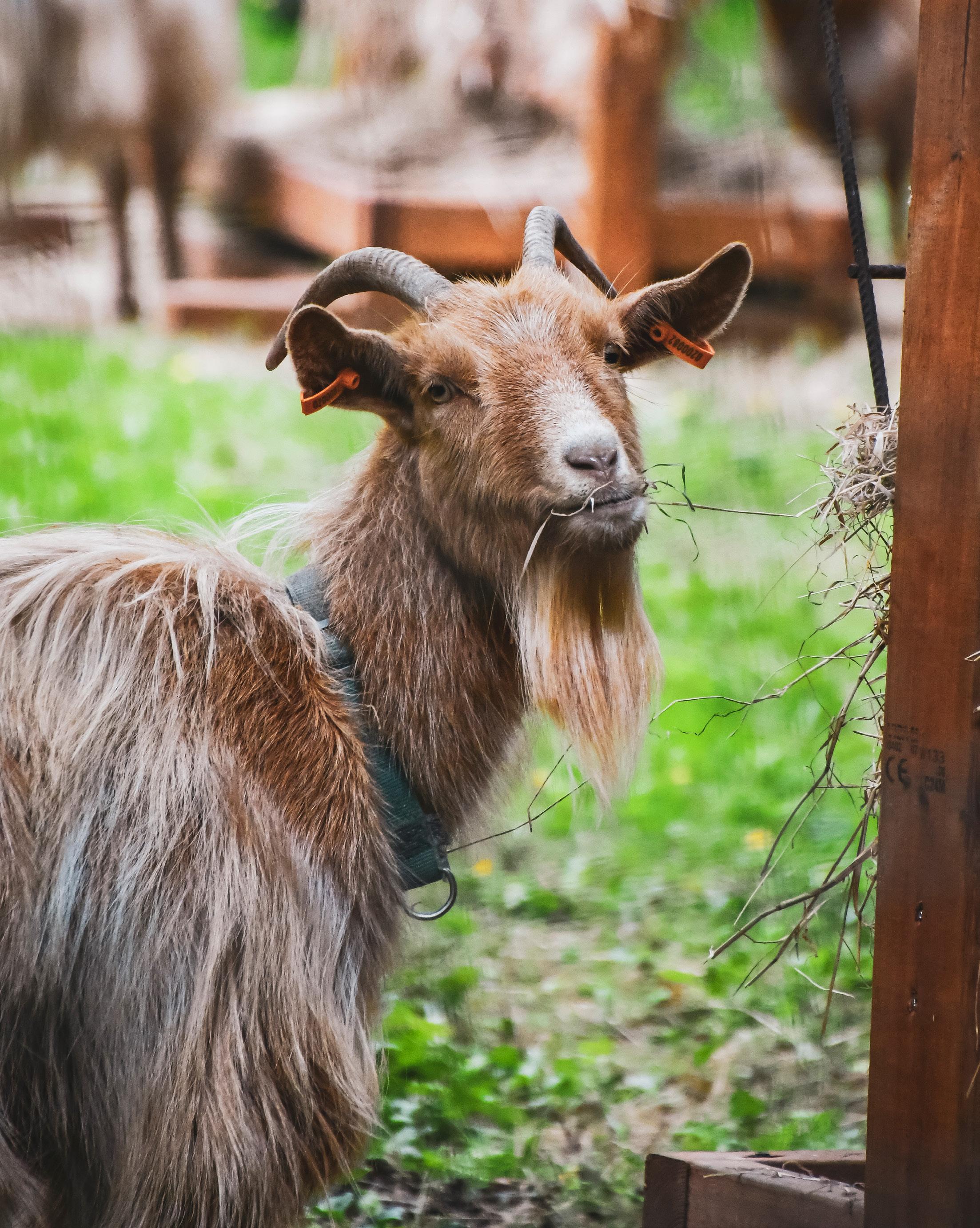
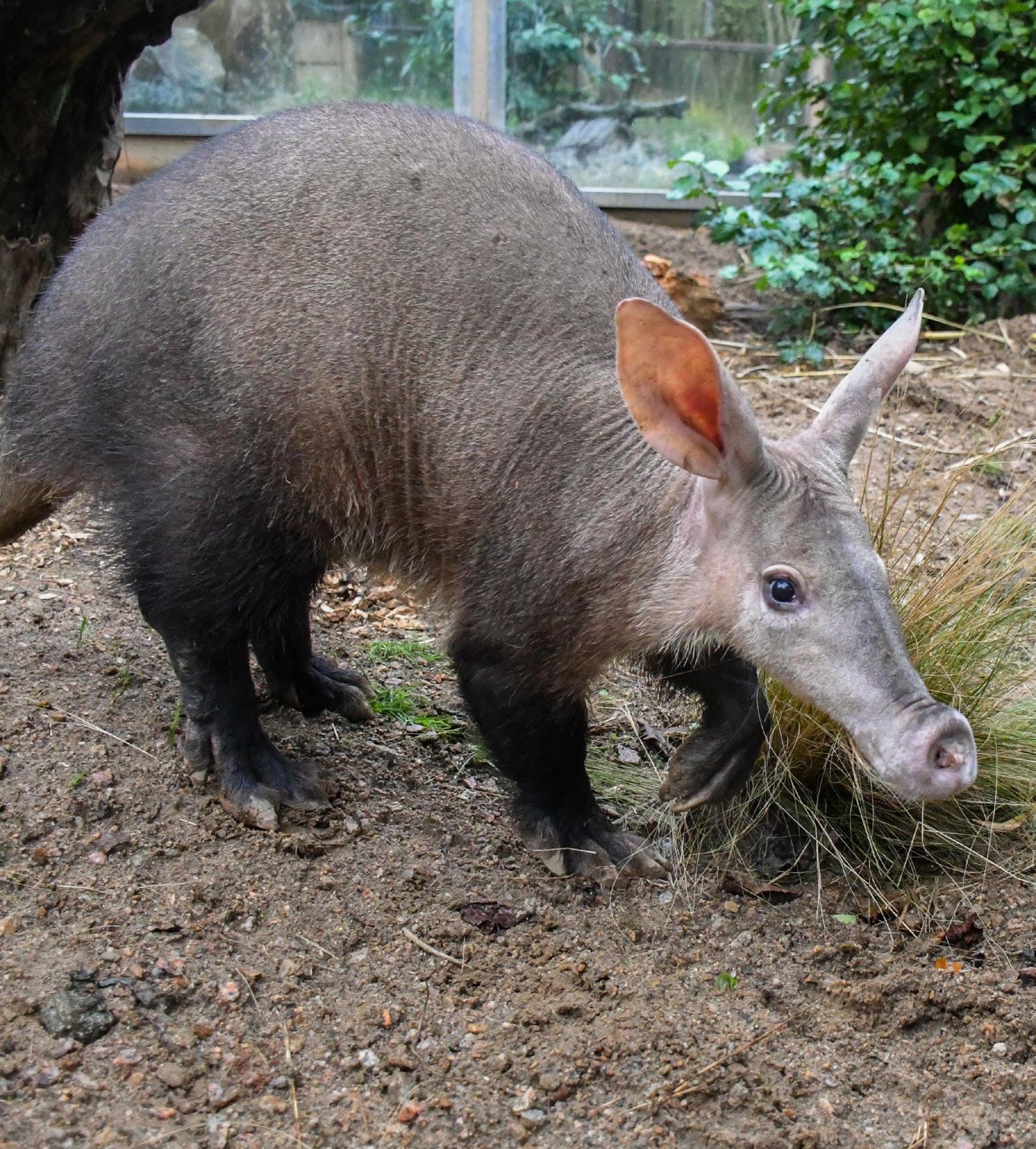
Found across Africa, aardvark means “earth pig” in Afrikaans, a name given to them because of their long snout and love of digging. You can find Tafari, our male aardvark, probably snoozing in Discovery Desert alongside our cheeky mob of meerkats.
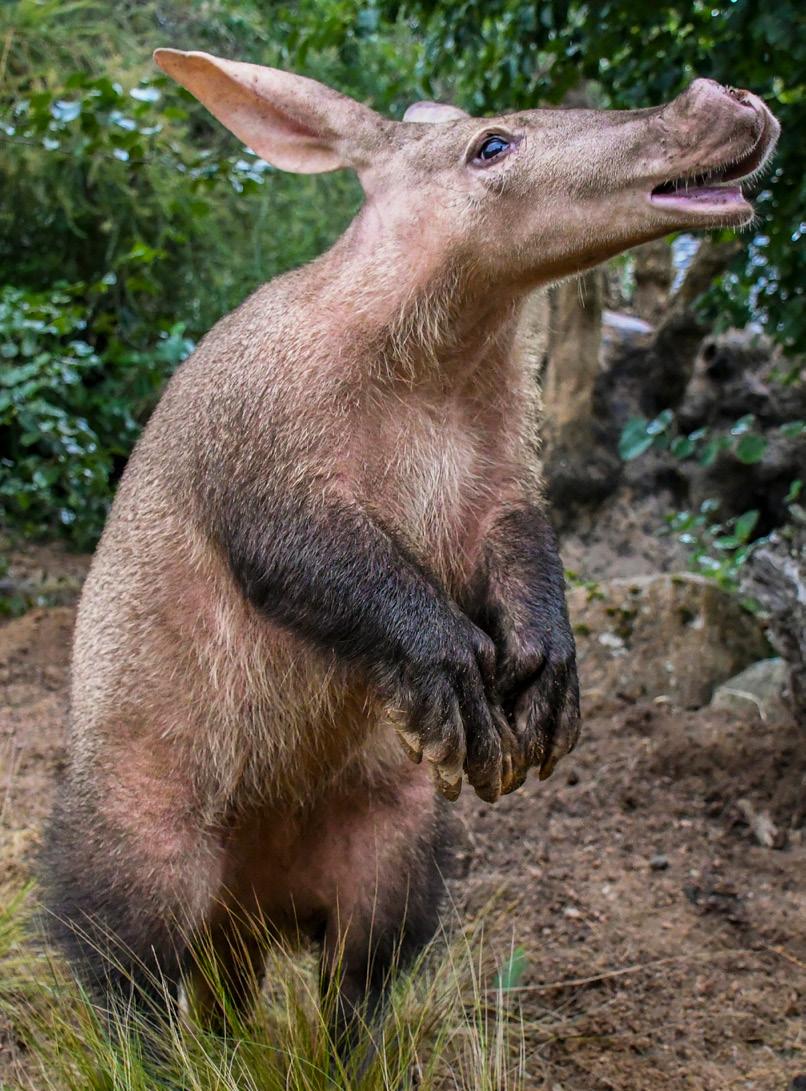
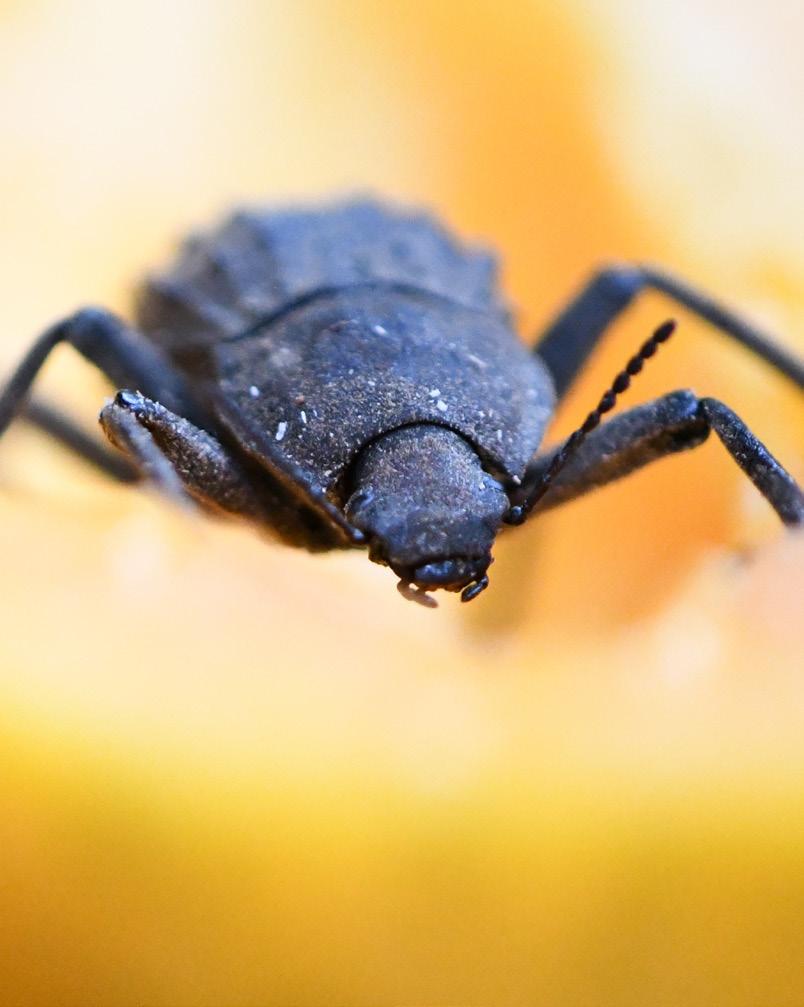
Native to Frégate Island in the Seychelles, Frégate Island beetles usually live on trees and in rotting logs. They are most active at night when they feast on fruit and fungi. Look out for these incredible beetles in the Visitor Centre as you make your way into the zoo. Our beetles have successfully produced their first grubs, which is just the start of our work with this fascinating species!
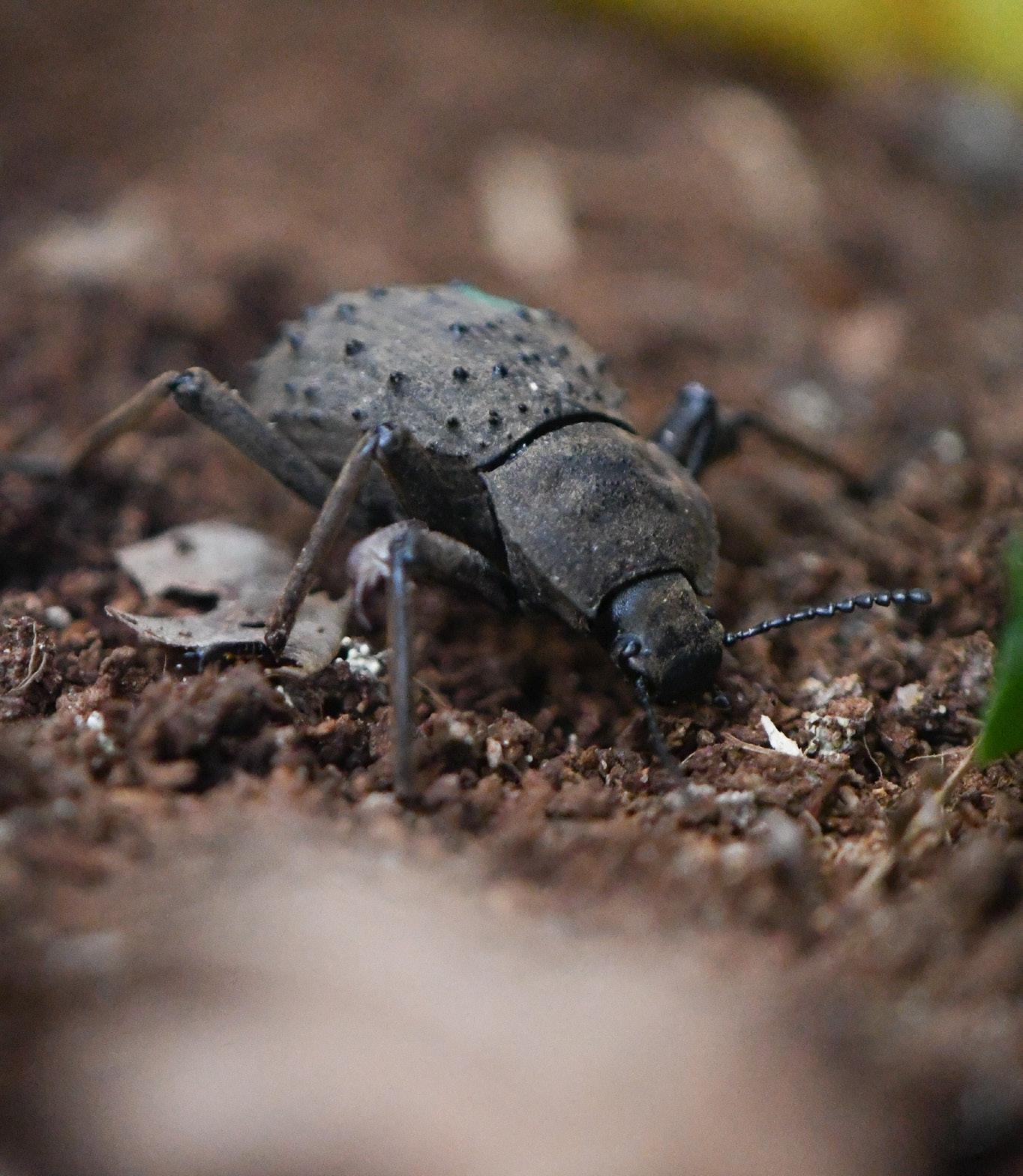
Gelada Geladas, sometimes called gelada baboons, are not actually true baboons. They belong in their own species group and are the last living species of primate that graze on grass. Like many other primates, they live in large family groups and use a range of facial expressions and vocalisations to communicate. You can find the geladas next to Tamarin Woods.
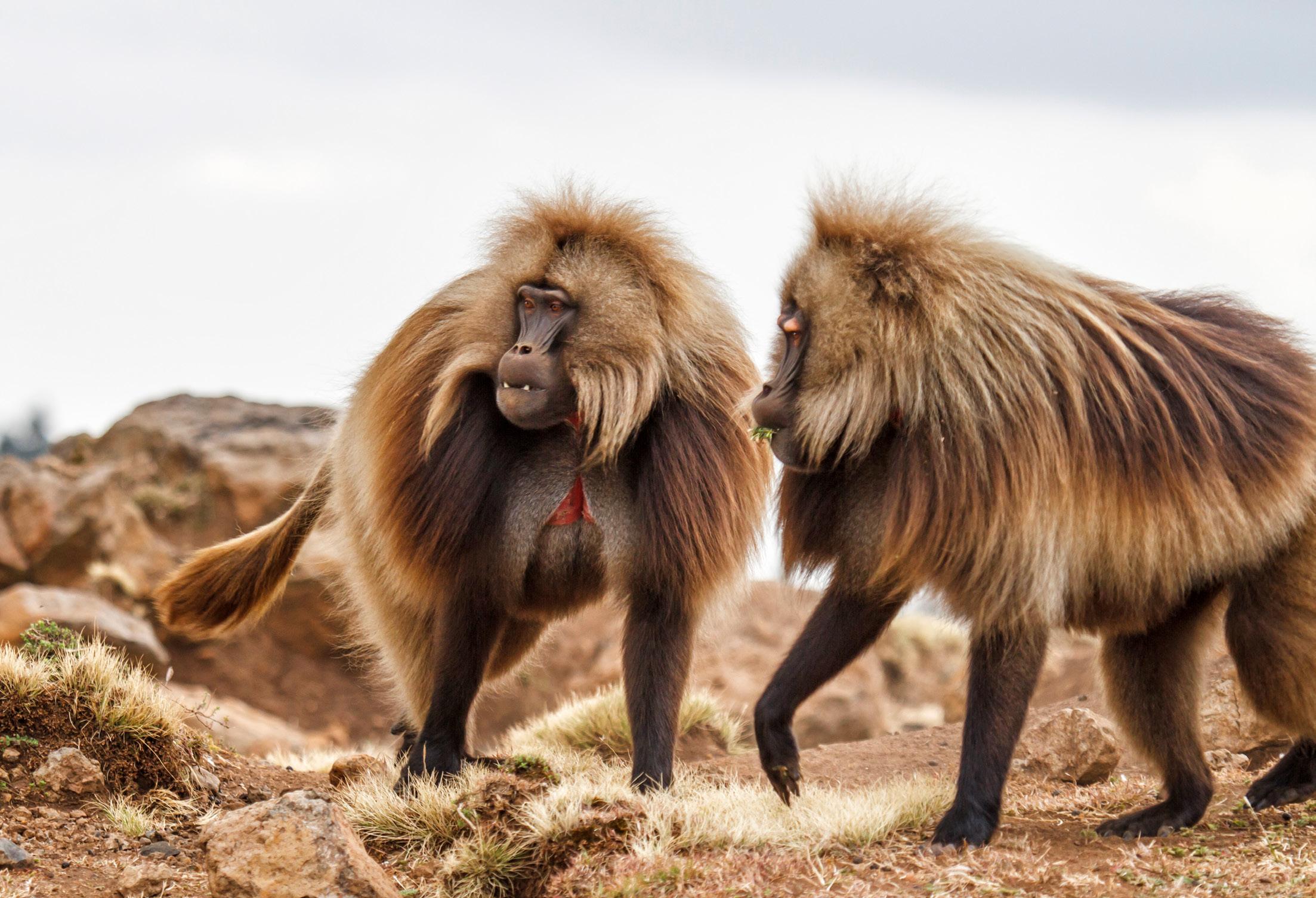
Sloth Known as one of the most relaxed animals in the South American rainforest, sloths spend almost all of their time hanging upside down from tree branches. They use most of their energy for eating and only come down from the trees to go to the toilet once a week! Meet our sloths in Cloud Forest alongside the Andean bears, howler monkeys, and bush dogs.
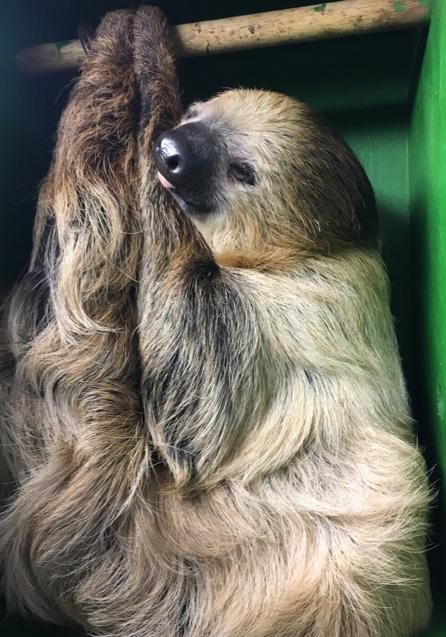
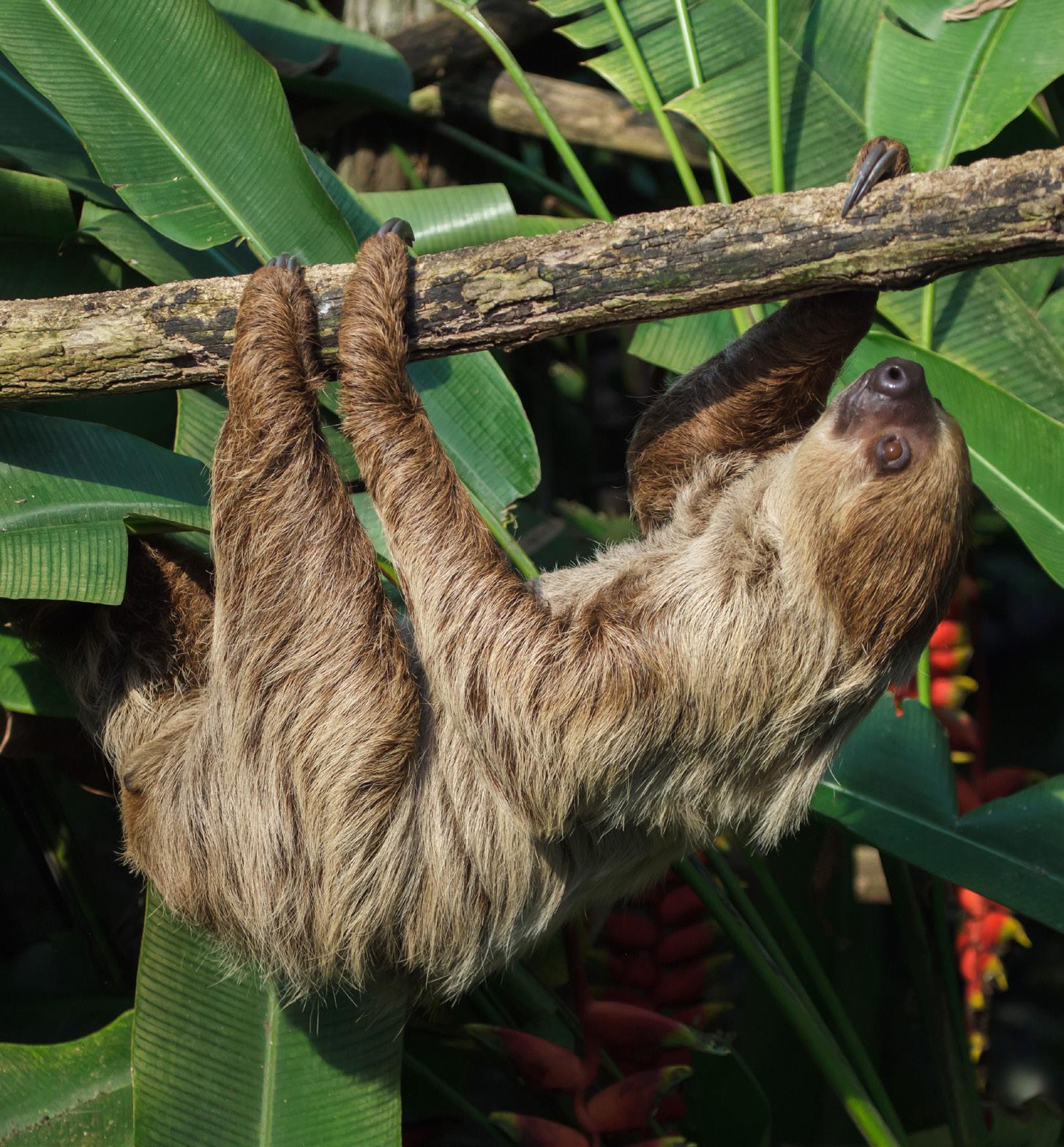
The masked booby is a marine bird found across the world’s tropical oceans, that gets its name from the black “mask” of skin around the base of its beak.
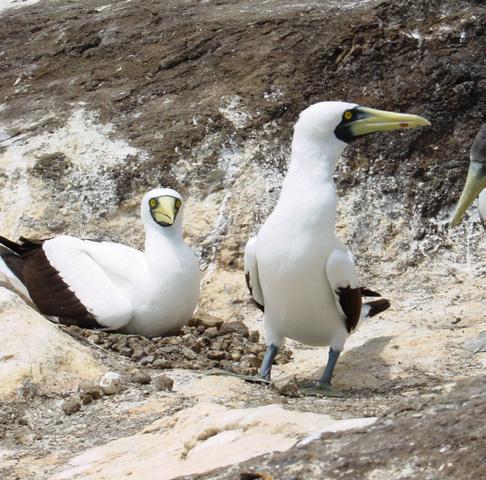
It currently breeds on Serpent Island in Mauritius, but not the neighbouring larger island of Round Island. It is thought this is due to masked boobies being sensitive to disturbance, so when goats and rabbits were present on Round Island this drove them from using the location as a breeding site. Now that goats and rabbits have been removed, the team are trying to encourage the birds to breed on the island using a very interesting technique… fake boobies!
The social attraction experiment is being carried out to see if the use of decoy masked boobies and recordings of booby calls will tempt the birds to use Round Island as a breeding site. A site at the north of the island – closest to Serpent Island – has been selected as the habitat is similar to the chosen breeding sites used by the birds on the other island. It is hoped that the masked boobies will begin to visit the island and it will become a permanent breeding site for the birds.
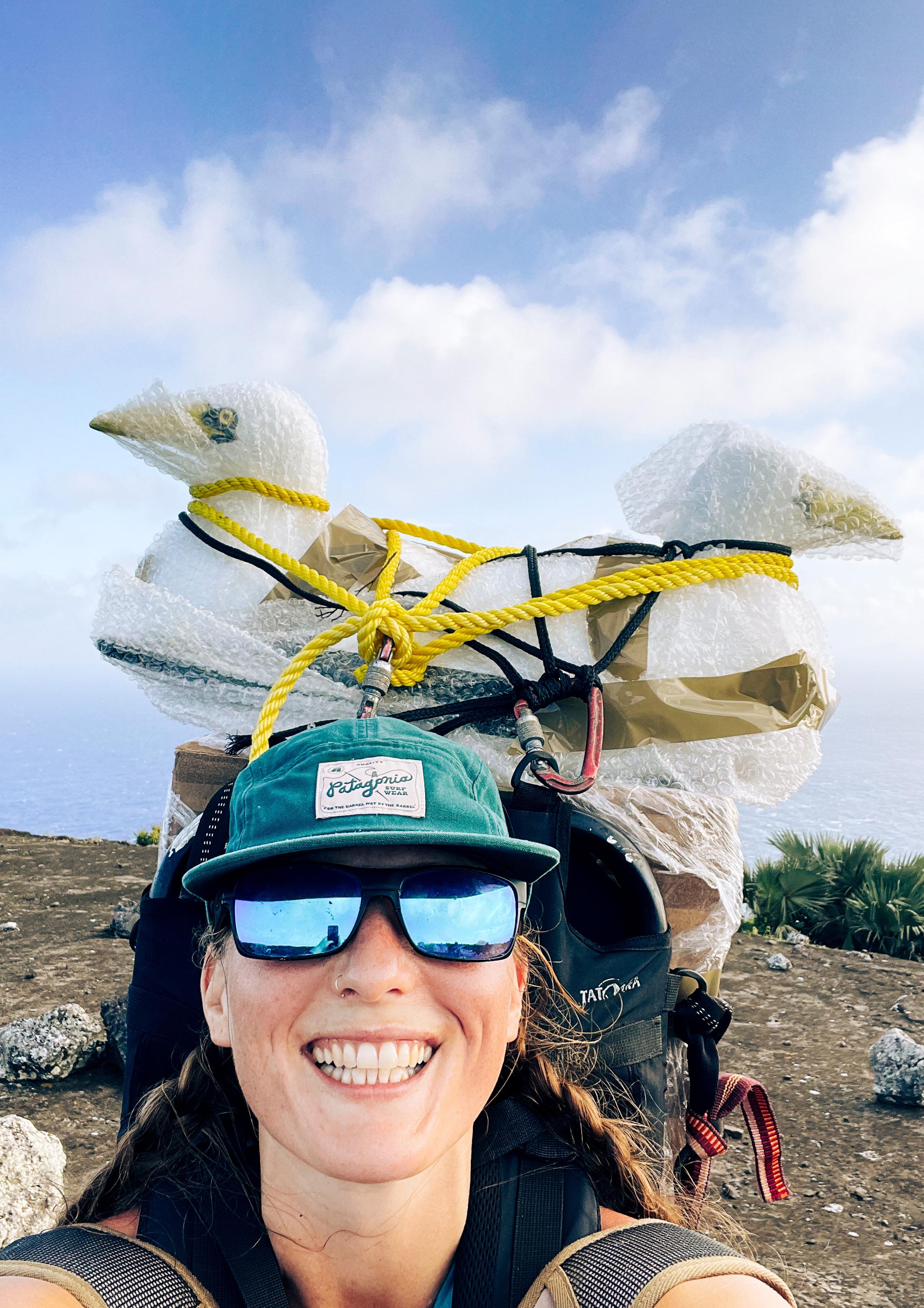
In May, 20 masked booby decoys were placed on the northern arm of the crater
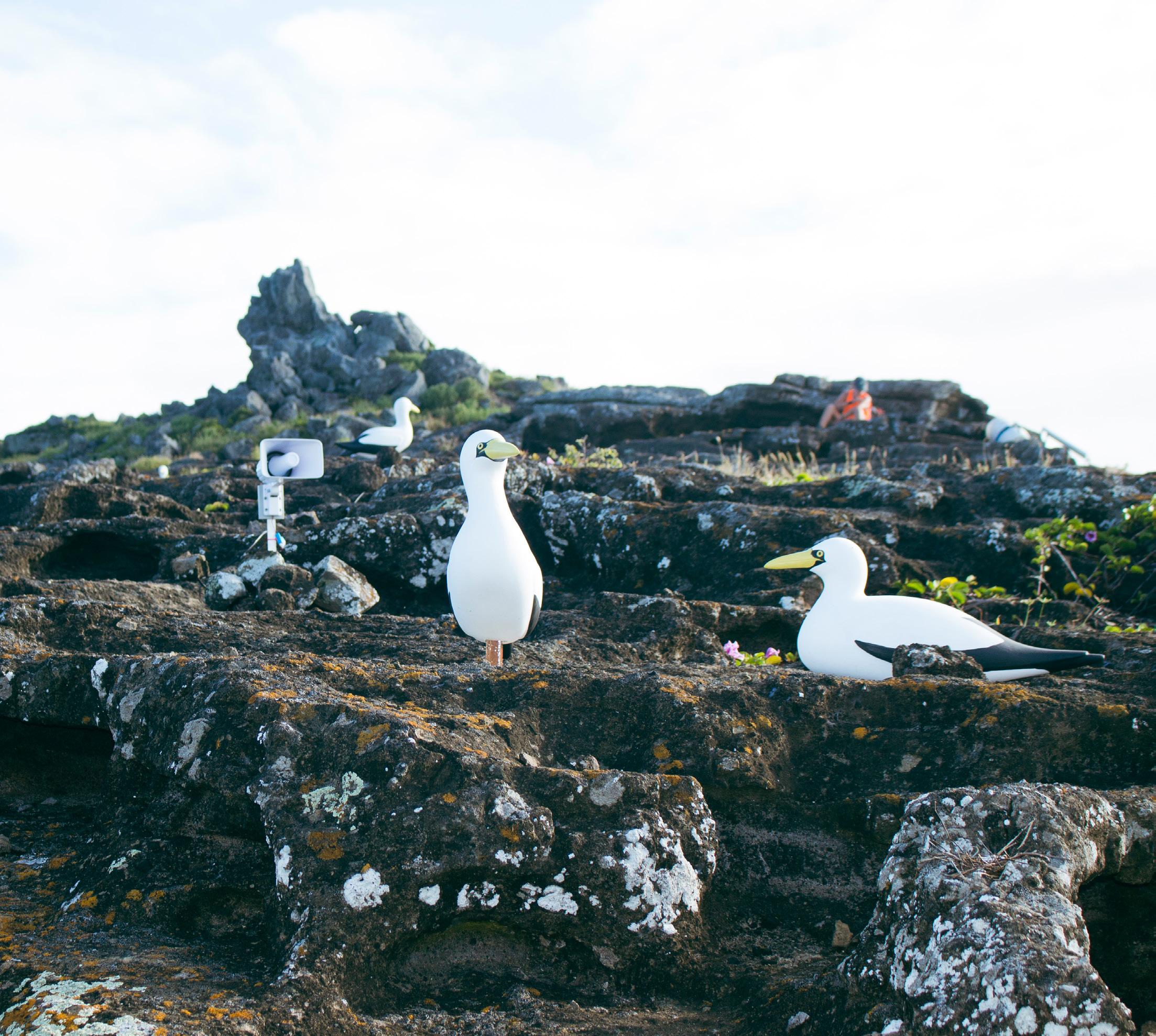
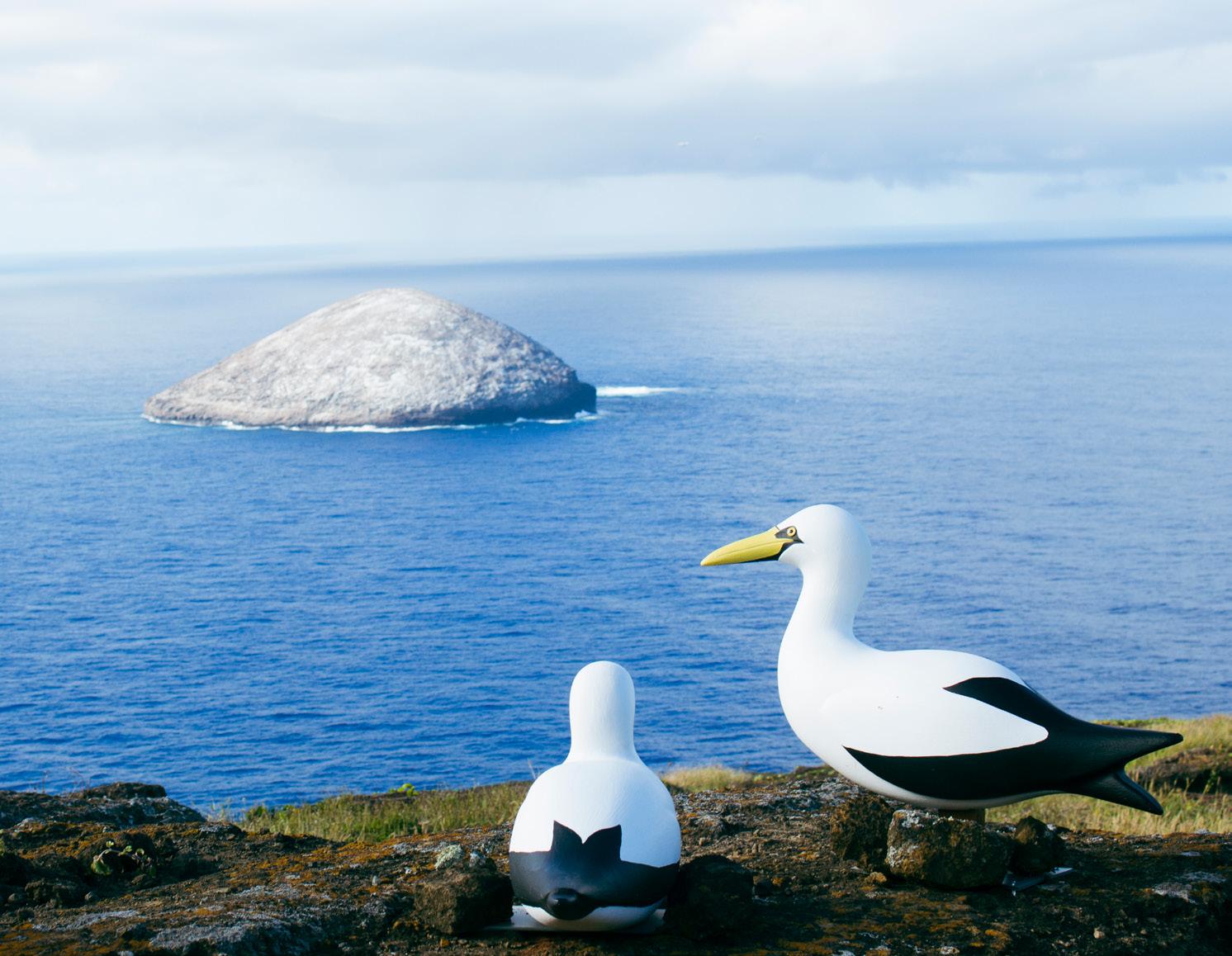
Masked booby calls are played 24/7 to try and attract the real birds to the site
Getting all of the equipment to the remote area of Round Island was a challenge – the team had to carry a 40kg battery, solar panels and all of the decoy birds
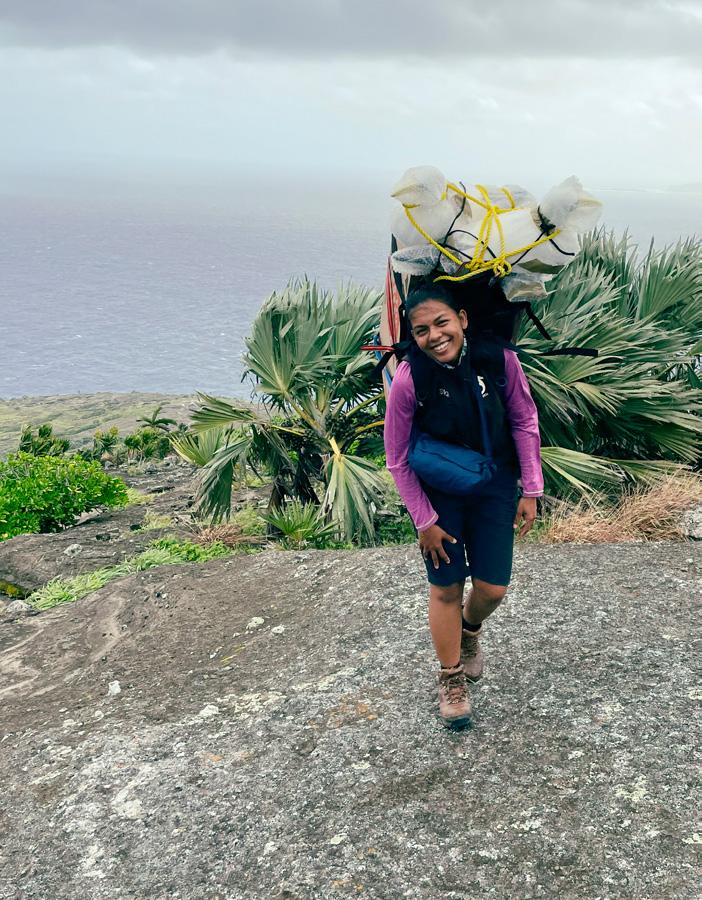
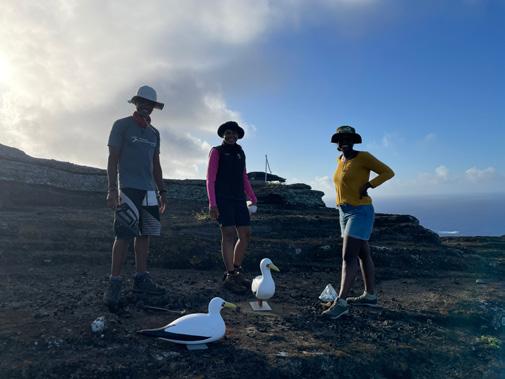
Alongside the decoys, a solar-powered sound system wasinstalled with two speakers
On Serpent Island, the boobies breed on sloped ground that is a lot steeper than the ground on Round Island. It is hoped that if the project on Round Island is successful, this means there won’t be any risk of eggs or chicks rolling into the sea!
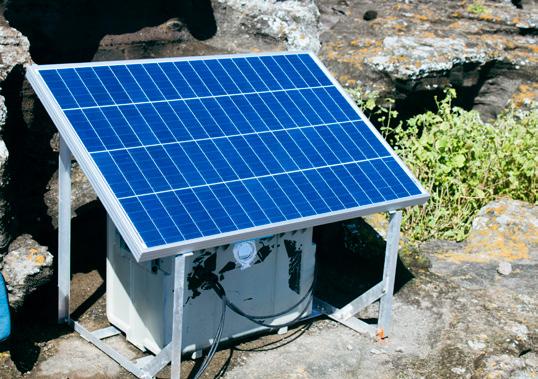
Our founder, Gerald Durrell, dedicated his life to the preservation of wildlife, especially the less popular species he called “little brown jobs”. These are not the charismatic megafauna but those important species that are under threat and overlooked. Durrell’s work today continues to focus on these lesser-known species, that serve key functions within their ecosystems.
The Saint Lucia racer is thought to be one of the rarest snakes in the world, with an estimated population of only 50 individuals. Once found across the Saint Lucia mainland, the snake can now only be found on Maria Major, a small offshore island. Invasive species, residential development and land conversion for agriculture have all contributed to the population decline of not just the racer, but wildlife across Saint Lucia. Saint Lucia racers eat small rodents and lizards, and a healthy population
of snakes keeps the populations of their prey under control and encourages a healthy ecosystem. In Saint Lucia, we’re establishing a captive breeding facility for the racer to secure a safety net population. Our team carries out regular surveys of Maria Major to monitor the current wild population, and recent sightings of juveniles mean the Saint Lucia racers are reproducing.
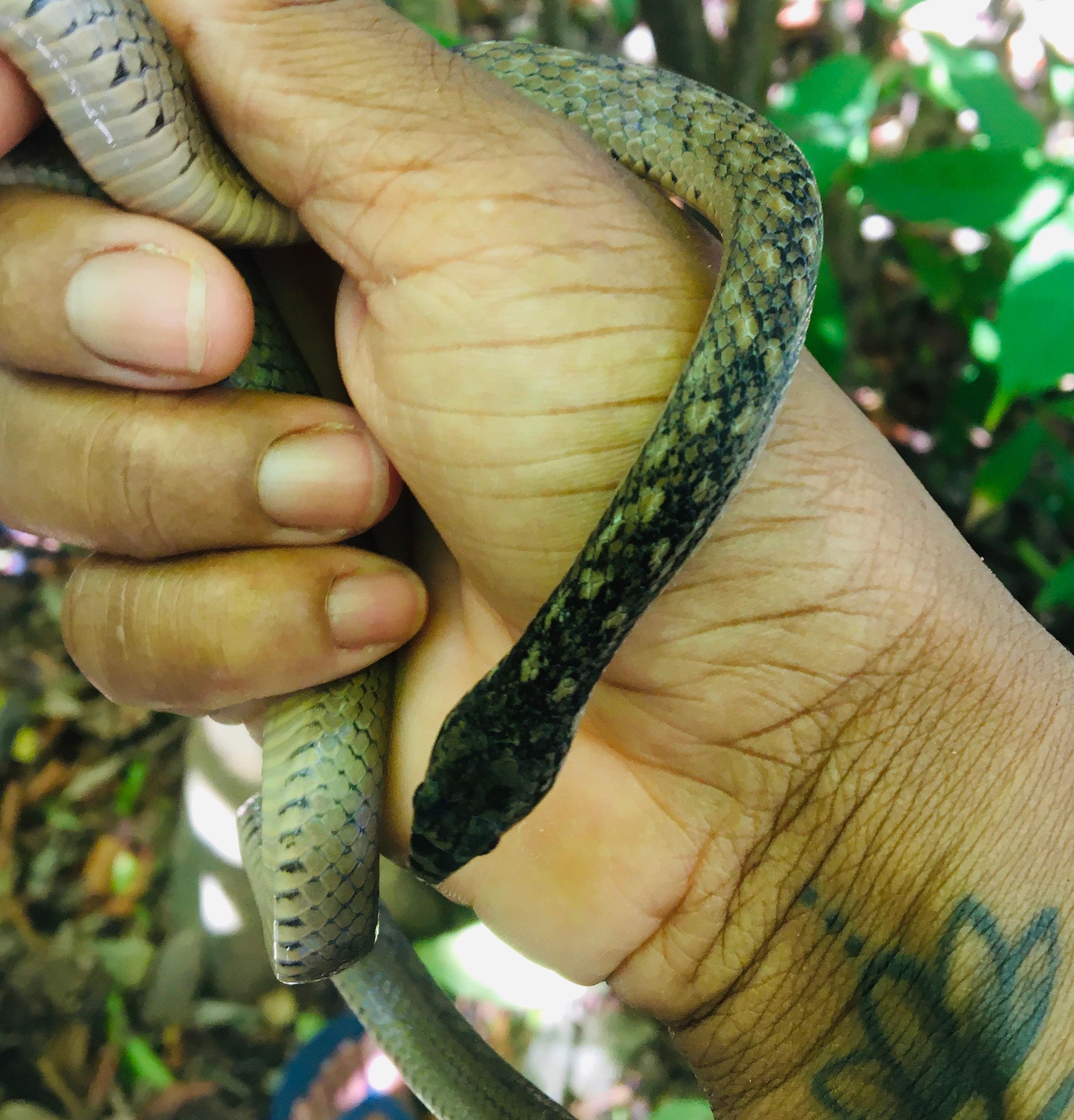 DURRELL.ORG/SMALLBUTMIGHTY
DURRELL.ORG/SMALLBUTMIGHTY
Once thought to be extinct, the world’s smallest pig, the pygmy hog, is also one of the world’s most threatened mammals. Historically found across many of Assam’s grasslands, habitat loss led to only one wild population remaining in Manas National Park. These hogs are an indicator species meaning their presence shows a healthy ecosystem. They are sensitive to environmental changes, so when the grasslands start to disappear, their numbers decrease before the other larger, less sensitive species like elephants, rhinos and tigers. We began working with pygmy hogs in the 1970s, and in 1995 formed the Pygmy Hog Conservation Programme. We have two pygmy hog captive breeding centres in Assam, from which we have now released over 150 captive bred hogs into four protected grasslands of Assam.
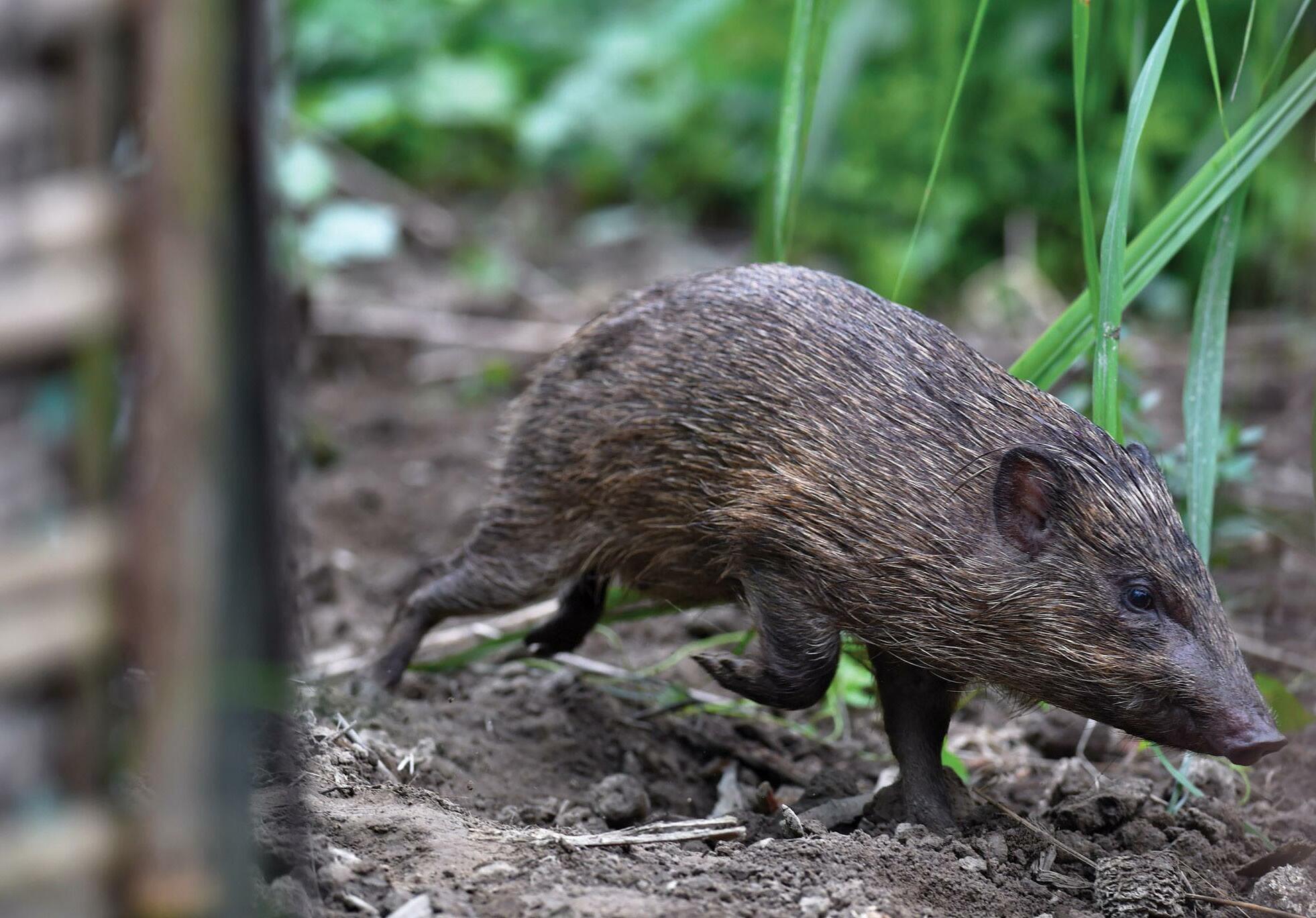
The Madagascar pochard was thought to be extinct for 15 years before a population was found surviving on a remote lake in 2006. A lack of invertebrates in the lakes due to increased siltation and invasive fish led to the decline of pochard populations, caused by human exploitation of the environment. Unique to Madagascar, pochards need healthy wetlands to survive. We have been working to restore the wetlands of Madagascar through rewilding and community education to prevent overexploitation of natural resources. A captive breeding programme for the pochards was established in 2009, with the first ducks hatching in 2011. Since then, the birds have been successfully breeding in captivity, and in 2018, a group of 21 individuals were released into the wild for the first time.
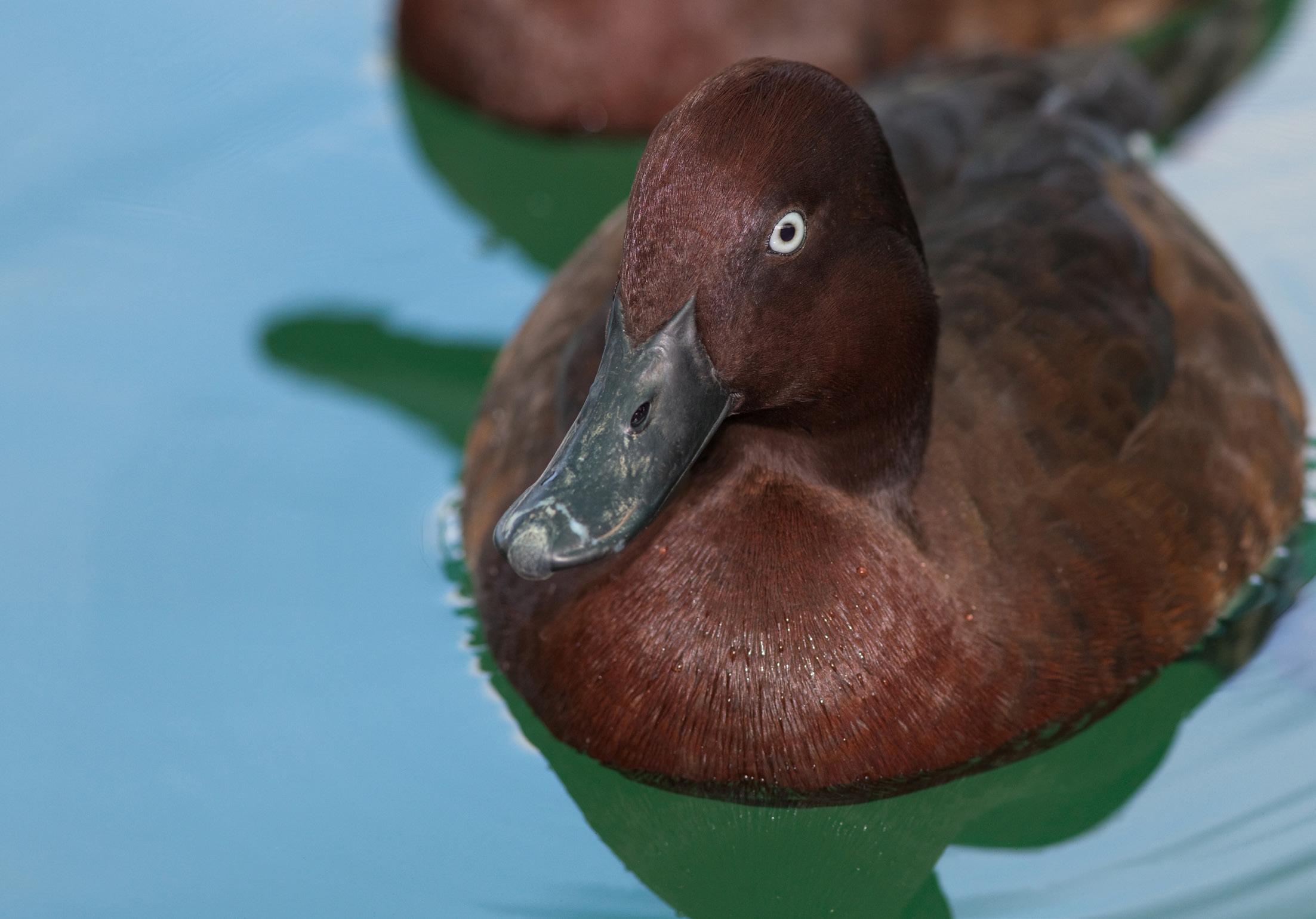
Now found only in fragments of forest in western Madagascar, the Malagasy giant jumping rat is under threat from habitat loss caused by logging, damaging agricultural practices and charcoal production, as well as climate-related issues. Their underground complex of burrows provides a safe place to sleep during the day, and at night they forage for fallen fruits, leaves and seeds. Their diet means they are vital to the ecosystem as they disperse seeds
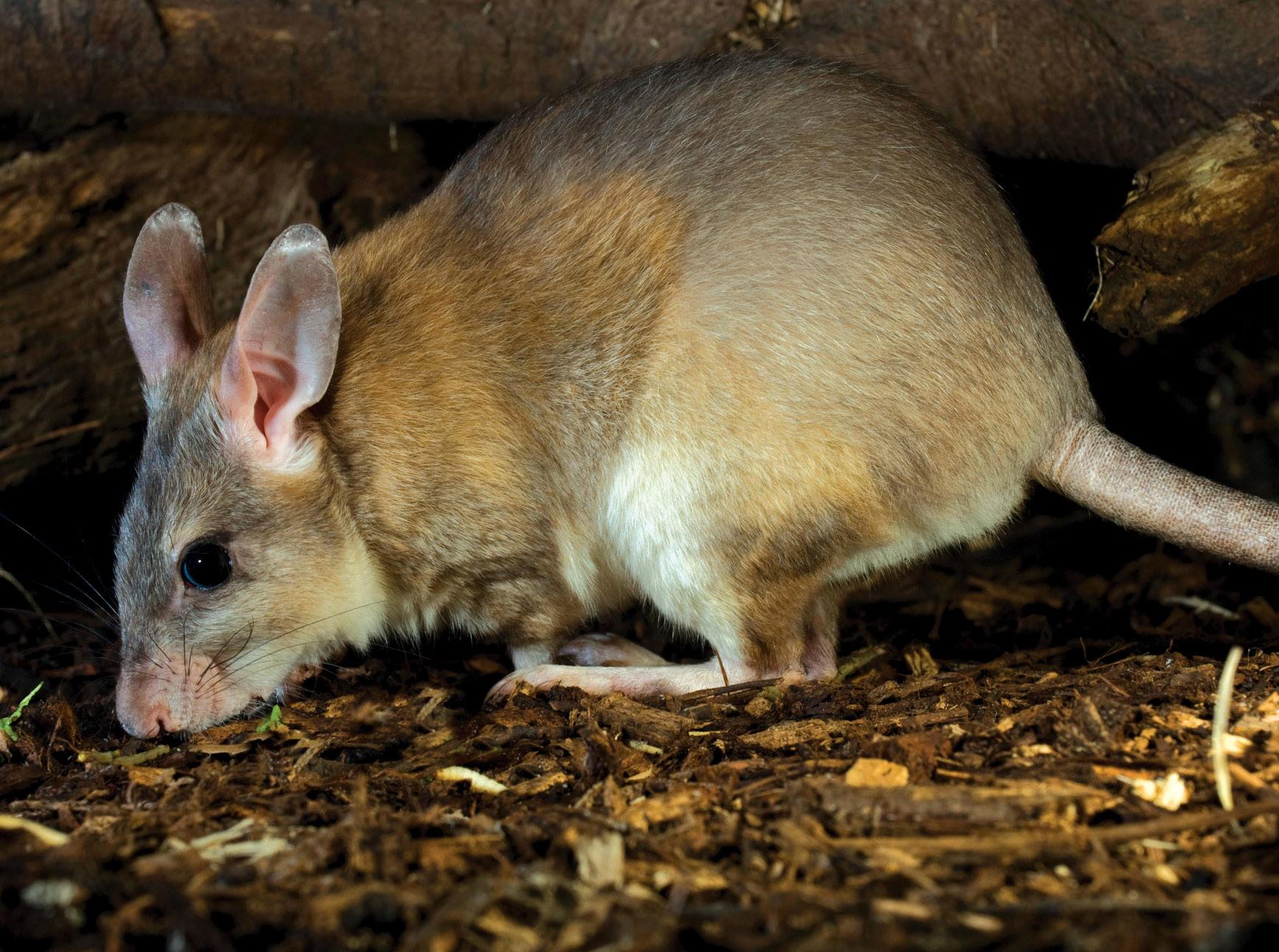
throughout the forest, and by digging burrows they aerate the soil, keeping it healthy so more crops and trees can grow. Our team in Madagascar have been working to safeguard the species’ future since the 1990s, and Jersey Zoo established the first captive population. Whilst the forests where the giant jumping rat is found is now a protected area, the habitat still faces illegal deforestation and other climate-related changes.
Bouton’s skinks are unique to the offshore islands of Mauritius. They serve an important role within the ecosystem as predators or prey of other threatened animals, but also as pollinators and seed dispersers of rare plant species. Only a few hundred individuals remained in Mauritius, and in 2020 the survival of the species was pushed further under threat due to a devastating oil spill off the island’s south coast. Bouton’s skinks were one of the three precious reptile species that were urgently collected and transported to Jersey Zoo to establish a captive breeding programme to create safety net populations. With the expert knowledge and care from our herpetology team at the zoo, the Bouton’s skinks have begun to breed, securing the future of the species in Jersey whilst teams work in Mauritius to monitor the islands and the impact of the oil
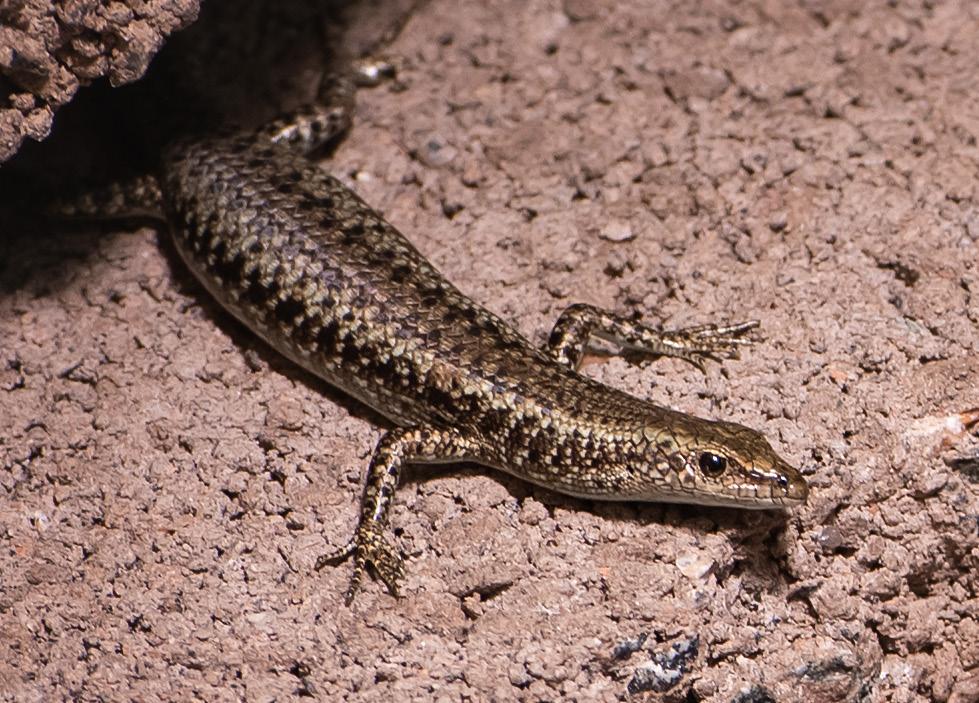 Malagasy giant jumping rat
Malagasy giant jumping rat
Found only in the Atlantic Forest in Brazil, black lion tamarins are under threat from deforestation, which leaves populations isolated in fragmented patches of forest. These small primates act as farmers, as by eating fruits they then disperse seeds throughout the forest, helping plants that feed the wildlife to spread. We’ve been working with black lion tamarins for over 30 years, and
Jersey Zoo is the only place outside of Brazil where you can see the species. Our work with these primates in captivity helps us to better protect them in the wild. Our Rewild Carbon programme funds the planting of trees to reconnect the Atlantic Forest, helping black lion tamarins and other species that call the forest home.
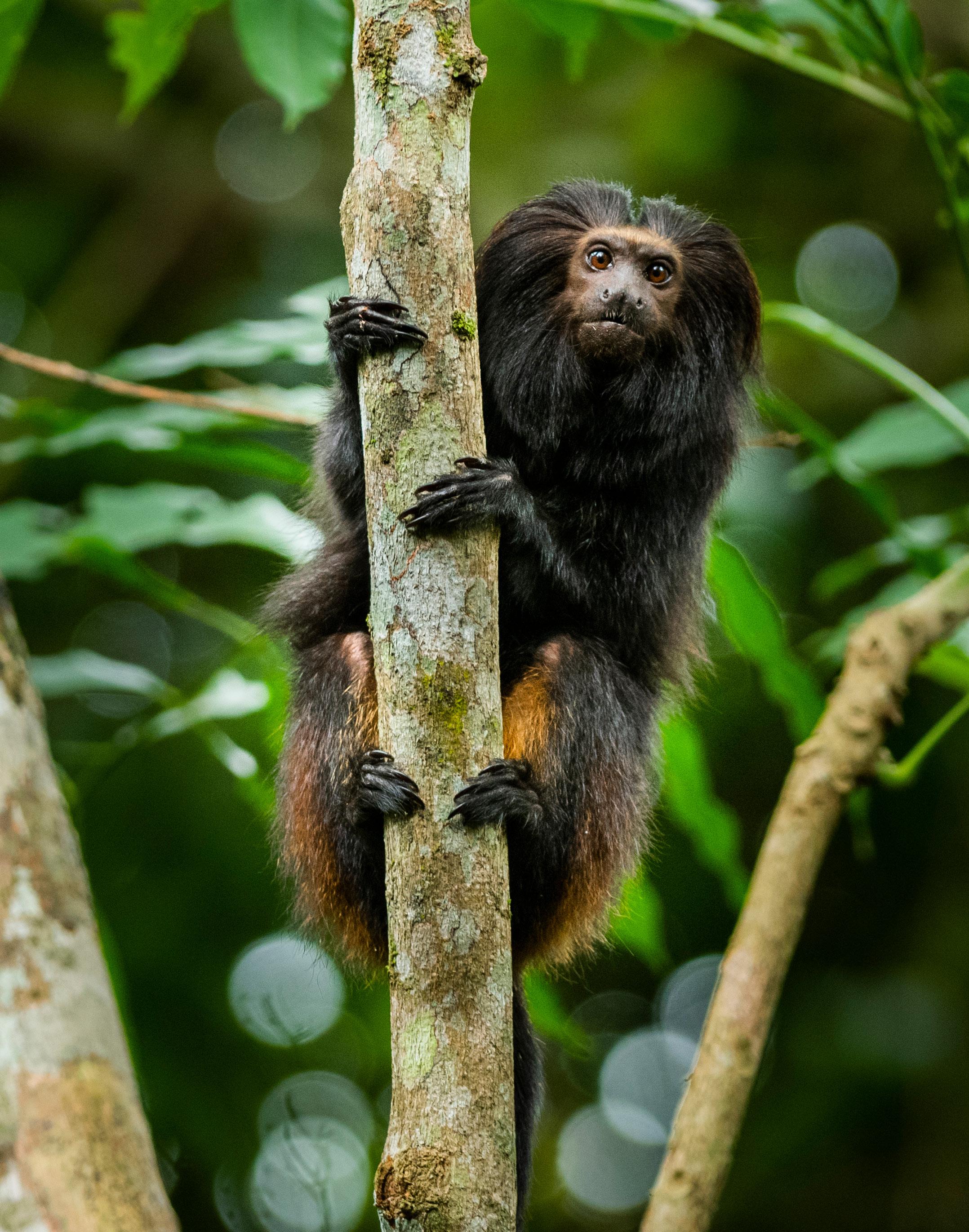 Black lion tamarin
Black lion tamarin
He’s back, and a bigger than ever! Will Highfield, aka the Jersey Gorilla, recently took part in the London Marathon in his biggest and heaviest suit yet. He impressively ran the 26.2 miles in an 8kg gorilla suit in aid of Durrell’s mission to save species from extinction. Will has taken on a number of running challenges over the years and has so far raised a remarkable £65,000 for Durrell!
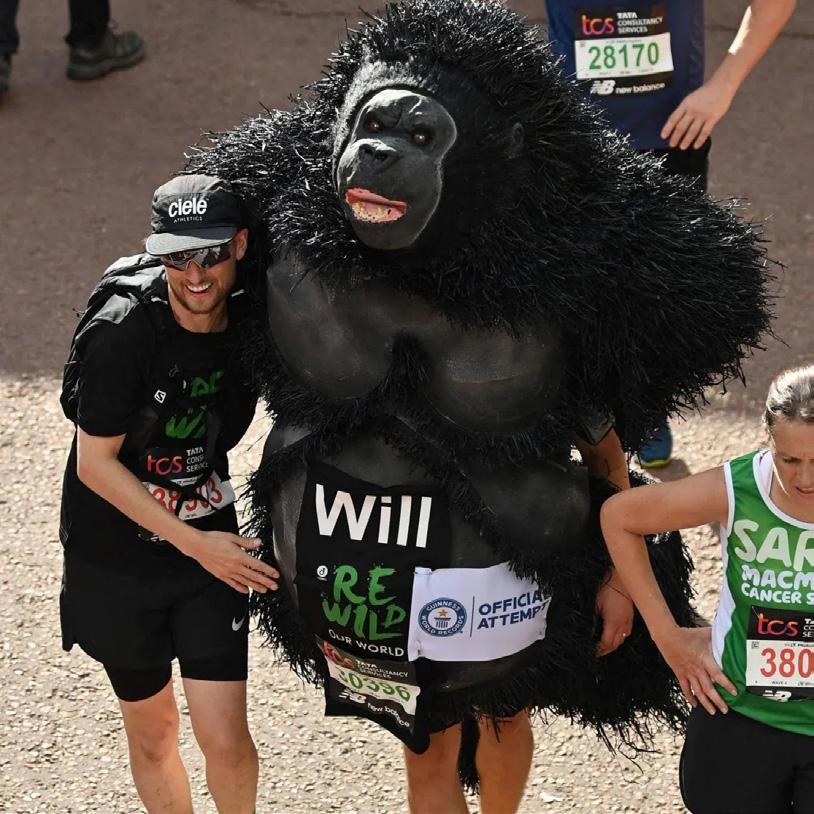

The Jersey Gorilla crossed the line in 4 hours 27 minutes and 52 seconds. We’re sure this accelerating ape resulted in a few surprised expressions too. You can still support Will via his JustGiving page justgiving.com/ fundraising/will-highfield5 or follow him on Facebook @JerseyGorilla
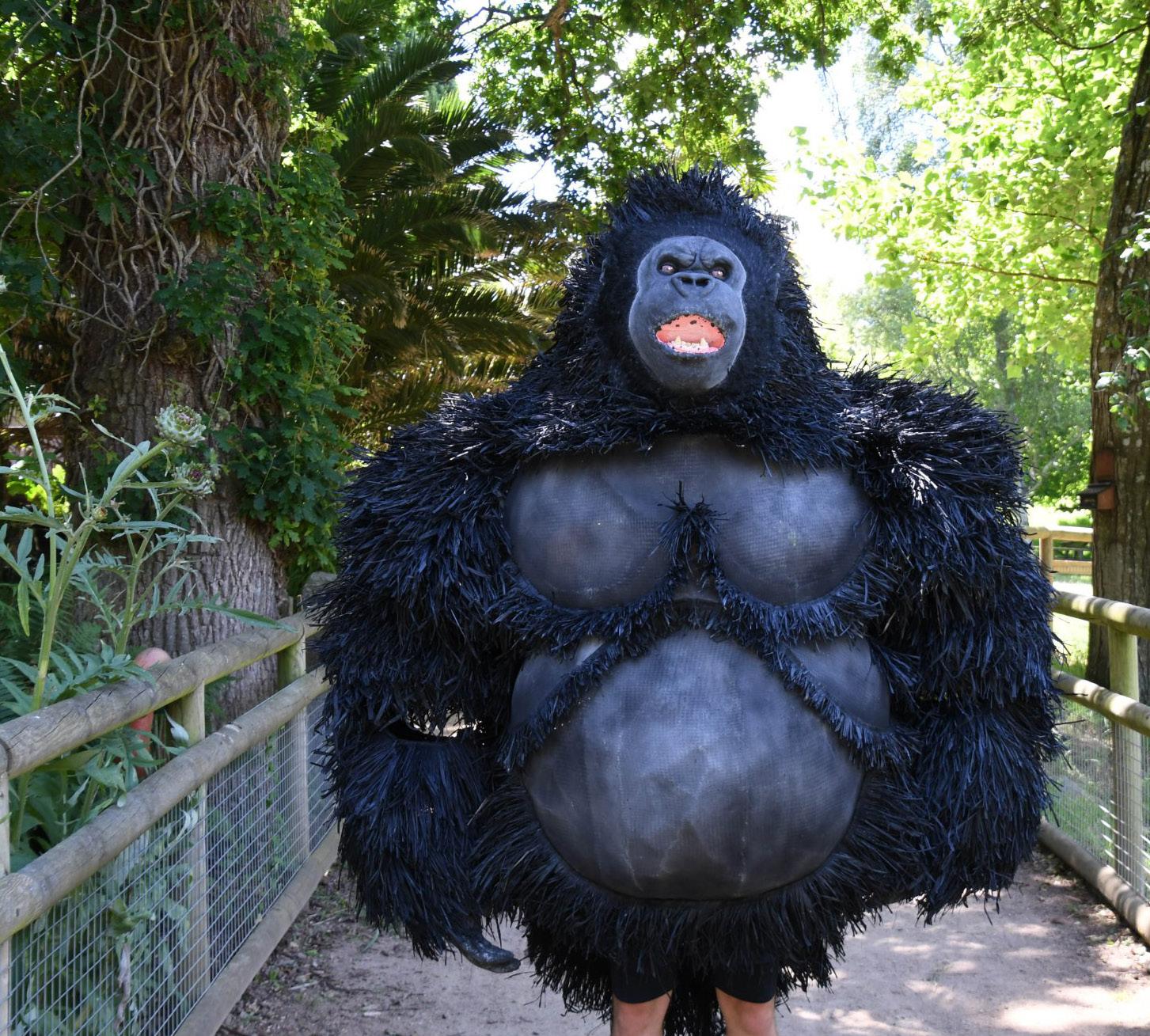
We are so grateful to our fundraisers, members and sponsors and would like to say a huge thank you to everyone who has supported us. We hope some of the ways supporters are helping to save wildlife will also inspire you.
July saw the return of Durrell’s Go Wild Golf Day, generously sponsored by Rathbones. This year’s event hosted 22 teams, guest speaker Derek Redmond, and two touring tortoises! The teams played 18 holes, followed by a speech from the worldrenowned athlete, and managed to raise a whopping £9,862. All funds go towards saving vulnerable species from extinction across the world.
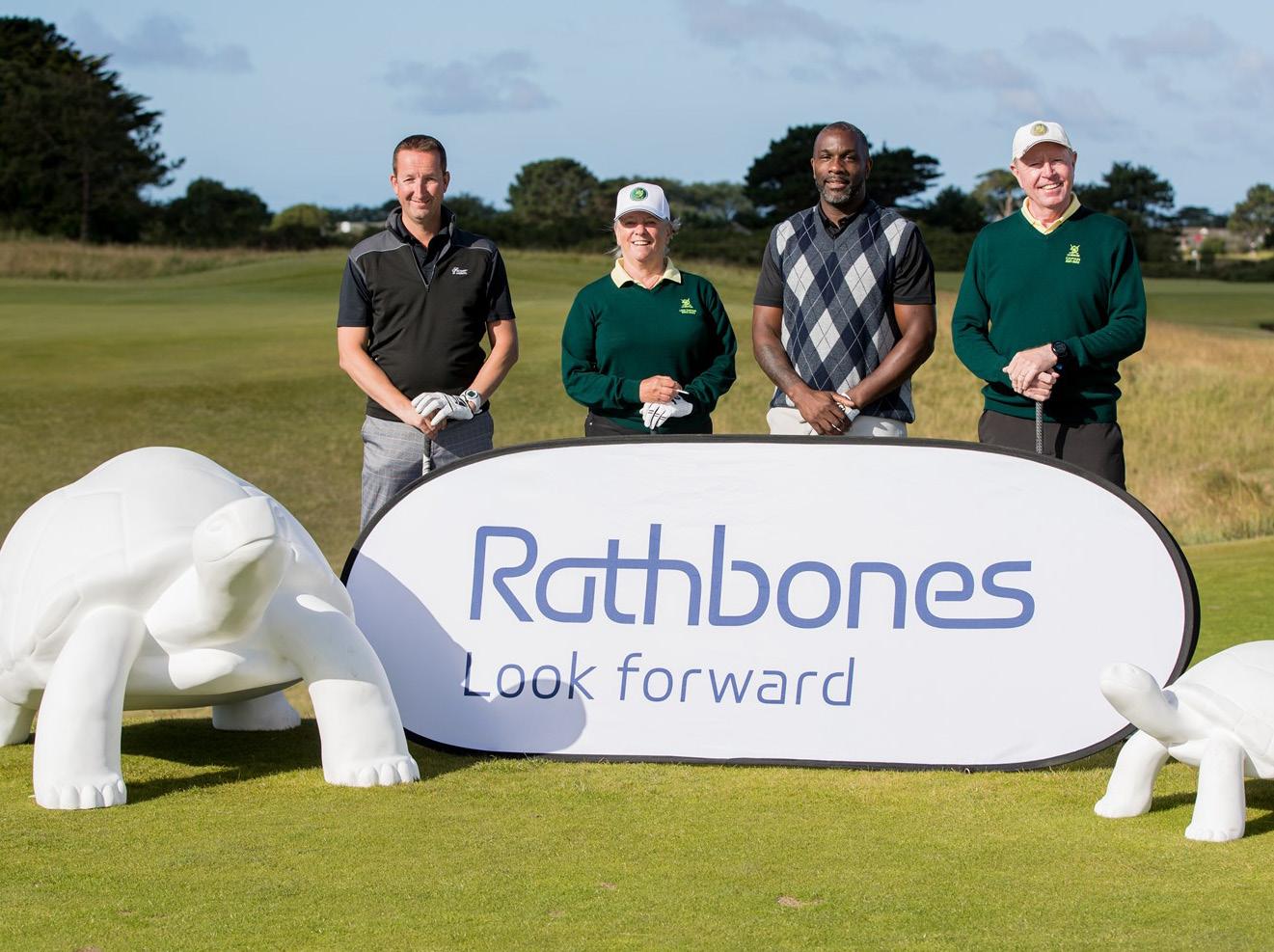
Want to get involved in next year’s Go Wild Golf Day? Reserve your team’s place by emailing zoe.levar@durrell.org
The countdown continues for the Dragonfish Row across the Atlantic! In December, Peter Wright and Steve Hayes will row 3,000 miles from Spain to Antigua, taking on “the world’s toughest row”. More people have been to space than completed this row!
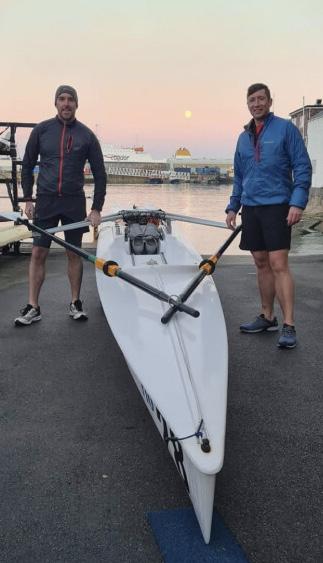
Wright and Hayes hope to raise £50,000, half of which will go to Macmillan and the other half to Durrell to support our conservation of the Atlantic rainforest. Wishing you the best of luck, Steve and Peter!
Show your support by visiting www.dragonfishrow.com
Thank you to the Duck Company UK (DCUK), who came up with the brilliant and unique idea to auction off a one-of-a-kind carved wooden Dodo. DCUK set up a JustGiving, and anybody who donated £2 or more to Durrell was entered into a raffle to win this handsome model. DCUK raised over £1,300 with 214 entries. Thank you so much DCUK, and congratulations to the winner!
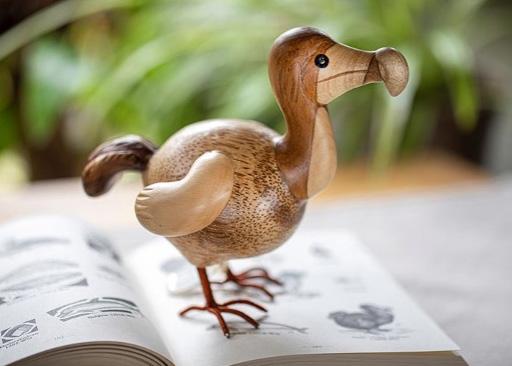
In June, the team that brought you Go Wild Gorillas announced they would once again be deploying giant animal sculptures across Jersey!
In the summer of 2023, the Tortoise Takeover will place dozens of uniquely designed tortoises across Jersey’s wild places, coastal vistas and urban hangouts. The trail is already proving to be hugely popular with all 50 giant tortoises now sponsored by local businesses. A special thank you to Presenting Partners of the trail, Ports of Jersey and Blue Islands. Thanks also goes to RBC as Education Partner and BDO & C5 Alliance as Community Partner.
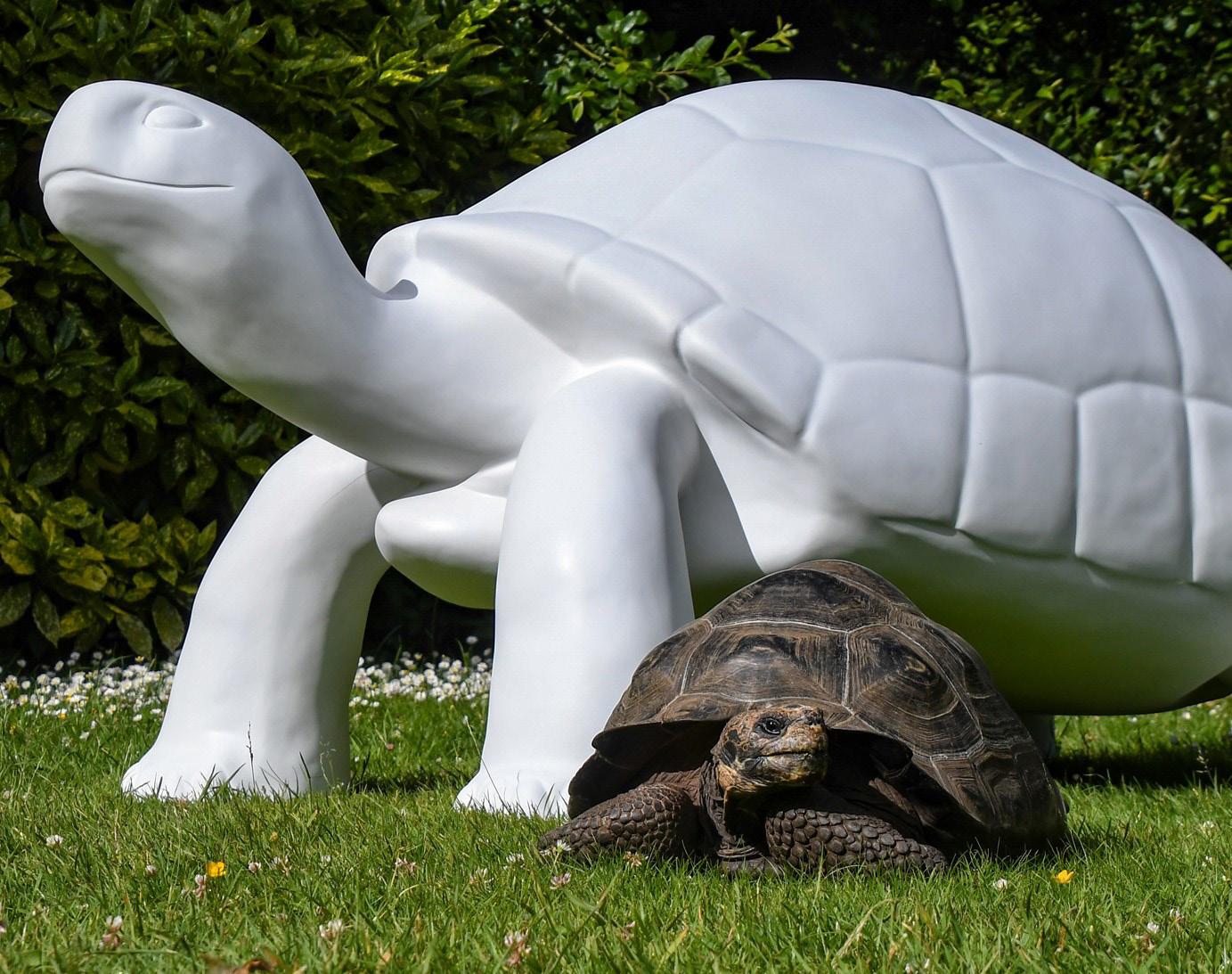
Visit www.tortoisetakeover.org to find out more or follow Tortoise Takeover on social media to watch the trail unfold: Facebook @JerseyTortoises
In July, Charlie McCafferty took a fearless approach to fundraising in the form of wing-walking! Setting out to raise funds for the JSPCA and Durrell, Charlie raised an amazing £1,105 for Durrell, while making considerably unique memories in the process! Thank you, Charlie.
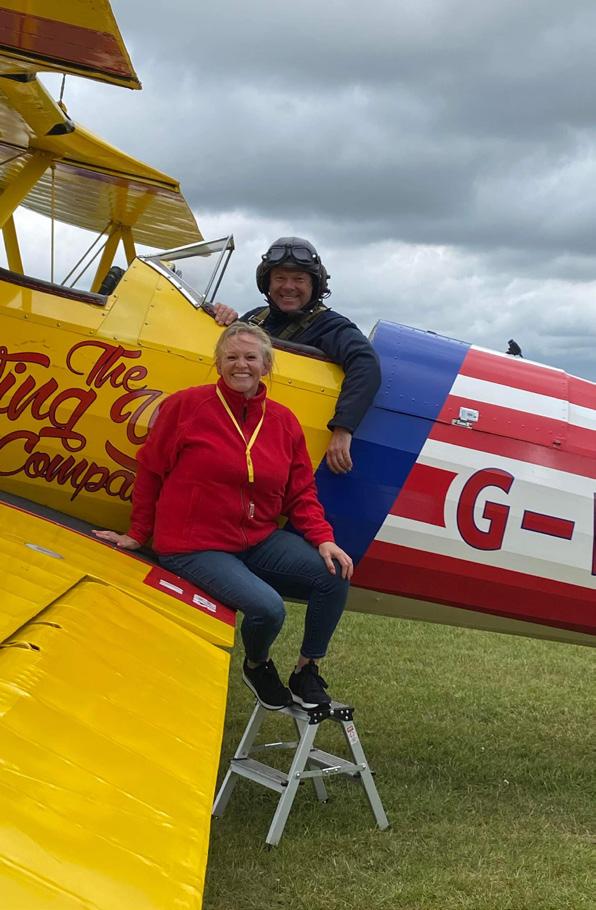
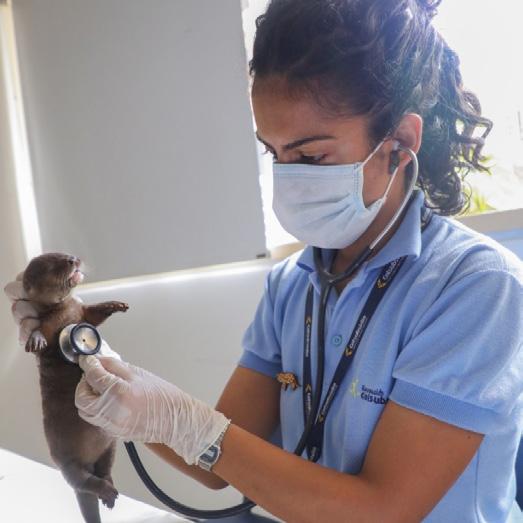
Gerald Durrell recognised that saving endangered species and their habitat depended on the skill and dedication of people working in the countries where they are found. In 1984, Gerry founded the Durrell Conservation Academy as a place to share the knowledge and expertise with these passionate individuals from around the world who were determined to make a difference.
By championing the conservationists of tomorrow, the global impact of Durrell reaches far beyond our own projects and success. By sharing our skills, we can unlock and maximise the potential of other individuals and organisations. The Durrell Endangered Species Management (DESMAN) course aims to do just that. Each year, the course brings conservation professionals from across the globe to our Academy in Jersey, where they spend 12 weeks developing their skills to better equip them to lead or work on conservation projects to save the world’s rarest wildlife. This year’s Autumn DESMAN course has brought 11 conservationists from 11 different countries to Jersey.
“I have spent four and a half years contributing to the conservation of the critically endangered great green macaw in Costa Rica. Having worked all this time with a critically endangered species, I think the DESMAN course can provide me with an invaluable opportunity to develop new conservation tools and apply them to conserve this species in Central America.”
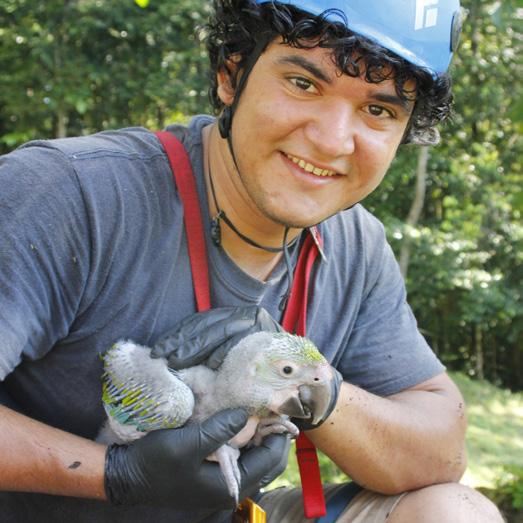
“I currently work at a zoo located in one of the most endangered ecosystems in Colombia, a tropical dry forest. We have three conservation projects for endangered species – the white-footed tamarin, Orinoco crocodile and blue-billed curassow. The DESMAN course will help to improve my contributions to these projects and give me the skills to develop new projects with other species of interest, not only those under our care but also endemic species of the surrounding ecosystem.”
“In my role, I have learned how to operate as a field guide and ranger, and conduct conservation-related research, particularly of leopards. The DESMAN course will be hugely beneficial to my professional development, as I aspire to become a future conservation leader.”
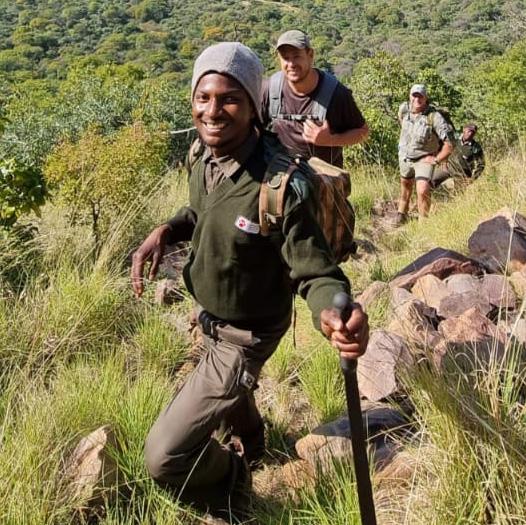
Science Coordinator – Seychelles Islands Foundation, Seychelles
“I have been involved with three successful eradication projects in the Seychelles, which aimed to protect endemic land bird species on the islands of Aldabra and Praslin. The DESMAN course will elevate my knowledge, field experience, and all the necessary conservation management skills to increase the research standard in Vallée de Mai and ensure the survival of the flora and fauna of our UNESCO World Heritage Site.”
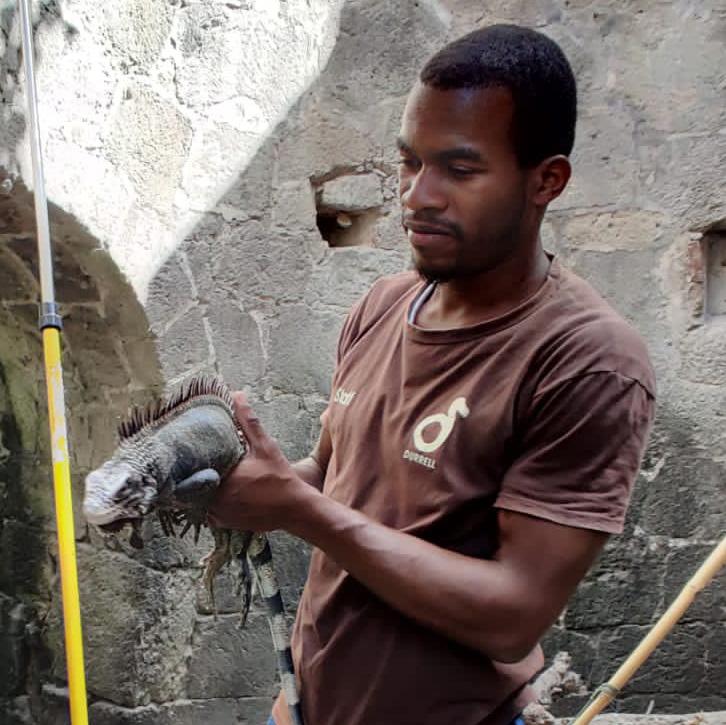
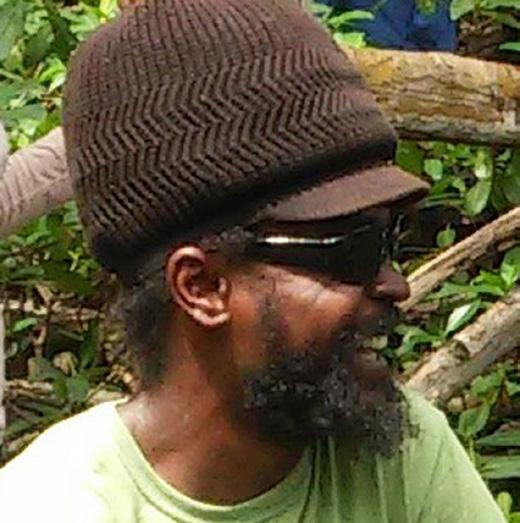
Field Manager – Sumatran Orangutan Conservation Programme (SOCP), Indonesia
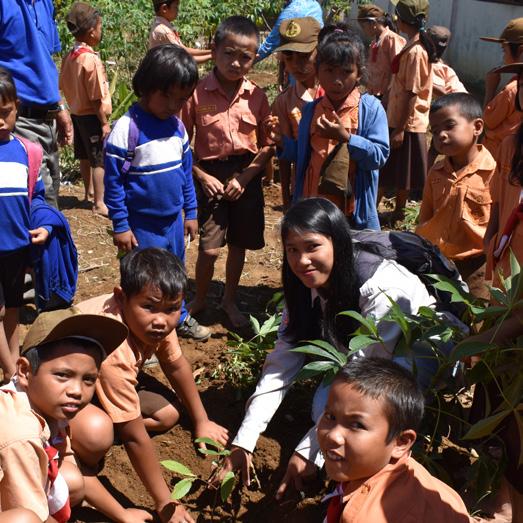
“I have worked at SOCP for 12 years, with my responsibilities ranging from community outreach to staff management and implementing project activities. I hope the DESMAN course will enhance my leadership skills and give me new insights and knowledge on the need to balance wildlife and habitat conservation with the needs of local communities. I feel this is the key to successful conservation in the future.”
Head Keeper – Mountain Marmosets Conservation Centre (MMCC), Brazil
“I studied at the Chico Mendes Institute for Biodiversity Conservation, and I enthusiastically dedicate myself to scientific research, having received two awards from the Brazilian Society of Primatology. The DESMAN course will be very enriching for my personal and professional development, and the knowledge I gain will be applied at the MMCC and, therefore, in the conservation of mountain marmosets.”
Senior Conservation Officer –Tanzania National Parks, Tanzania
“I manage the database on wildlife ecology, veterinary and community relations across Tanzania. Previously, I worked at the Mkomazi National Park, where I led several conservation projects.
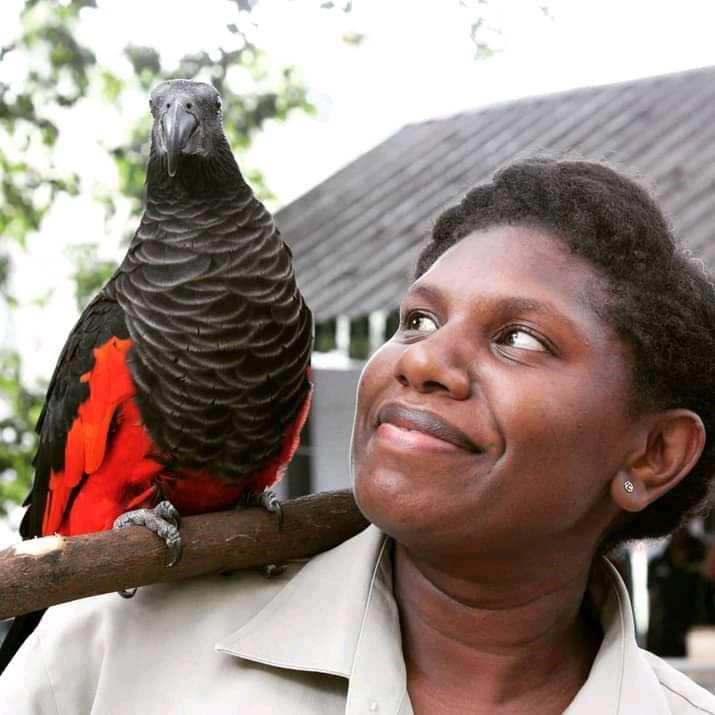

On the DESMAN course, I hope to learn how to work with local and international communities to conserve endangered species, develop my fundraising and leadership skills, and network with other participants and experts.”
“I have participated in several major projects including the Australian Aid forest rehabilitation project, Iyanola project (inventory of flora and fauna), Saint Lucia parrot survey and white-breasted thrasher population survey. I aim to use the skills and knowledge attained on the DESMAN course to assist in all aspects of our forestry work, including wildlife management, watershed management, community outreach and environmental education.”
“I have lots of experience volunteering at different conservation organisations and I worked as a Wildlife Keeper for four years. The DESMAN course will help me develop my skills in population monitoring and planning species recovery projects, for example, with endangered turtles that are unsustainably harvested for human consumption. It will also help me create conservation modules for students at my university.”
Veterinarian – Talarak Foundation, Philippines
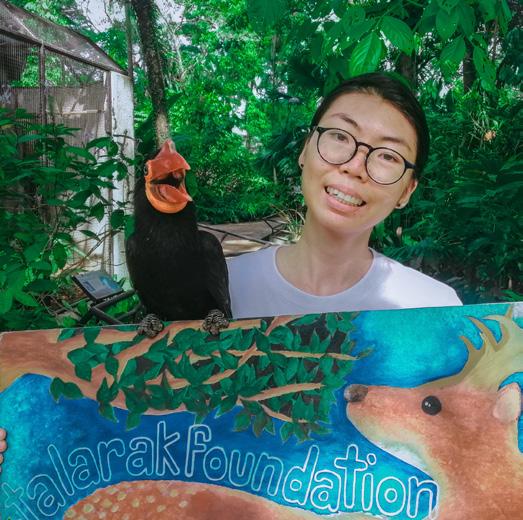
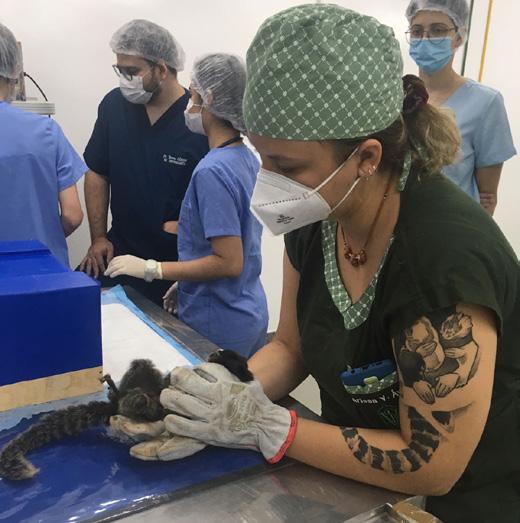
“Under my care are many endangered species from the island of Negros. I am responsible for managing the breeding programmes and evaluating the animals’ health and welfare. On the DESMAN course, I hope to develop my management, leadership, and research skills, and increase my awareness of current issues and practices of conservation. Being exposed to advanced veterinary practices, medicine, and husbandry will greatly help the animals I work with.”
“I have worked in ecology for seven years now, with six of those at the Department of Environment. During this period, I have gained skills in bird identification and developed my knowledge in the husbandry of mountain chicken frogs, as well as the island’s flora. The DESMAN course will not only expand my knowledge and experience in different areas of ecology, but it will also place me in a position to implement certain conservation strategies in various aspects of my work.”
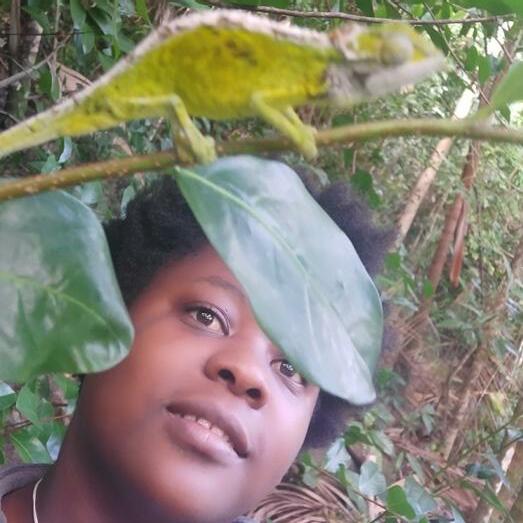
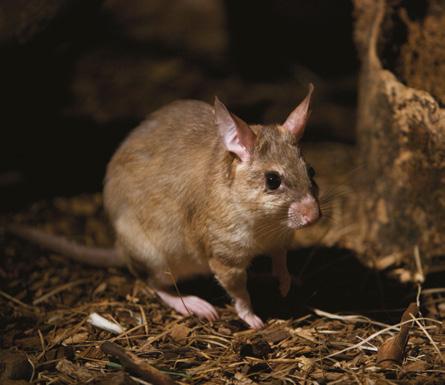
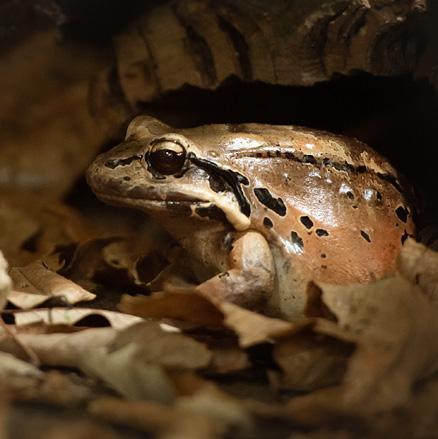
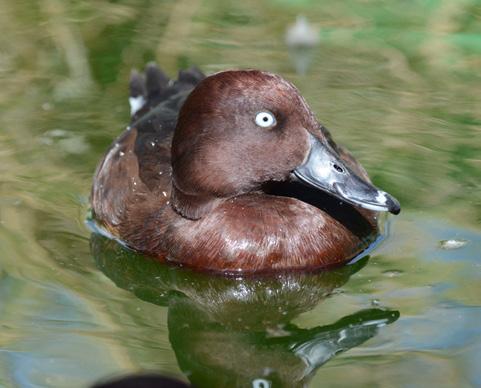
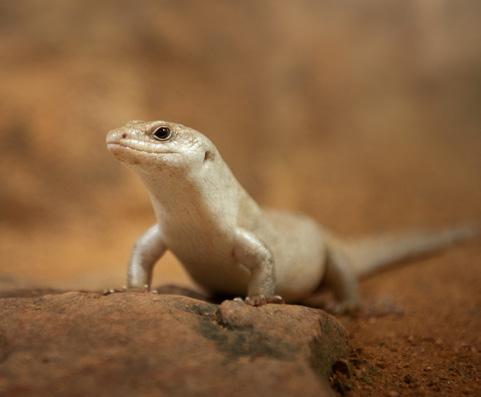
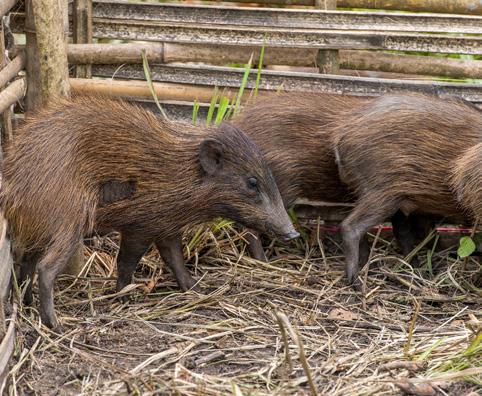
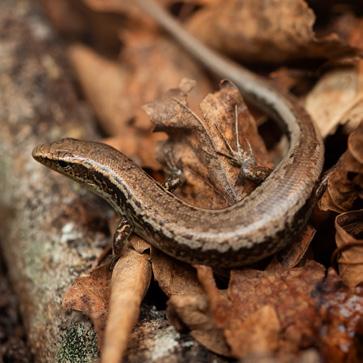
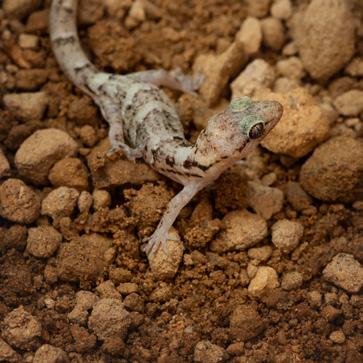
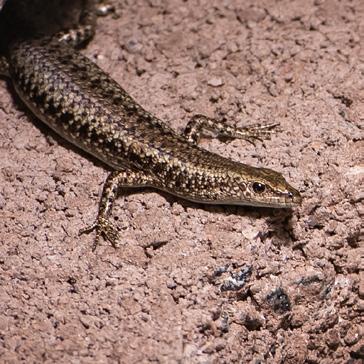
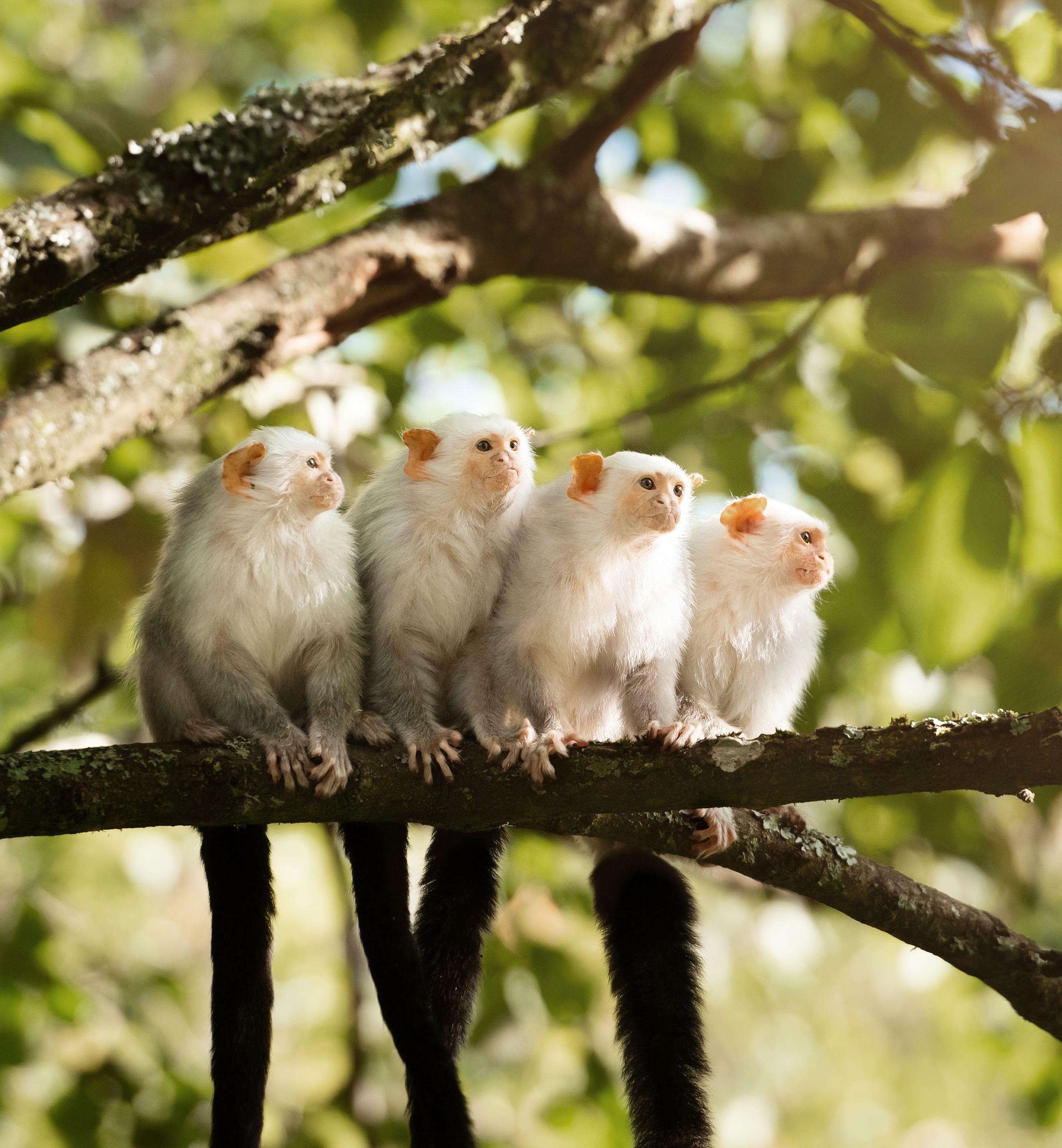
Durrell focuses on species that may be physically small, but punch above their weight and drive the restoration of ecosystems.
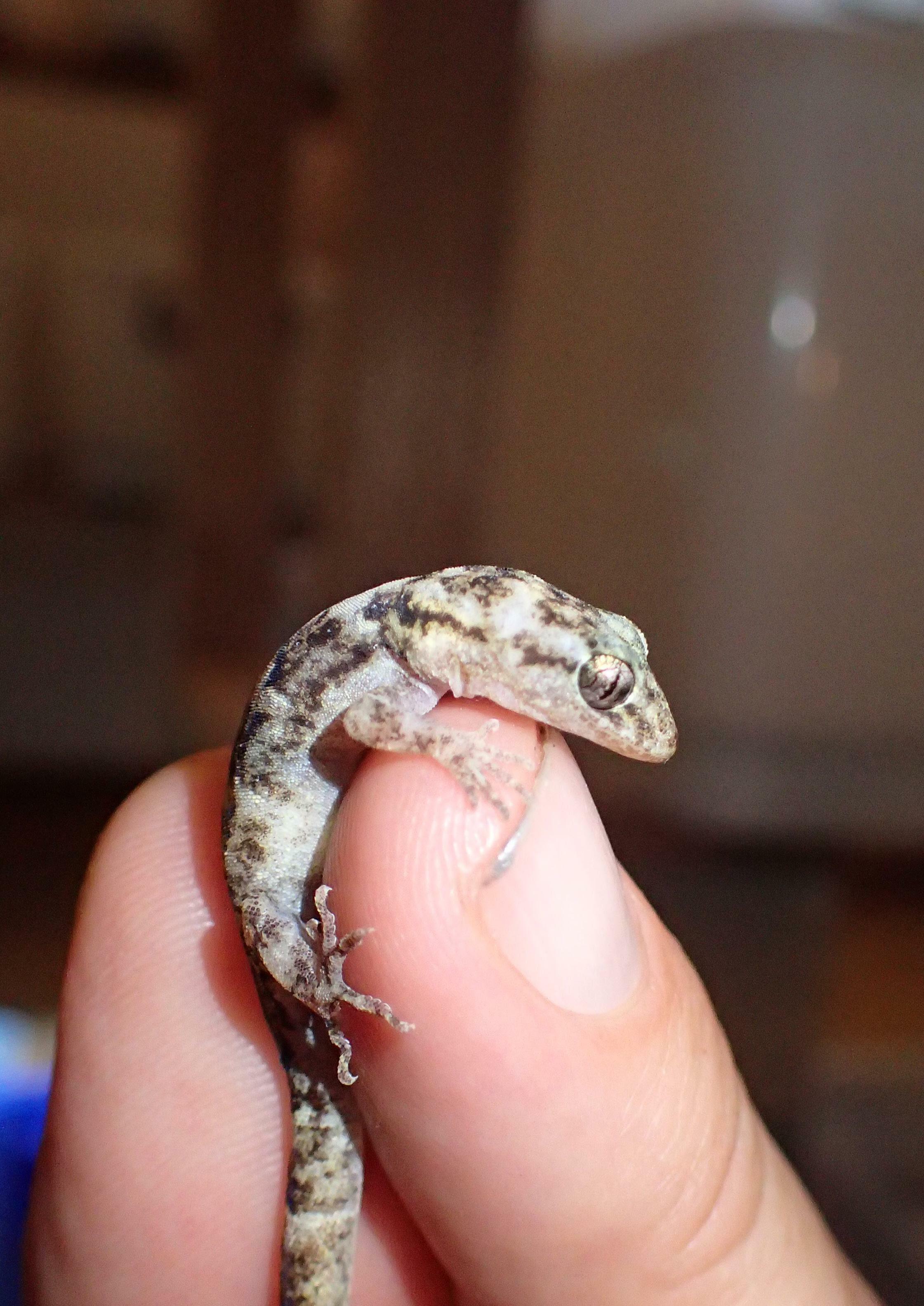
These elusive and lesser-known animals, fondly referred to as “little brown jobs” by Gerald Durrell, form a vital part of Durrell’s rewilding strategy to build resilience and diversity into landscapes.
Saving species means saving habitats, and these diminutive species are the building blocks of the ecosystems in which they live. They are the foundation for the future survival of our planet.
The world is as delicate and as complicated as a spider’s web. If you touch one thread you send shudders running through all the other threads. We are not just touching the web; we are tearing great holes in it.
GERALD DURRELLDurrell’s hands-on approach provides hope for these species on the brink that, without expert intervention, will be lost forever.
Saving the rarest snake in the world, with less than 50 left in the wild, is a race against time. There are risks when numbers are so perilously low, but doing nothing is not an option. Without help, this snake will silently go extinct, and the foundations of its ecosystem will start to crumble.
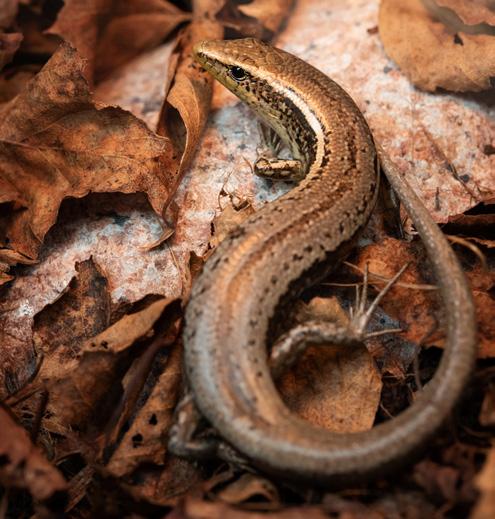
Your support can enable our pioneering breeding programme to bolster the population of this threatened snake, so that one day it can return to the wild.
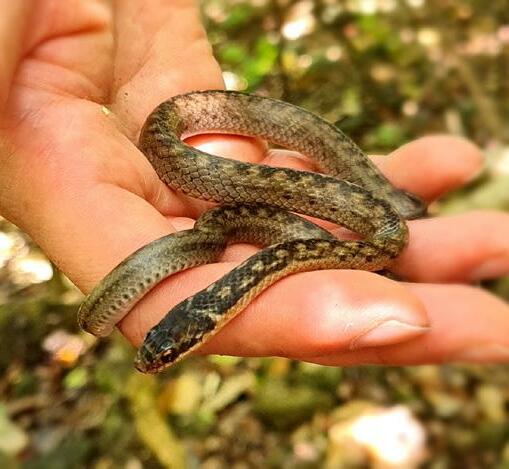
These giant frogs, a symbol of Montserrat, have been pushed to the brink of extinction by hunting, volcanic eruptions, and now a deadly fungal disease. But, thanks to Durrell’s cutting-edge approach, this species has a chance to survive.

Pioneering research must continue to give these frogs, and many other amphibians, a chance to fight back against this disease and thrive once again.
Durrell, alongside partners, rescued three reptile species from the offshore islands of Mauritius in the aftermath of an oil spill and brought them to the safety of Jersey Zoo. The quick action of front-line conservationists, combined with the expert care of the zoo’s reptile team, means the lesser night gecko, Bouton’s skink, and Bojer’s skink now have a breeding programme, ensuring the genetic variability found on the islands is not lost.
As Durrell continues to monitor the impacts of the oil spill, these precious reptiles must be cared for until it’s safe for them to return home.
Durrell’s passionate and dedicated team of experts care for the last strongholds of these rare and elusive animals, which can only survive with your support.
A gift from you today will be invested directly into front-line conservation. This is a unique opportunity to save the future of these small but mighty species.
£50 could provide nest boxes for mountain chicken frogs in their semi-wild enclosure in Montserrat.
£100 could enable effective outreach sessions in Montserrat and St Lucia to foster nature connection and empower communities
£280 could provide expert care for the rescued Mauritius reptiles for one week
£420 could run the Saint Lucia racer breeding facility for one month
to ethical
We provide a dedicated ethical, sustainable and impact investment management service for individuals, families, charities and trusts.
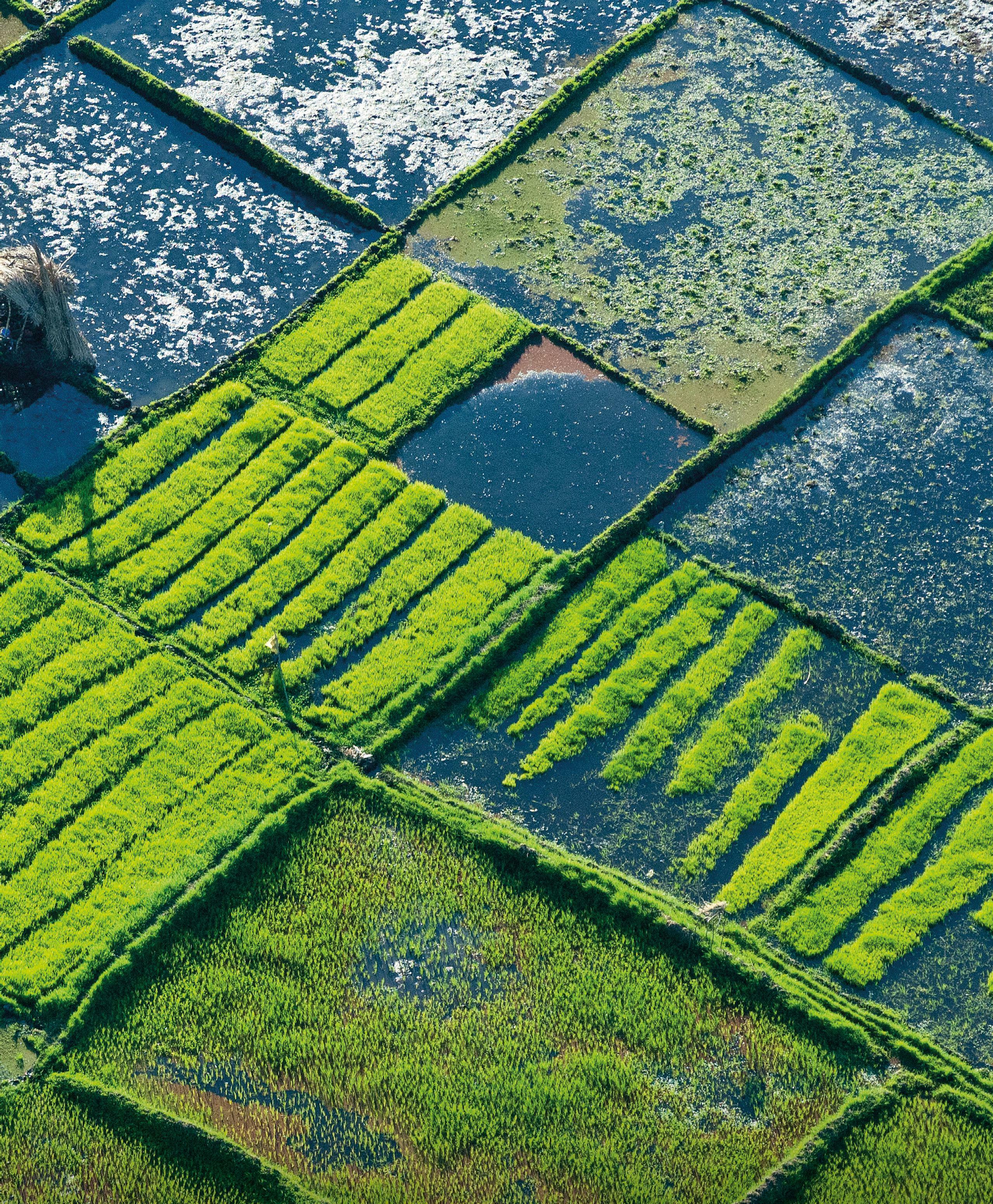
For more information on our services and to see examples of our engagement work on issues such as climate change, biodiversity and sustainable food systems, visit rathbonegreenbank.com
For more information, please contact us on: 0117 930 3000 or greenbank@rathbones.com
The value of investments and income arising from them may fall as well as rise and you might get back less than you originally invested.
Rathbone Greenbank Investments is a trading name of Rathbone Investment Management Limited, which is authorised by the Prudential Regulation Authority and regulated by the Financial Conduct Authority and the Prudential Regulation Authority.